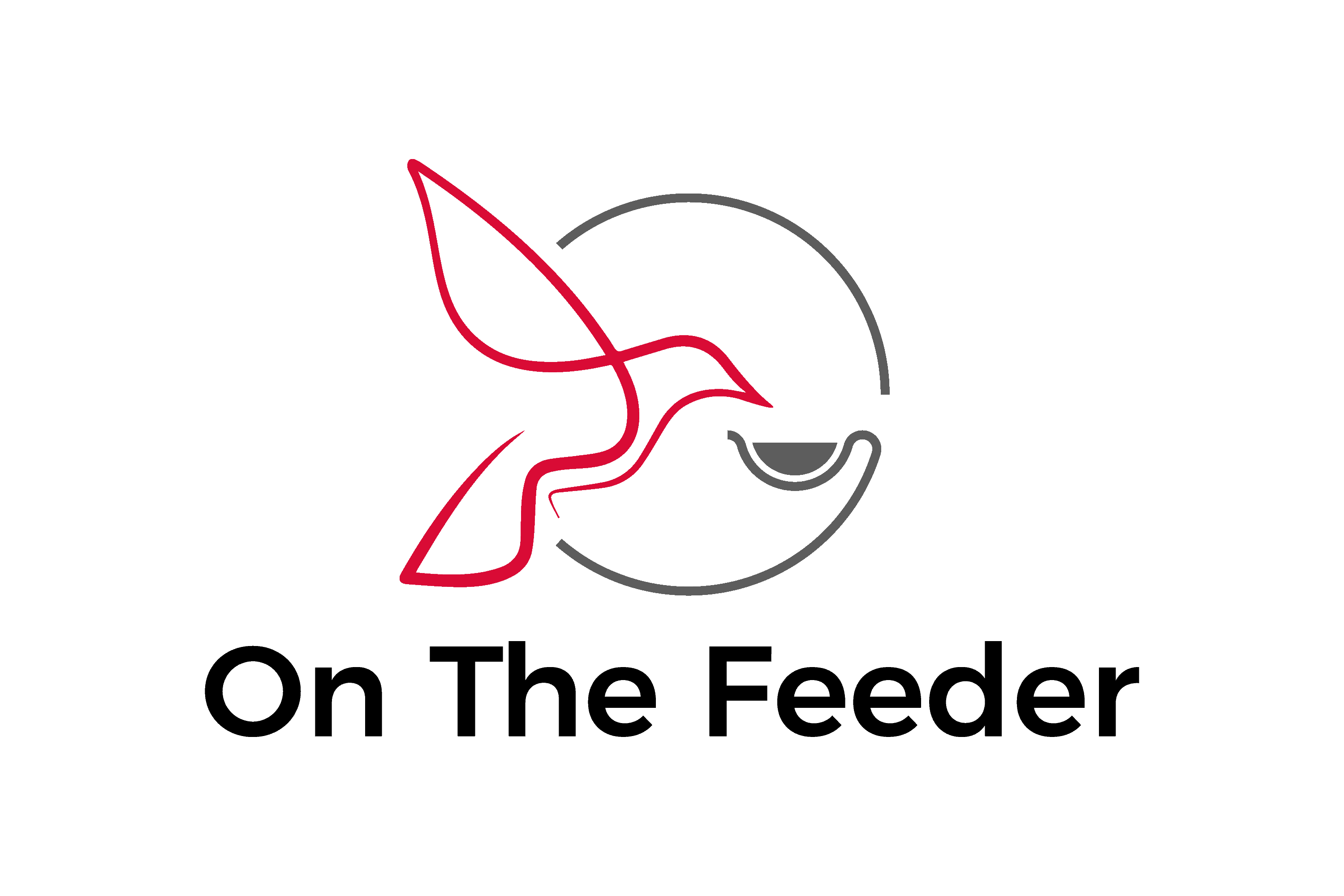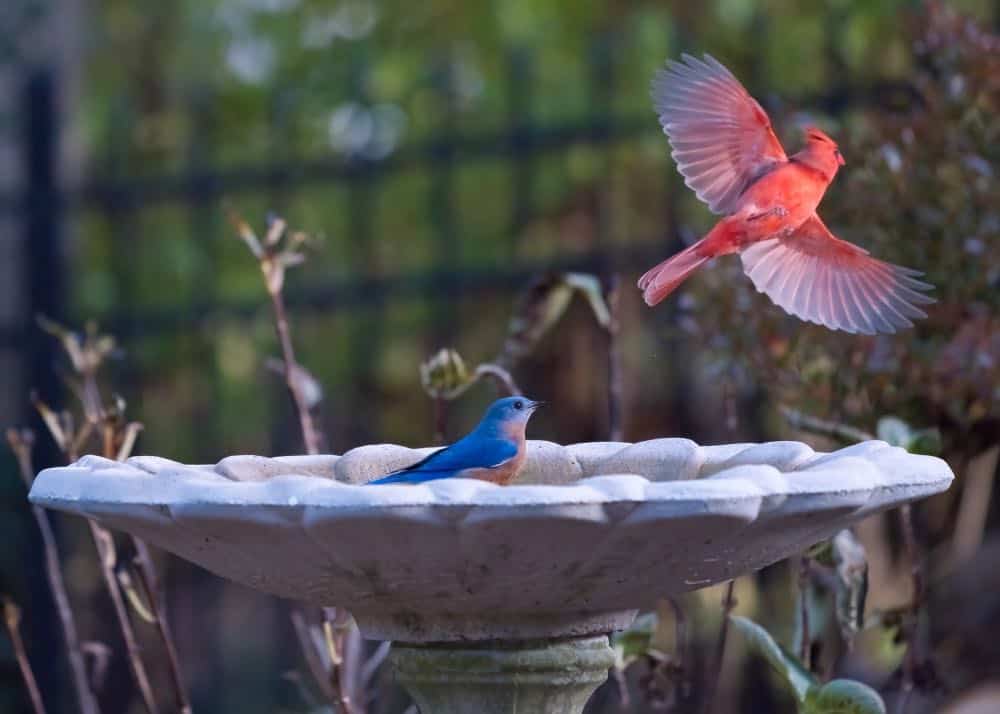Discover the 61 most common backyard bird species across the U.S. & Canada. These are the most common along with photos and descriptions of each. I’m sure you’ll recognize many of the birds on the list but some may surprise you.
Below are the 61 most common backyard bird species throughout the U.S. and Canada. The number in the parenthesis after the species name indicates the total number of regions (out of 6) that included the bird on their top 25 list.
- American Crow (5)
- American Goldfinch (5)
- American Robin (6)
- Anna’s Hummingbird (2)
- Bewick’s Wren (1)
- Black-billed Magpie (1)
- Black-capped Chickadee (5)
- Blue Jay (3)
- Bohemian Waxwing (1)
- Boreal Chickadee (1)
- Brown Thrasher (1)
- Brown-headed Cowbird (3)
- Bushtit (2)
- California Scrub-Jay (1)
- California Towhee (1)
- Canada Jay (1)
- Carolina Chickadee (3)
- Carolina Wren (2)
- Chestnut-backed Chickadee (2)
- Chipping Sparrow (2)
- Common Grackle (2)
- Common Raven (1)
- Common Redpoll (2)
- Dark-Eyed Junco (6)
- Downy Woodpecker (6)
- Eastern Bluebird (1)
- Eurasian Collared-Dove (2)
- European Starling (5)
- Fox Sparrow (1)
- Golden-crowned Sparrow (1)
- Hairy Woodpecker (4)
- Hoary Redpoll (1)
- House Finch (5)
- House Sparrow (5)
- Lesser Goldfinch (1)
- Mourning Dove (5)
- Northern Cardinal (3)
- Northern Flicker (3)
- Northern Mockingbird (1)
- Northern Shrike (1)
- Oak Titmouse (1)
- Pileated Woodpecker (1)
- Pine Grosbeak (1)
- Pine Siskin (3)
- Pine Warbler (1)
- Purple Finch (2)
- Red Crossbill (1)
- Red-bellied Woodpecker (3)
- Red-breasted Nuthatch (4)
- Red-winged Blackbird (3)
- Ruby-crowned Kinglet (1)
- Ruffed Grouse (1)
- Song Sparrow (2)
- Spotted Towhee (2)
- Steller’s Jay (2)
- Tufted Titmouse (3)
- Varied Thrush (2)
- White-breasted Nuthatch (4)
- White-crowned Sparrow (2)
- White-throated Sparrow (3)
- Yellow-rumped Warbler (2)
I’ve been backyard birding for more than 25 years in my Wisconsin backyard and totally geek out on data and birds. Put them together and I am in heaven!
Shortly I’ll provide photos of each common backyard bird to help you identify them when they visit your yard plus descriptions to further confirm the species. Range maps for each bird are also provided so you can know if they can be found in your area. Lastly, I provide diet information including the feeder food you can offer to entice them closer.
But first, where did the list of common backyard birds come from?
Where did The List of 61 Common Backyard Birds come from?
The list was compiled from data obtained from Project Feederwatch. Project Feederwatch is a Cornell Lab of Ornithology initiative that enlists the help of backyard birders to report the types and numbers of birds they see in and around their yards.
Unlike the name implies, the birds don’t need to be on feeders. In fact, you don’t even need a feeder to get involved. Anyway, each participant lives in one of 6 regions per the illustration below.
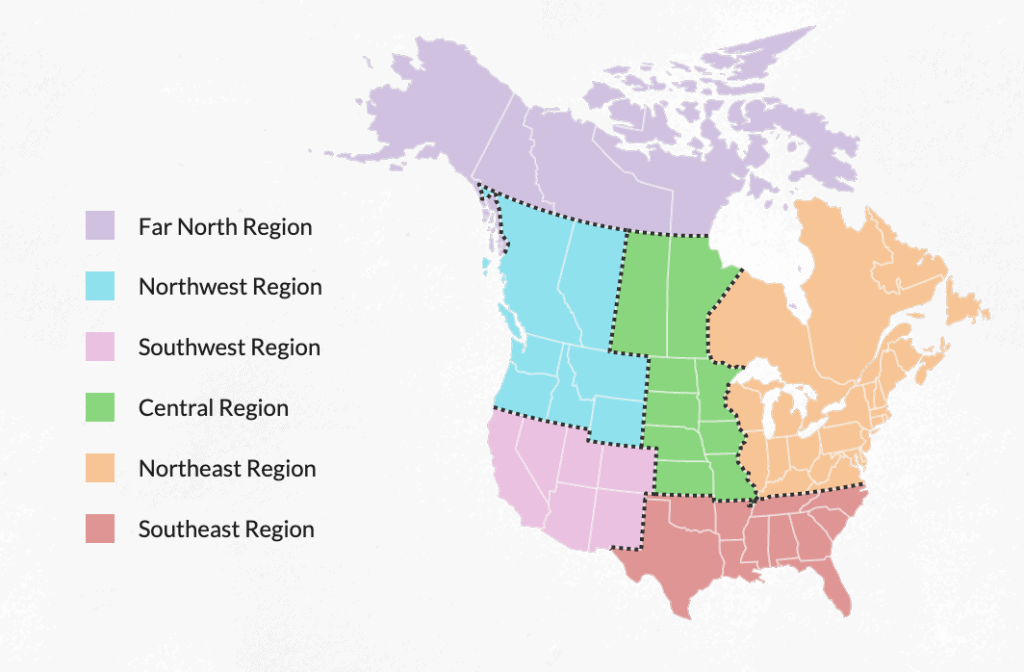
Each of the 6 regions has its own list of the top 25 common backyard birds. I combined all lists, removed duplicates, removed species with an abundance index <1, and voila! The list of 61 most common backyard birds was born.
Many birds, like the American Crow, American Robin, and American Goldfinch, make the top 25 list for several regions. Some birds, like the Boreal Chickadee and Northern Shrike, only make the list for one region – the Far North.
So, without further delay. Here are photos and details of the 61 most common backyard bird species, in alphabetical order:
American Crow
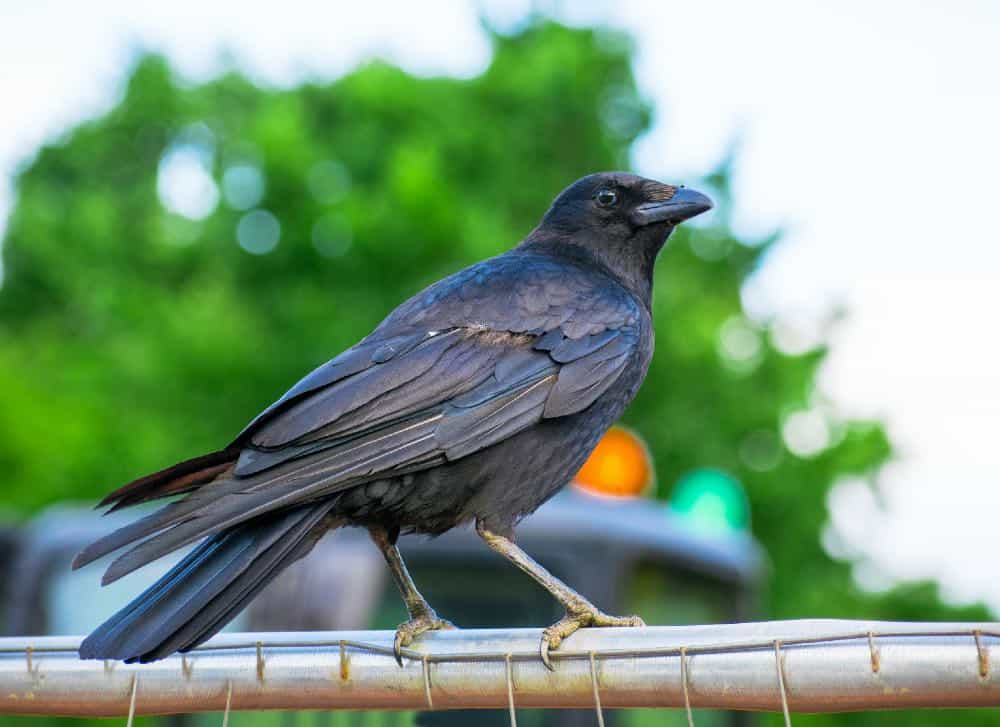
American crows are common backyard bird species.
Appearance: Large all-black bird about 16-20″ long, wide neck with a long straight bill. Males and females have the same appearance.
Diet: Opportunistic scavengers eat just about anything they can find on the ground – especially garbage. Natural living fare includes insects, spiders, frogs, snakes, and other birds’ eggs & young.
Feeder food: Not likely to visit a feeder.
Habitat: American crows are common birds found in every contiguous US state and most of Canada. Types of habitat include fields, open wooded and forested areas, river edges, shores, towns, cities, parks, and more. The only place you won’t find them is in the hot desert.
Nesting:
- Nest: Builds nests in a large shrub or tree as high as 20′
- Broods: 1-2 broods/season
- Clutch: 3-9 eggs per brood
- Egg color: Ranging from brighter blue-green to a dull green or blue-gray with heavy gray and brown blotching
- Egg size: 1.4 – 1.9 inches by 1 inch
- Incubation: Both parents incubate the eggs for about 18 days.
Migration: American crows are migrators.
Year-round range: The American crow’s year-round range includes every US state except North Dakota and the pacific coast of Canada’s British Columbia.
Breeding range: While some northern flickers remain in their year-round range to breed, many others migrate north into Canada to raise their young – but only for a season.
Winter range: American crows migrate south back to their year-round range for winter while some move further south to Nevada, Utah, New Mexico, and western Texas.
Range Map
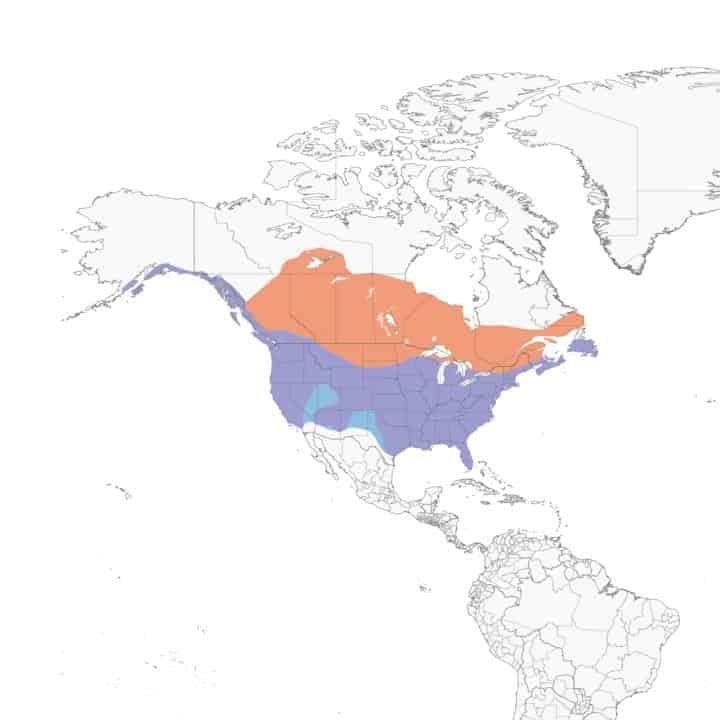
American Goldfinch
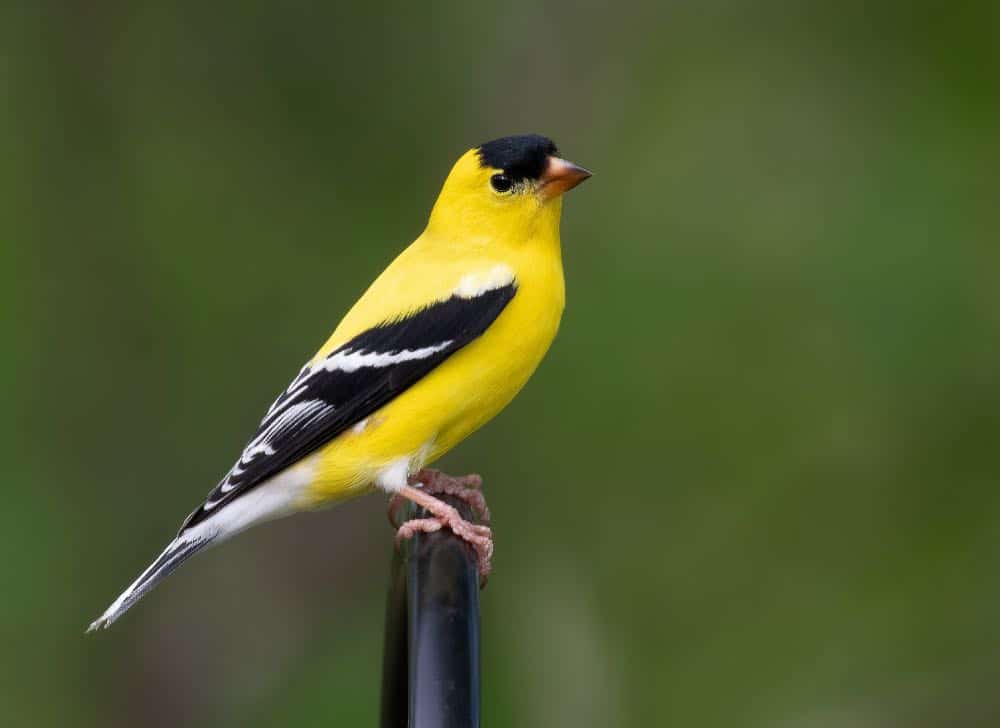
One of the most common backyard bird species across the continent is the American goldfinch.
Appearance: The American goldfinch is a small bird about 4.5″ long, bright yellow body, black wings with white stripes, a black forehead, short orange beak. During winter has a dingy brown body, duller yellow head, and thicker white stripes on its wings. Breeding females are similar to males except their bodies are lemon yellow and their wings have more white tips
Diet: Seeds from flowers, weeds, grasses, and small trees. Some insects.
Feeder food: Thistle seed (Nyjer)
Habitat: American goldfinch is a common bird throughout the contiguous US and southern part of Canada. Weedy fields, roadsides, orchards, and backyards.
Nesting:
- Nest: American goldfinches build their nest in a deciduous shrub or tree, sometimes conifers, placed on a branch’s fork as high as 20′.
- Broods: 1-2 broods/season
- Clutch: 2-7 eggs per brood
- Egg color: Very pale blue to white, occasionally faint brown spots on the larger end.
- Egg size: 0.5 inches by 0.5 inches
- Incubation: The female incubates the eggs for about 12-14 days while the male brings food to the female.
Migration: American goldfinches are partial migrators. Many remain in their year-round range for all seasons of the year while others migrate north to breed in spring and then migrate south for the winter.
Year-round range: Washington, Idaho, Oregon, Montana, Wyoming, Nevada, Utah, Colorado, Kansas, Nebraska, Oklahoma, and the remaining US states to the east and south (except Florida).
Breeding range: Northwest Washington, Montana, North Dakota, South Dakota, Kansas, northern Minnesota & Michigan, as well as the southern Canada provinces.
Winter range: Western Oregon, California, southern Nevada & Utah, Colorado, Arizona, New Mexico, Texas, southern Louisiana, Mississippi, Alabama, Georgia, South Carolina, and the state of Florida.
Range Map
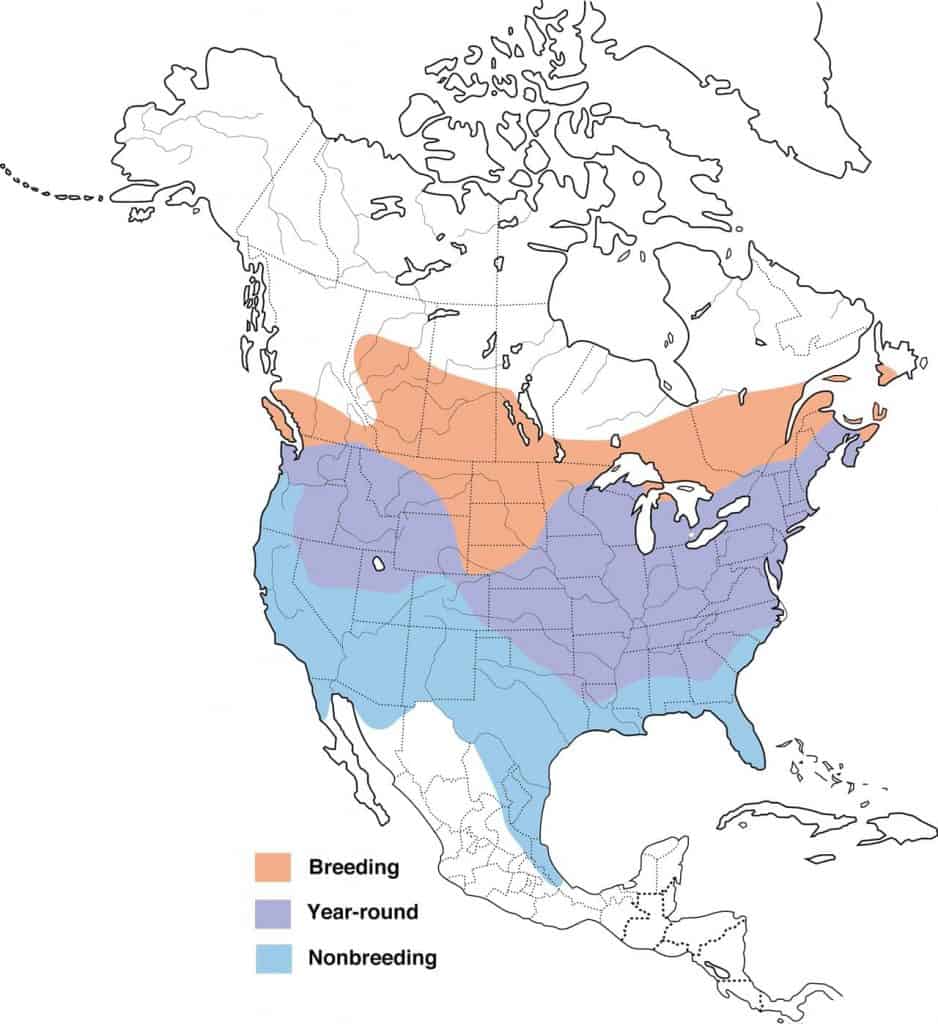
American Robin
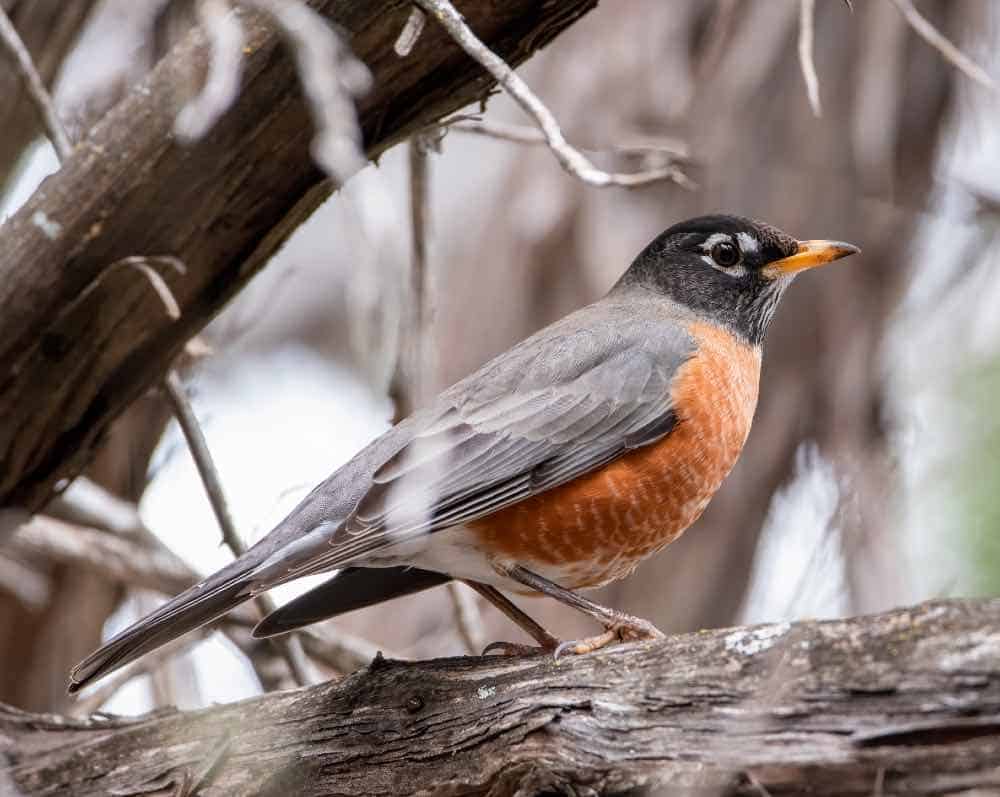
American robins are common backyard bird species.
Appearance: The American robin is a medium-size bird about 10″ long, with gray/brown upper, brown/orange underparts, yellow beak, white chin, and white surrounding eyes. orange beak. The Female has a lighter head and underparts.
Diet: Earthworms, insects, and fruit.
Feeder food: Not a feeder visitor.
Habitat: Common and pervasive throughout US and Canada. Found in fields, parks, wooded and forested areas, mountains, and backyards.
Nesting:
- Nest: Nesting sites vary from the lower half of a tree to rain gutters, outdoor lights, and more.
- Broods: 1-3 broods/season,
- Clutch: 3-5 eggs/brood,
- Egg color: Bright sky blue or blue-green, without spots
- Egg size: 1.1″ long x 8″ wide
- Incubation: 12-14 days.
Migration: American robins are migrators.
Year-round range: Every US state except North Dakota, southern parts of Canada’s British Columbia, and Alberta, as well as Mexico.
Breeding range: Canada and Alaska.
Winter range: While most American robins head south back to the year-round range, others will go further into the far southern parts of Florida, California, Arizona, New Mexico, Texas, Louisiana, and Mexico.
Range Map
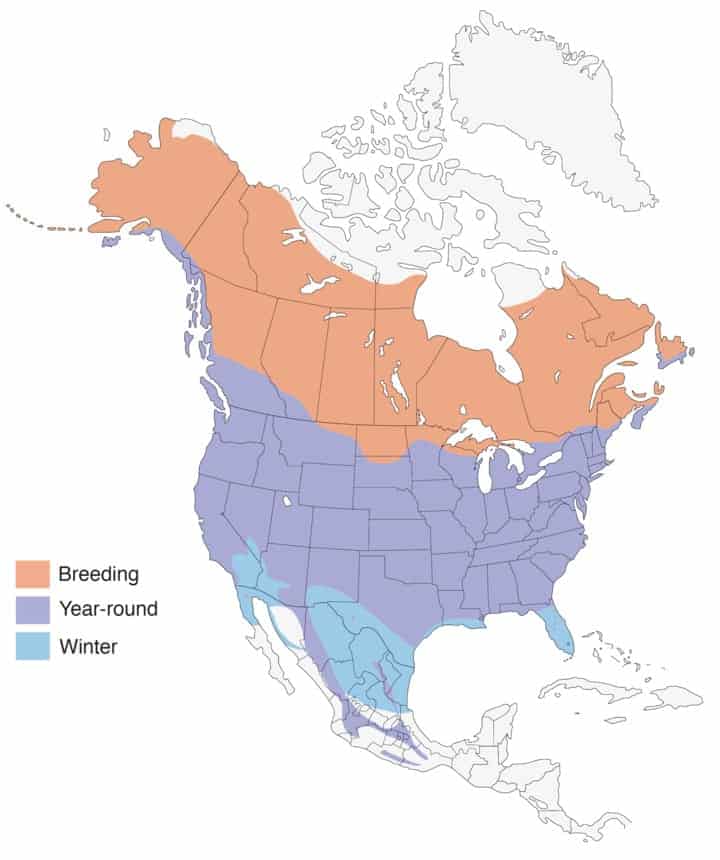
Anna’s Hummingbird
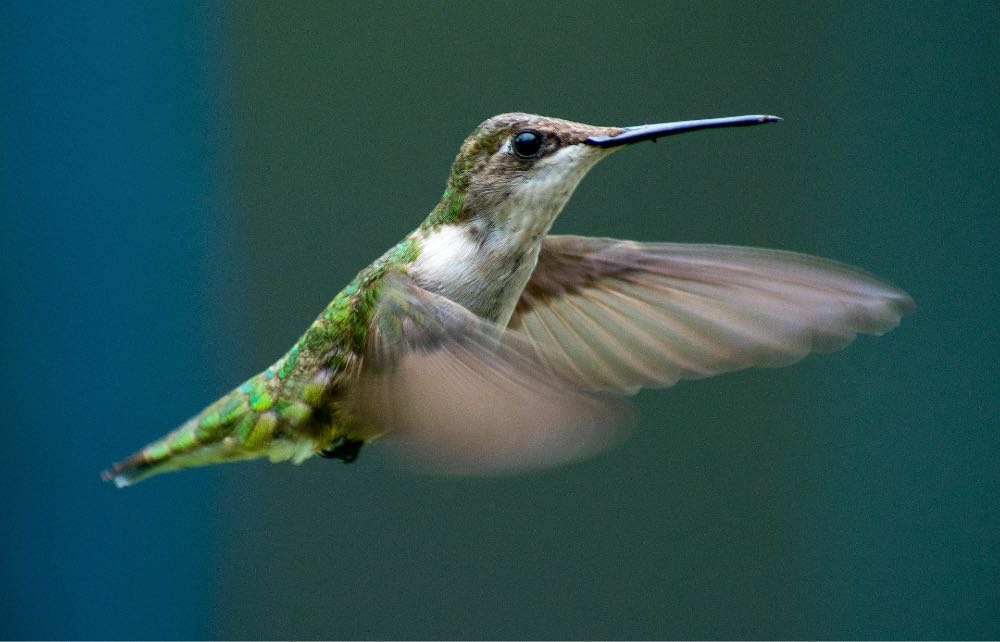
Anna’s hummingbirds are common backyard bird species – at least they are on the west coast.
Appearance: Anna’s hummingbird is a tiny 4″ long bird. They have metallic green upperparts and gray/white & green bellies. Males have a brilliant rose-red gorget and crown with a black tail. Females have a white throat with green spots and red spots in the center. Her tail has a white tip.
Diet: Flower nectar, small insects, and spiders.
Feeder food: Sugar-water (nectar).
Habitat: This hummer lives along riverbanks with thick shrubs, coastal and non-coastal scrubland areas, backyard gardens, and city parks.
Nesting: The nest is placed in a tree or shrub about 4-30′ up. It’s constructed of plant down and spider webs. They have 2 eggs and incubate for about 14-19 days. Fledglings leave the nest at about 18-23 days.
Migration: Anna’s hummingbirds are not migrators. Most of them remain in their year-round range along the Pacific Northwest coast from southern British Columbia to southern California. That said, some may expand to southern Oregon and northern California during the breeding season, and north into central and northern British Columbia coast during winter.
Range Map
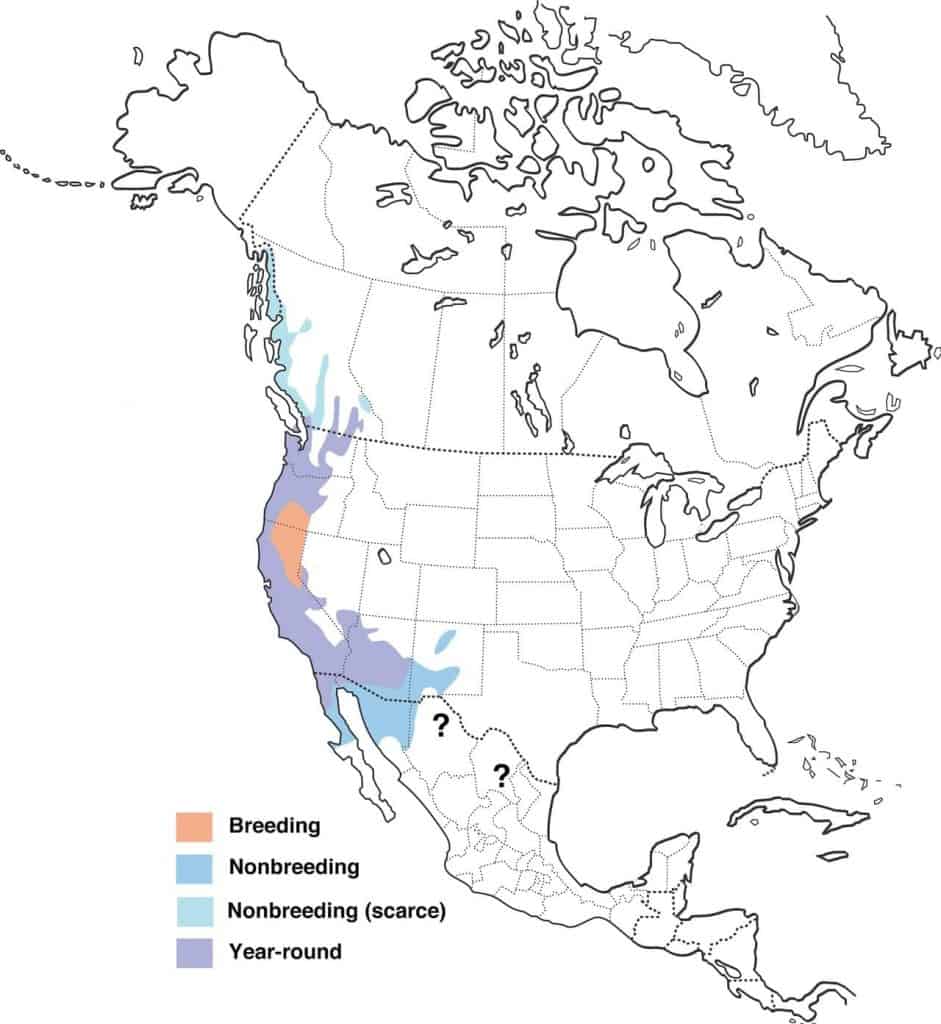
Bewick’s Wren
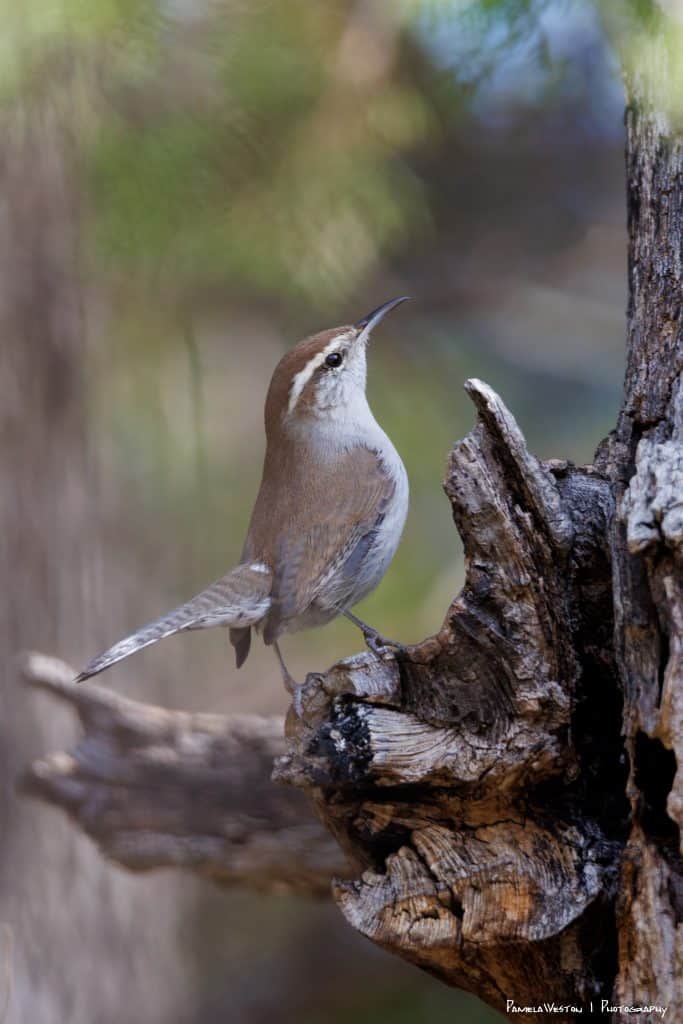
Bewick’s wrens are common backyard bird species in their range.
Appearance: The Bewick’s wren is a small bird about 5.25″ long. They’re slender with a long tail, usually cocked upward and twitching from one side to the other. In the southwest part of their range the upper parts are gray/brown, along the Pacific coast they’re brown, and reddish brown for those that live in the eastern part of the range. Underneath they’re soft gray. They also have a bold white stripe above the eye and white bars near the tip of the tail.
Diet: Insects and spiders that they uncover from bark crevices. In the winter they’re open to eating seeds, fruit, and other plant matter.
Feeder food: Hulled sunflower seeds, suet, peanut hearts, and mealworms.
Habitat: Bewick’s wrens prefer brushy woodlands, coast and desert scrub, chaparral (scrubland plant communities of deciduous shrubs and trees 8′ or under), backyards, and parks.
Nesting: Nest placement can be on the ground in a rocky crevice, an old woodpecker cavity, or on a ledge less than 30′ up. They build a cup-shaped nest from sticks, grasses, and other dried vegetation. They have 1-3 broods/year, about 5-7 white eggs with red/brown spots per brood, incubate for 14-16 days and fledglings leave the nest at about 14-16 days.
Migration: Bewick’s wrens are not migrators. They live in their year-round range including Washington, Oregon, California, Nevada, Utah, Arizona, Colorado, New Mexico, Texas, Kansas, Oklahoma, Arkansas, and Missouri. In Canada, they can be found in the southwest corner of British Columbia.
While they’re not migrators, small populations expand to the eastern parts of Washington and California. During the breeding season, a small population expands further north and east of the year-round range.
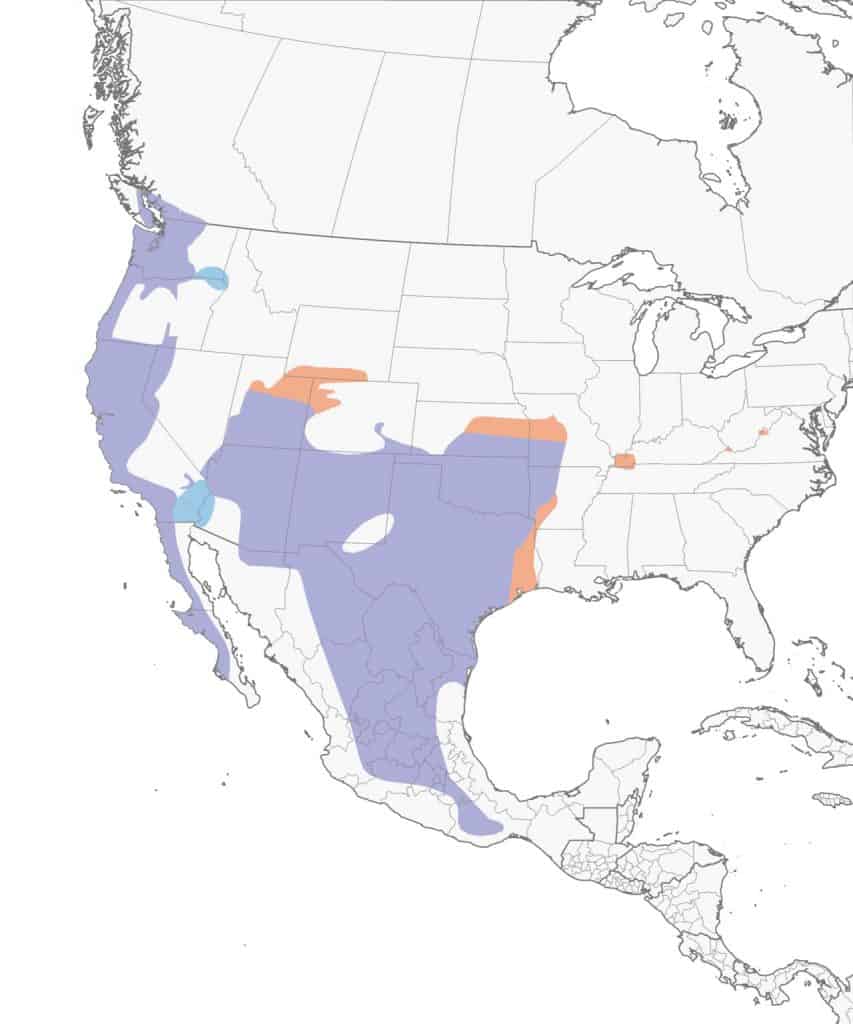
Black-billed Magpie
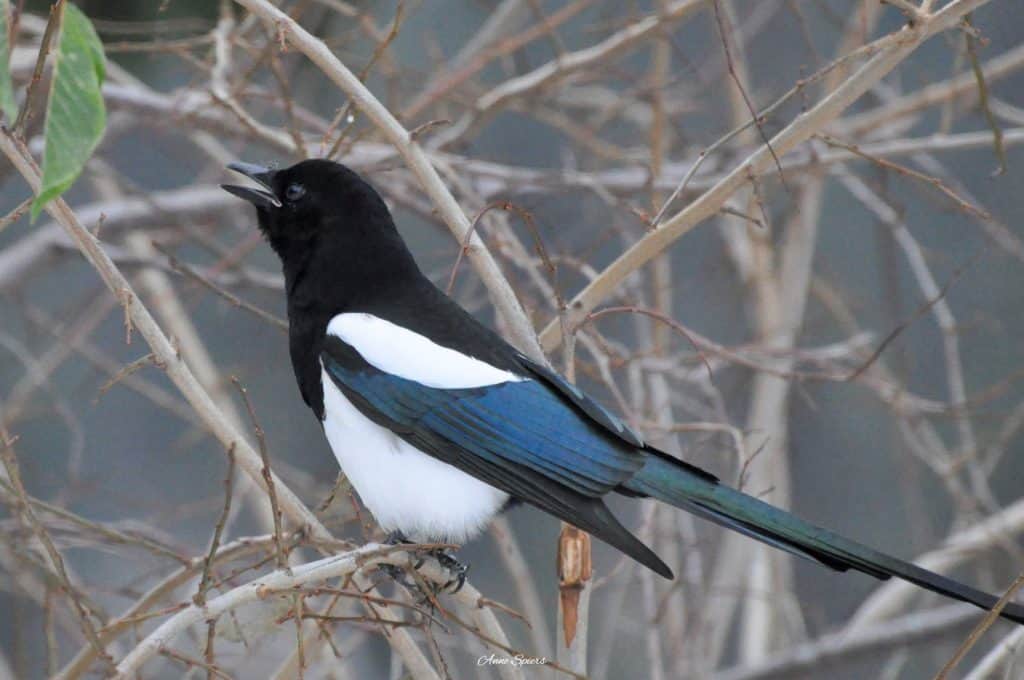
Black-billed magpies are common backyard bird species throughout the western half of the continent.
Appearance: Black-billed magpies are large birds about 19″ long. They have black bodies with glossy blue, green & violet highlights on the wings, white bellies, white shoulders, and very long tails.
Diet: This bird is an omnivore. They’ll eat animal matter from just about anywhere – carrion, human trash, roadkill, baby birds, and even other birds’ eggs. Will also eat fruit and grains.
Feeder food: Suet, black-oil sunflower seed, hulled sunflower seeds, cracked corn, peanuts, fruit, millet, milo.
Habitat: This bird prefers open woodlands, forest edges, and scrublands. They’re frequent backyard visitors as well as city parks.
Nesting: They nest in a tree or tall shrub. Nests are large and bulky made of sticks and lined with mud, dung, and animal hair. They have 1 brood/year and about 6-7 tan or olive-green eggs/brood. Incubation lasts 18 days and fledglings leave the nest at about 22-29 days.
Migration: Black-billed magpies are not migrators. Their year-round range includes southern Alaska, Yukon Territory, Canada’s southern provinces, and the northwestern and central parts of the U.S.
Range Map
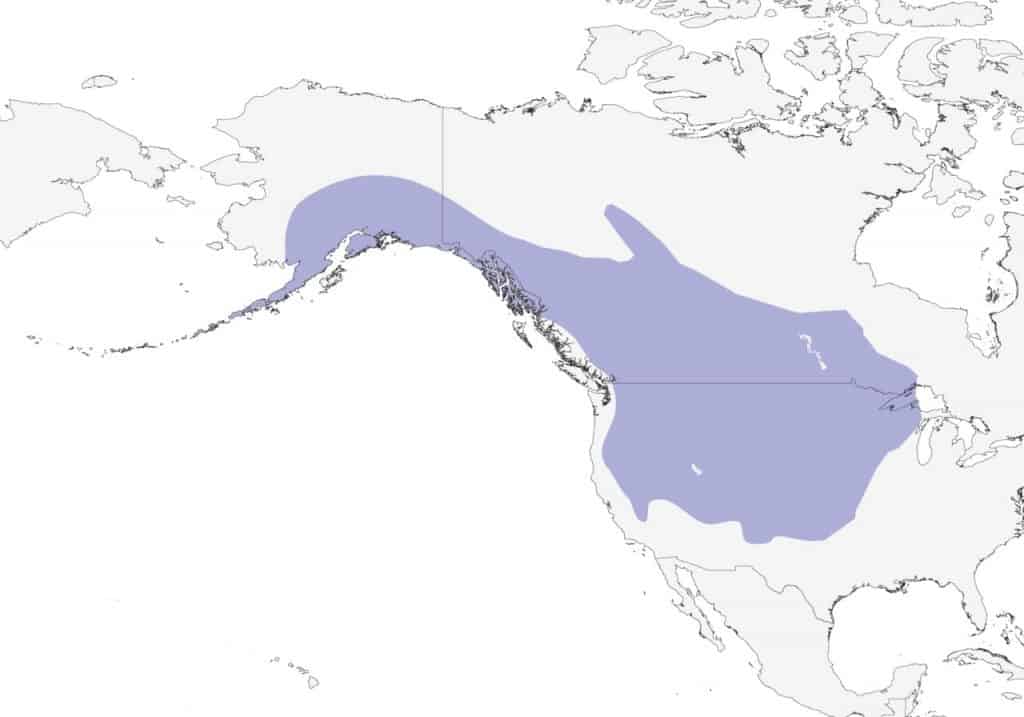
Black-capped Chickadee
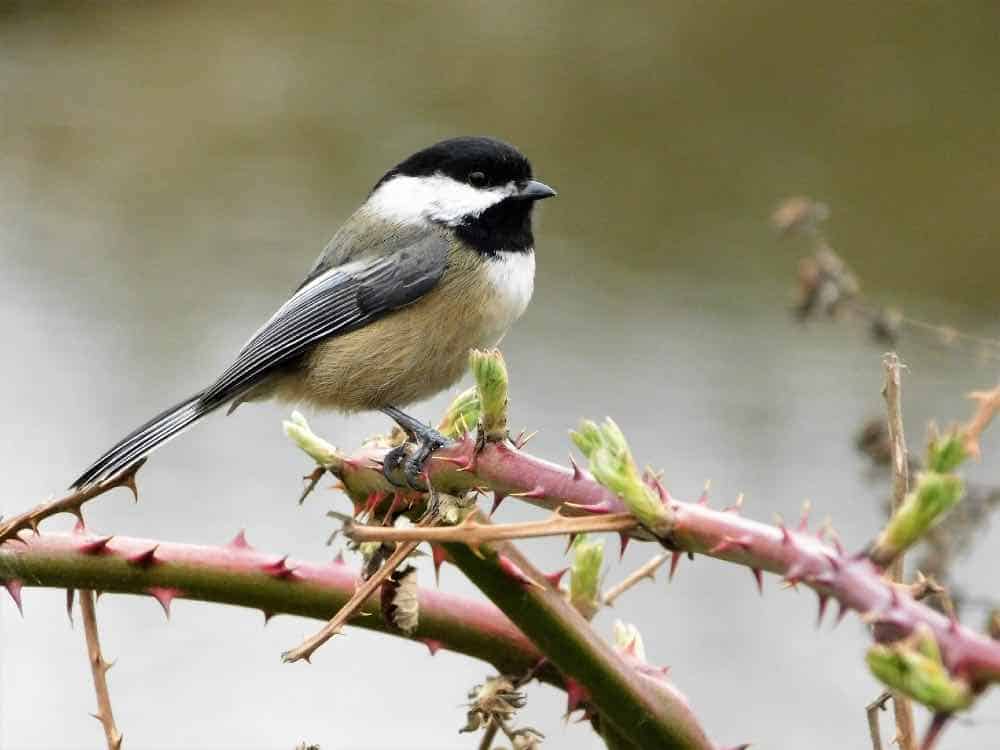
Black-capped chickadees are common backyard bird species.
Appearance: Black-capped chickadees are common backyard bird species. They’re small birds about 5 1/4″ long. They have a black cap – as well as a black throat and cheek. They have a white breasts and bellies, the body and wings are a gray-olive color with edges of white and the wing/belly edge is a soft “buff” tan.
During the summer, the buff area is more faded.
Diet: Insects & spiders (including their eggs & pupae), seeds, and small fruits, and berries.
Feeder food: Black-oil sunflower & safflower seeds (They peck a hole in the shell to get at the tiny seed bits inside), suet, peanut butter, and hulled peanuts.
Habitat: You’ll find this bird along the edges of forests and open wooded areas – including your backyard or even tree-lined parks in the city. They will also hang out in shrubs and willow thickets. Trees are still important for this bird because they are cavity nesters.
Did you know? Chickadees are often associated with happiness and optimism. When you see one, it might be a reminder to maintain a positive outlook and focus on the bright side of life. This can help you attract more positive experiences and opportunities.
Nesting: Will next in an existing woodpecker hole high in a tree or man-made nesting box. They have 1 brood /season. The female lays anywhere from 1-13 eggs. Eggs are white with burgundy colored spots and about .5″ wide x .6″ long. She will incubate them for 12-13 days.
Migration: Black-capped chickadees are not migrators. They remain in their year-round range all seasons of the year.
Year-round range: Northern half of the US including Alaska, as well as all Canadian provinces except Nunavut.
Range Map
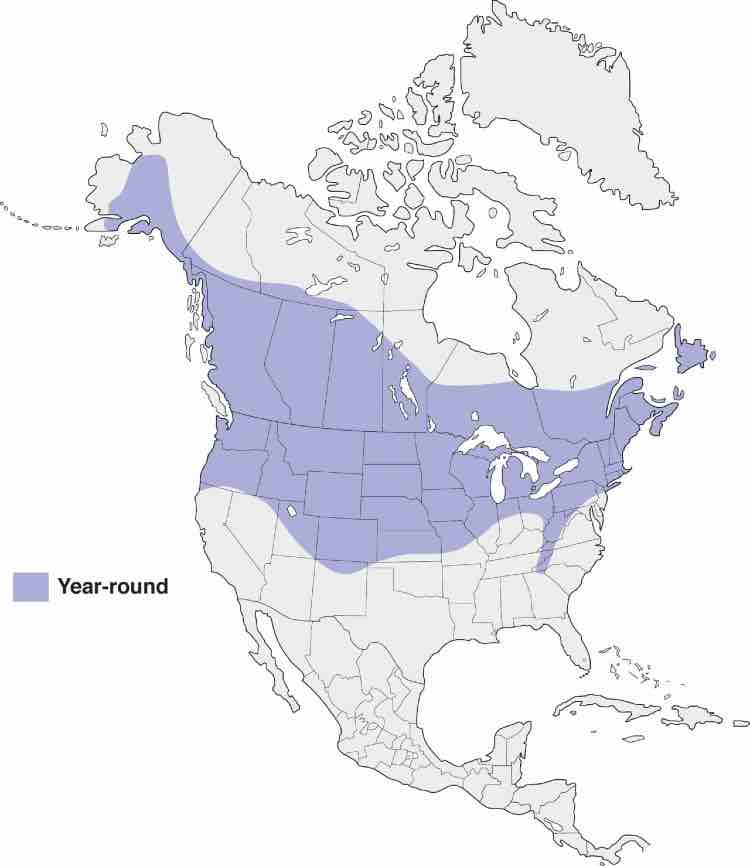
Blue Jay
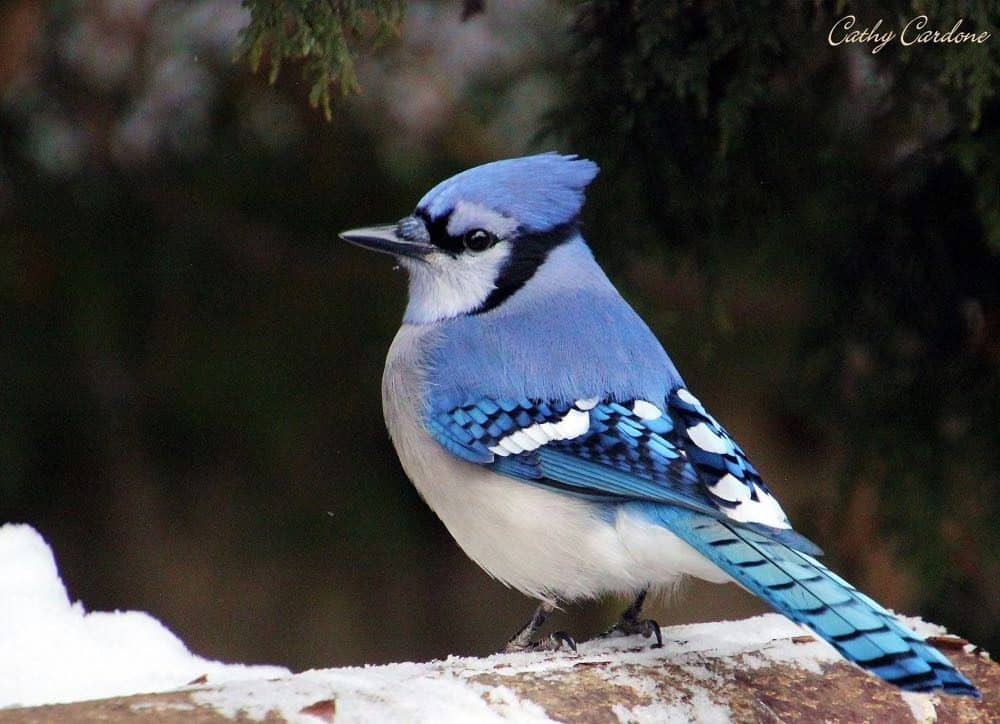
Blue jays are common backyard bird species within their range.
Appearance: Large bird 12″ long, medium blue & white body, blue crest (which he flattens at will), gray belly, and white face. White & blue wings with black spots. Females look the same.
Diet: Insects, fruit, seeds, nuts, other birds’ eggs, and nestlings.
Feeder food: Whole peanuts, sunflower seeds, and cracked corn.
Habitat: Forested areas with mixed tree types. Also common in suburbs and urban areas.
Nesting:
- Nest: bulky large nest made from twigs, bark, and mud resting on a tree branch about 5-50′ up.
- Broods: 1-2 broods/season,
- Clutch: 2-7 eggs/brood,
- Egg color: Pale blue to a light brown base color, and these eggs usually have brown or gray spots.
- Egg size: 1 inch by just under 1 inch
- Incubation: Both parents incubate the eggs for 17-18 days and the young fledge between 17-21 days.
Migration: In general, blue jays are not migrators. They remain in their year-round range for all 4 seasons – even during the breeding season. While they may move within their year-round range, they do not regularly head north for breeding and south for winter as some species do. That said, in rare cases, some will head west of their year-round range for the winter.
Range Map
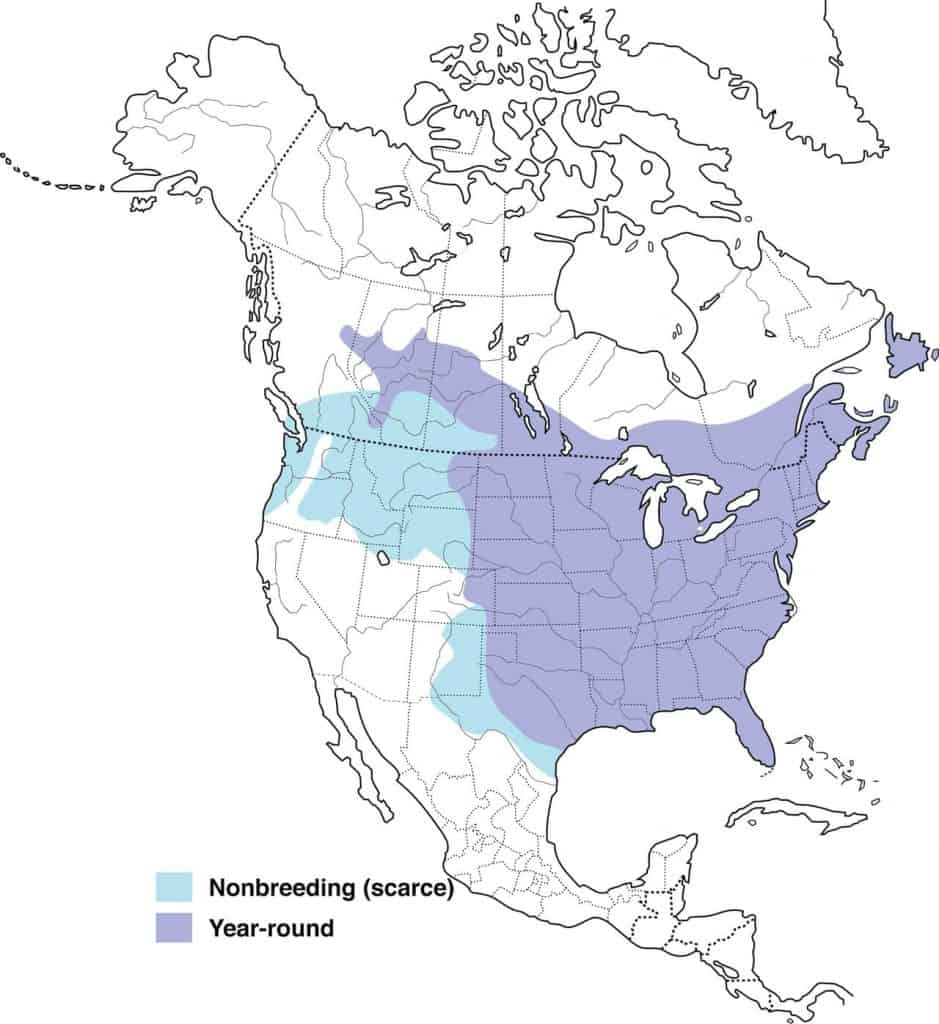
Bohemian Waxwing
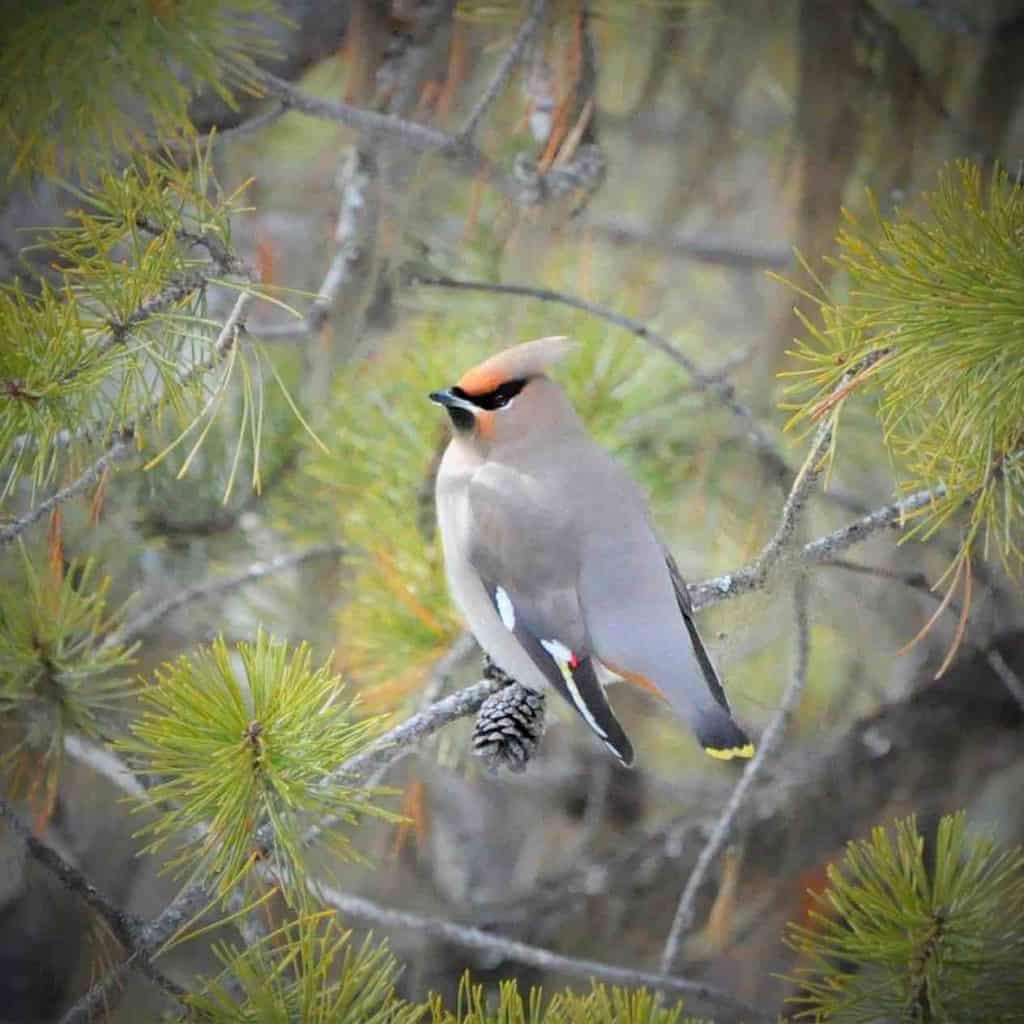
While not everyone would consider the Bohemian waxwings common backyard bird species, those in the northwest sure would!
Appearance: They’re medium-sized birds about 7″ long. They’re sturdy birds with black masks, thick necks, and fluffy crests. Their coloring is gray/brown overall with peach around the mask, white patches on the wings and beak, rusty underneath, and a yellow tip on the tail. The females look similar.
Diet: Insect and fruit.
Feeder food: Fruit
Habitat: Open forested areas often by water sources (lakes, ponds, streams). Also found in urban areas, backyards, roadsides, and parks.
Nesting: The cup-shaped nest is placed on the horizontal branch of an aspen, alder, or evergreen tree. They have 1 brood/year, 2-6 pale blue/gray black spotted eggs, and incubate for 13-14 days. Fledglings leave the nest after 15-18 days.
Migration: Bohemian waxwings are migrators. While they inhabit a year-round area in central British Columbia and west central Alberta, they migrate north to Alaska, Yukon Territories, northern British Columbia, and Alberta for breeding. Then in the fall-winter, they migrate south and east to Washington, Oregon, Idaho, Montana, Wyoming, Utah, Colorado, North Dakota, Minnesota, Wisconsin, Michigan, New England, southern Ontario, and eastern Quebec.
Range Map
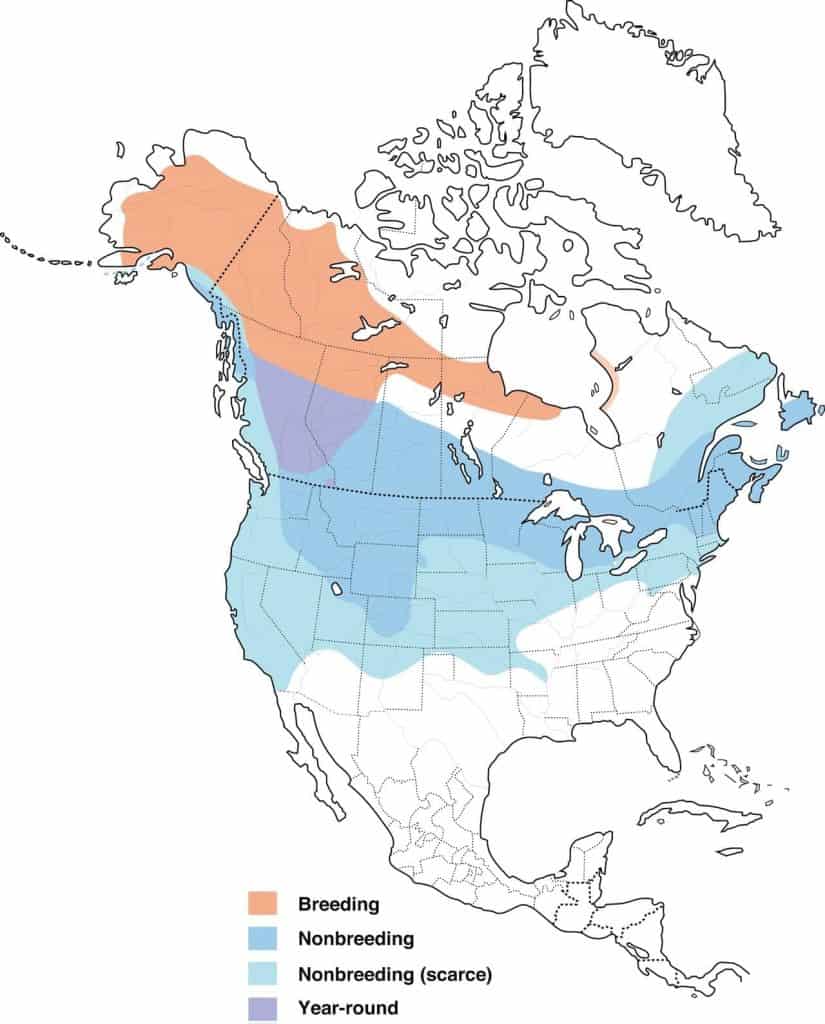
Boreal Chickadee
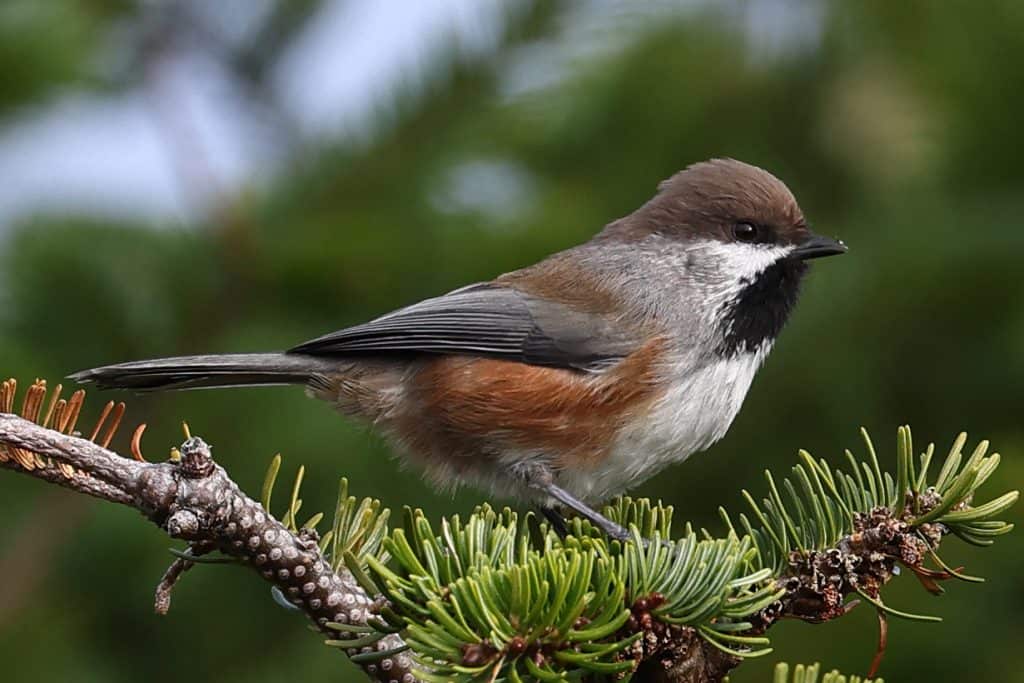
Boreal chickadees are common backyard bird species throughout Alaska and Canada.
Appearance: The Boreal chickadee is a small stocky bird with a narrow, long tail. They’re gray/brown with a chocolate brown cap, black bib, white patch on the cheek, and white underneath with peachy buff sides. The females look the same.
Diet: Seeds and insects.
Feeder food: Black oil sunflower seed, hulled sunflower seeds, safflower, nyjer, suet, peanuts, shelled peanuts, mealworms.
Habitat: This bird lives among older coniferous forested areas. They prefer to be near water. In northern regions, they can be found in mixed forests.
Nesting: Boreal chickadees are cavity nesters. They usually excavate the cavity in a dead fir, spruce, or pine tree (or choice deciduous trees). They have 1 brood/year, 4-9 creamy white eggs with red/brown spots and incubation is for about 14-17 days.
Migration: Boreal chickadees are not migrators. They remain in their year-round range all seasons of the year. This includes most of Canada, Alaska, northern Minnesota, Wisconsin & Michigan, and New England states.
Range Map
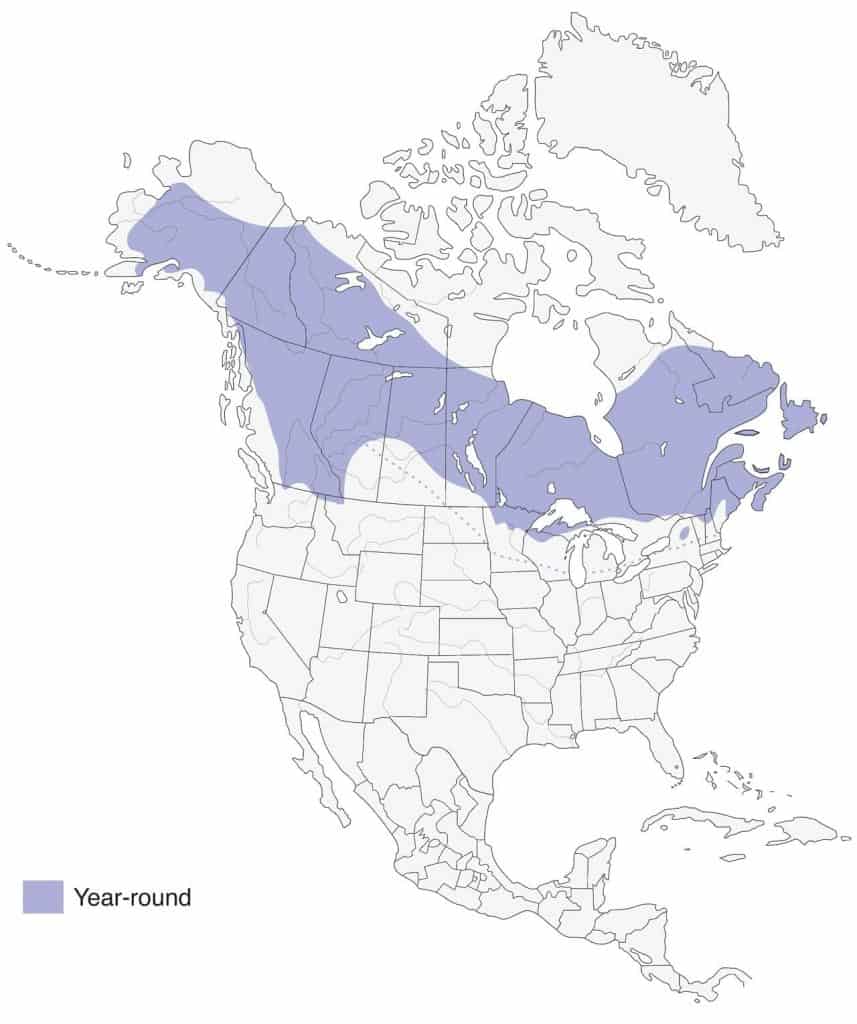
Brown Thrasher
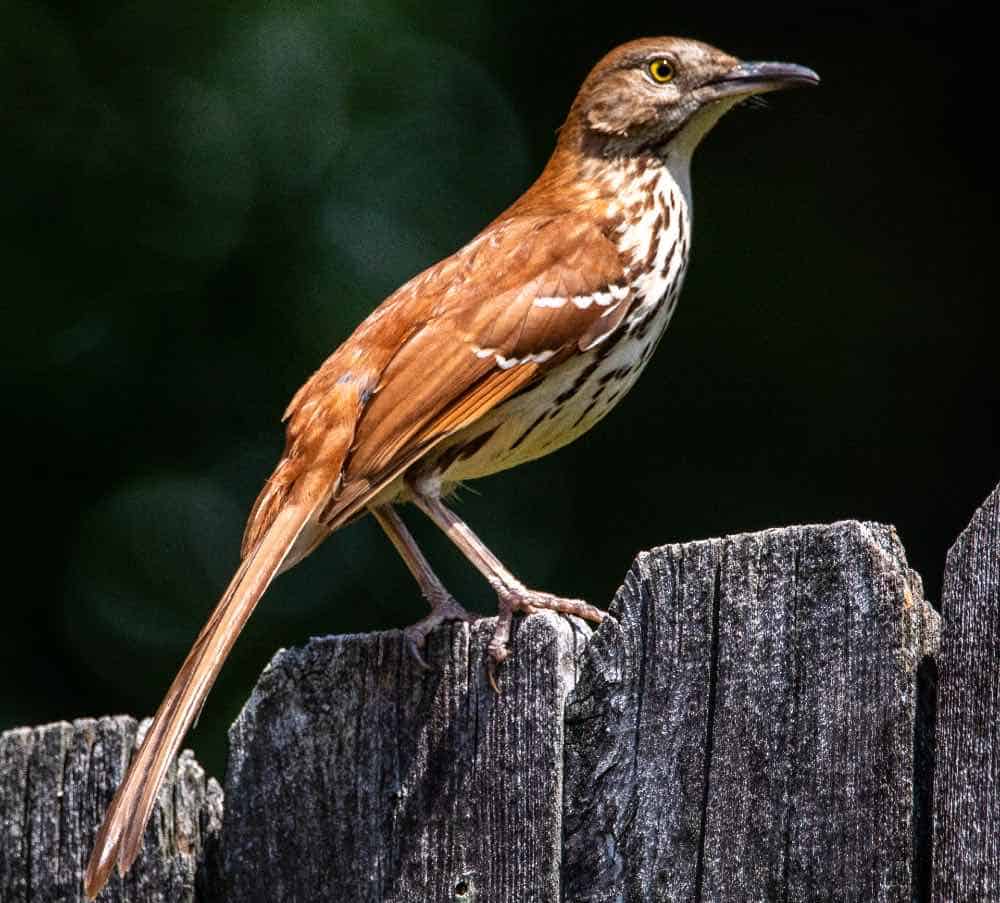
Brown thrashers are common backyard bird species on the eastern part of the U.S.
| Appearance | Large rusty-red bird about 11″ long. Long, thin tail, heavily streaked chest and belly. Long curved bill and bright yellow eyes. Also has two white wing bars. |
| Diet | Insects and fruit. |
| Feeder Food | Not a common feeder bird but may stop to dine on fallen seeds. |
| Habitat | Thick shrubs, wooded edges, and hedgerows in the east. In the western part of the range, they can be found living in tree lines, fence rows, and woodlands. |
| Nesting | Bulky cup-shaped nest about 3.5″ in diameter located low in a thorny shrub or tree. They have about two broods per year, 4-5 pale blue 1″ eggs with brown markings. |
Range Map
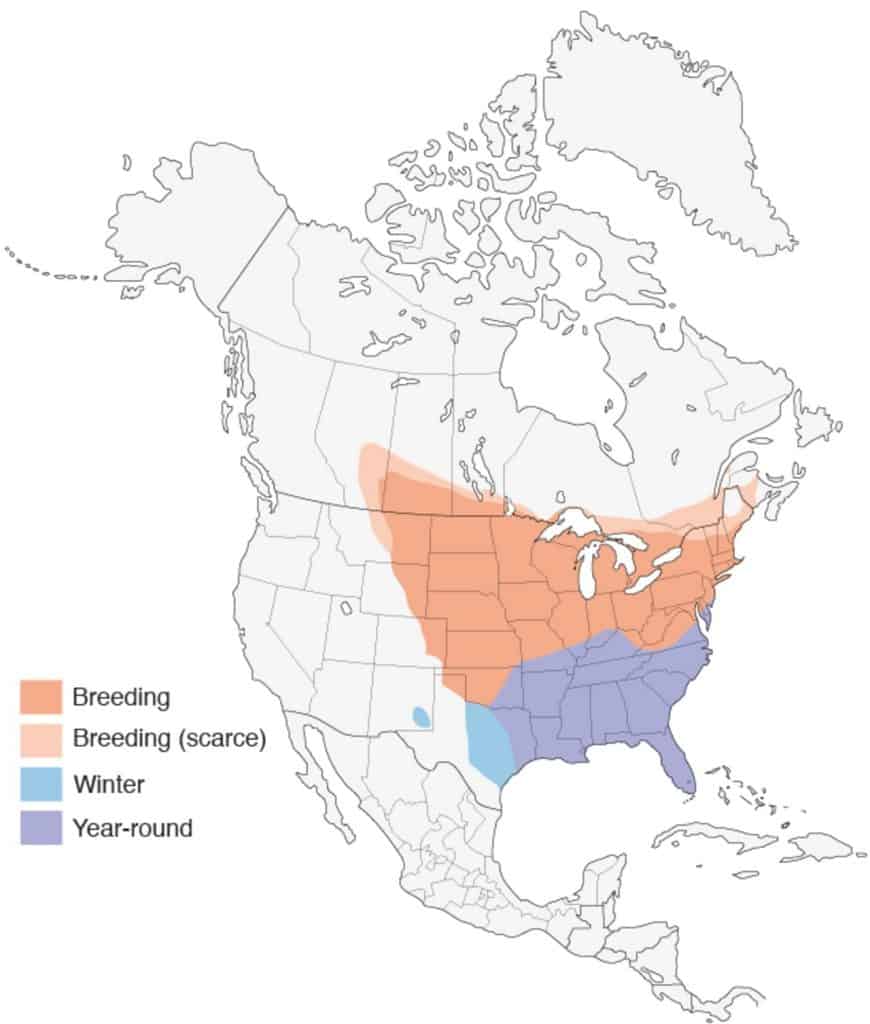
Brown-headed Cowbird
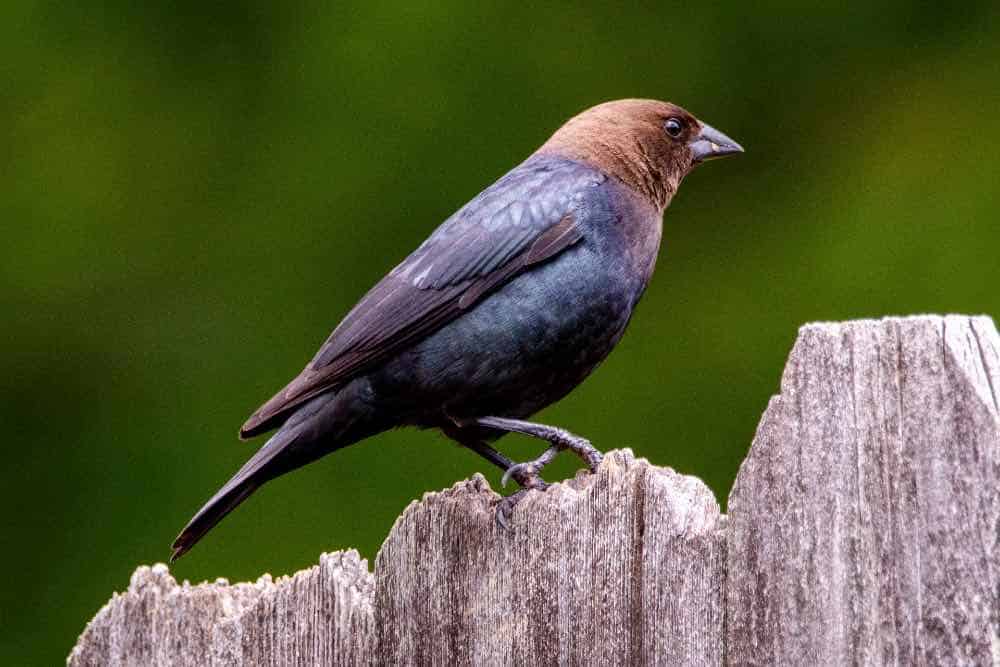
Brown-headed cowbirds are common backyard bird species.
| Appearance | Medium-sized bird about 7 1/2″ long. The male is a glossy black with a chocolate brown head with a long pointed gray bill. The female is a dull brownish-gray. |
| Diet | Insects and seeds. |
| Feeder Food | Mixed birdseed. |
| Habitat | Thick shrubs, wooded edges, and hedgerows in the east. In the western part of the range, they can be found living in tree lines, fence rows, and woodlands. |
| Nesting | Brown-headed cowbirds don’t build nests. They lay about 5-7 white eggs with brown markings in other birds’ nests to incubate and raise the young. |
Range Map
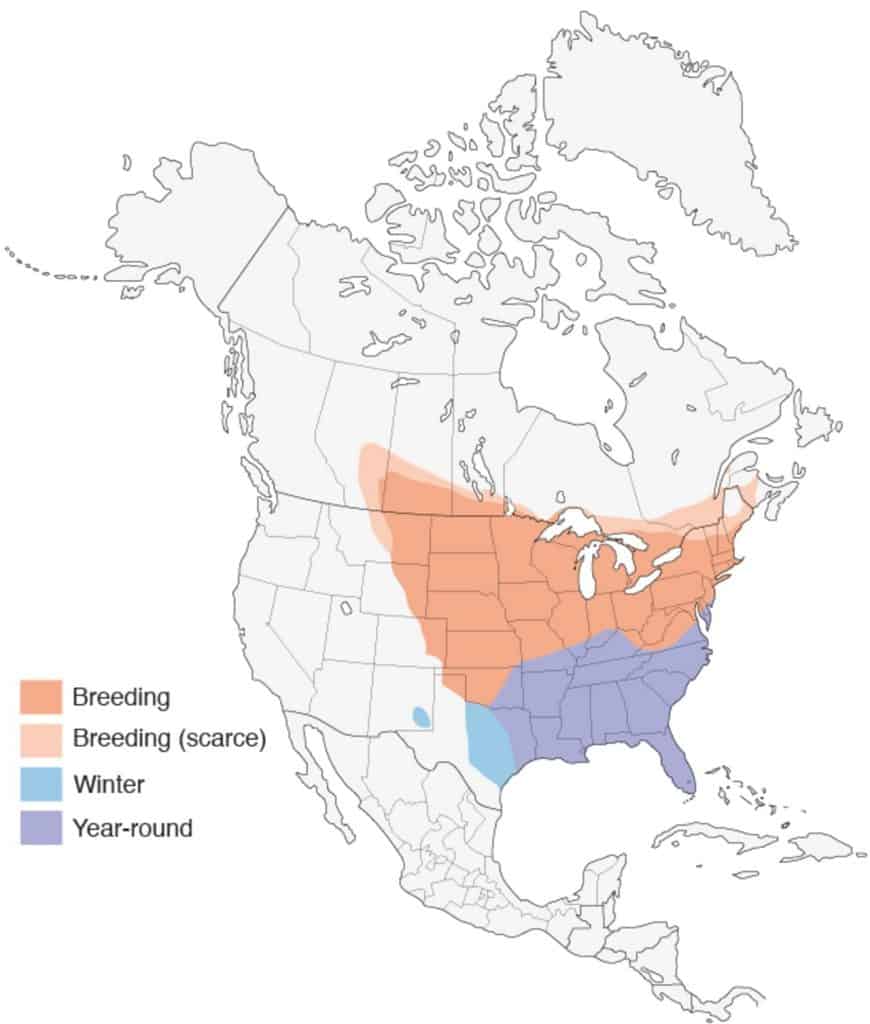
Bushtit
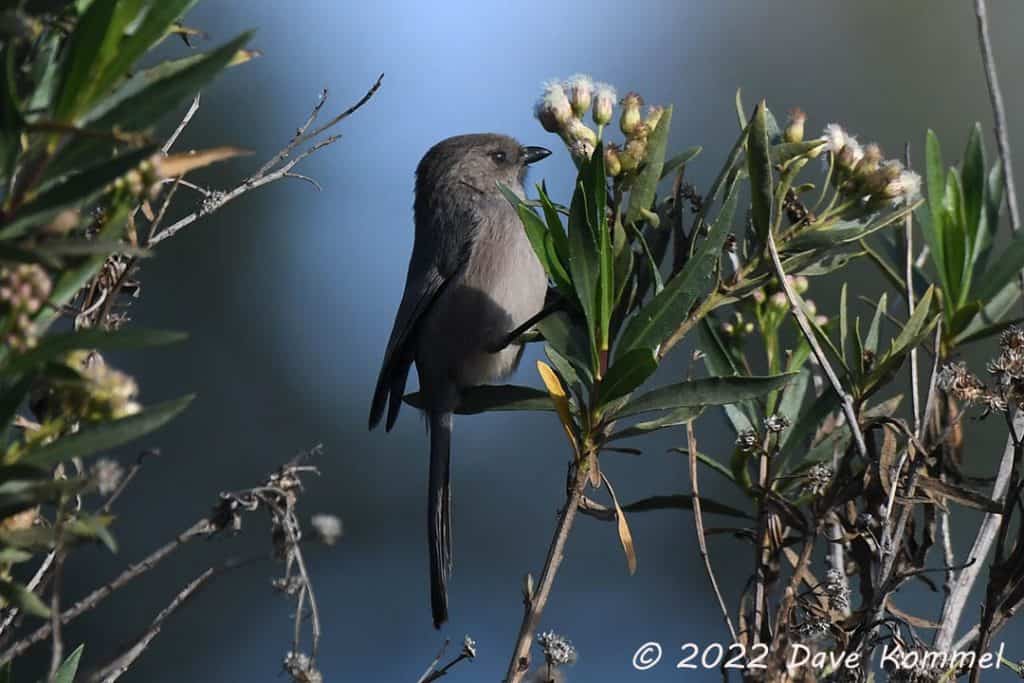
Bushtits are common backyard bird species.
Description: The bushtit is a tiny bird bout 4.5″long. They’re gray above with pale gray below. Those that live near the coast have a brown crown while the others have a brown mask and gray crown. The males have dark eyes and females have pale eyes.
Diet: Insects and spiders.
Feeder food: Black oil sunflower seeds, hulled sunflower seeds, suet, peanuts, and mealworms.
Habitat: Bushtits enjoy a variety of habitats including forested mountains, shrubby & brushy, backyards, and city parks.
Nesting: Bushtits built a gourd-shaped nest woven from vegetation and spider webs. The nest placement ranges from a low bush to high in a tree. They have 1-2 broods/season, 5-7 white eggs/brood, incubation for 12-13 days, and fledglings leave the nest at about 18 days.
Migration: Bushtits do not migrate. They remain in their year-round range all seasons of the year.
Year-round range: Along the pacific coast in British Columbia, Washington, Oregon, California, as well as inland in Washington, Oregon, California, Idaho, Nevada, Utah, Colorado, Arizona,New Mexico, Texas, and Mexico.
Range Map
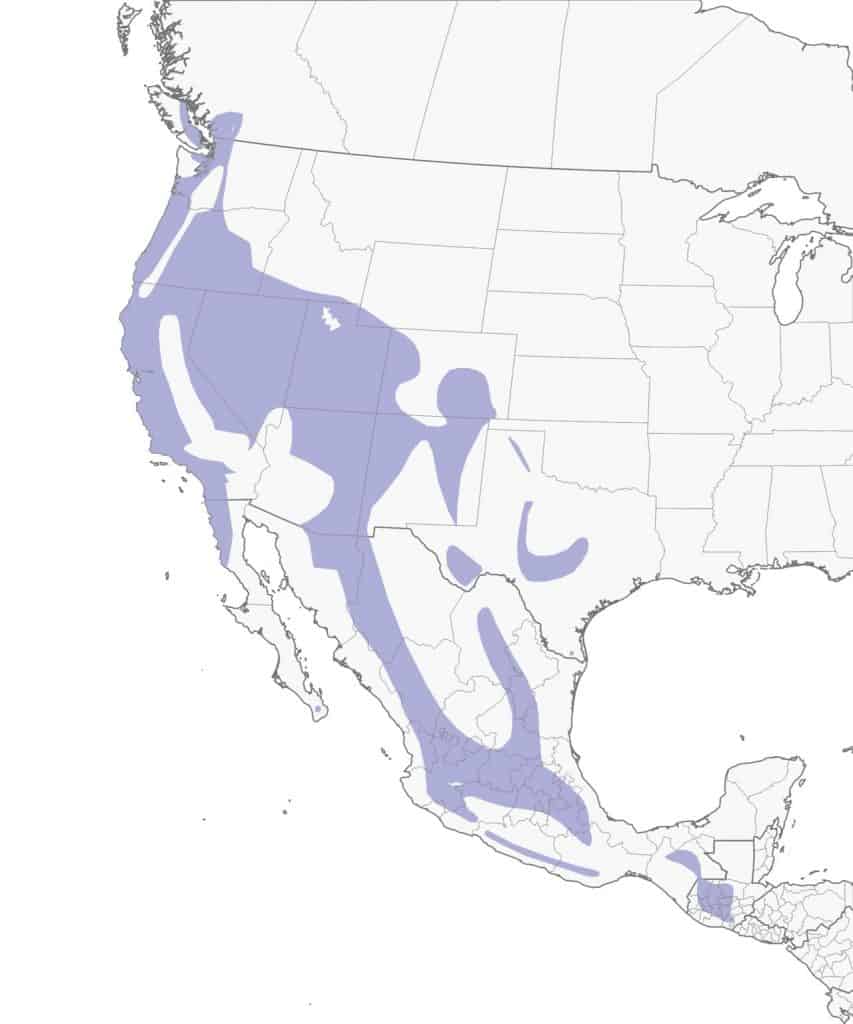
California Scrub-Jay
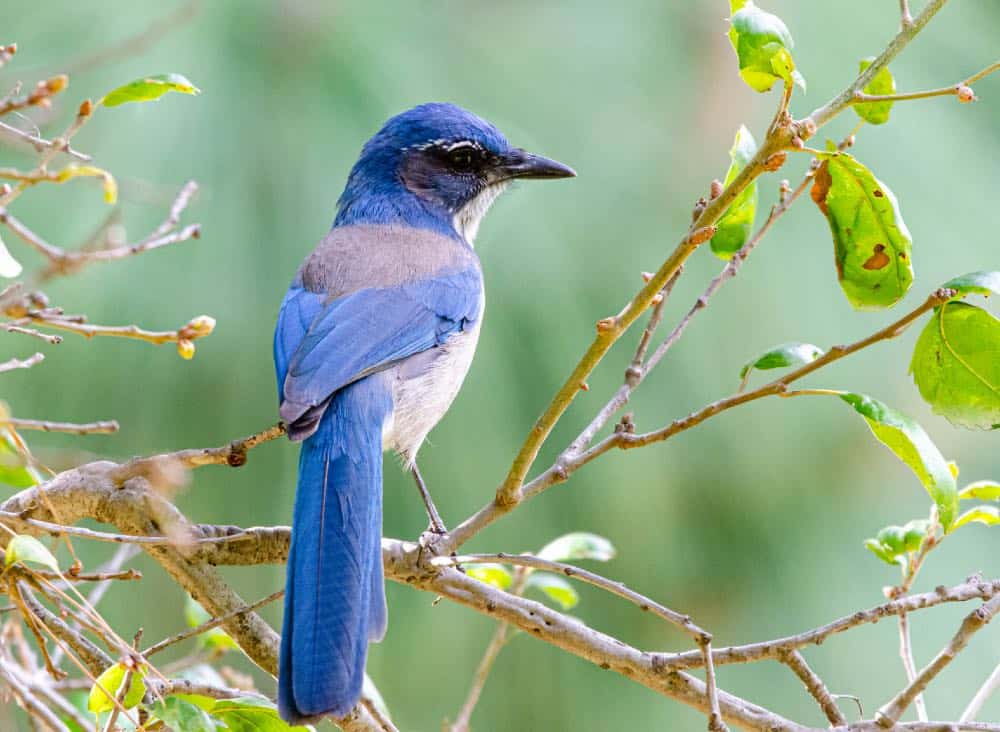
If you live in the midwest the California scrub jay would not be on your most common backyard bird species list. But if you’re in California it sure is!
| Appearance | Large bird 11″ long, slender, shades of bright azure blue and gray, brown patch on the back, white underparts, blue necklace, and long tail. Females look the same. |
| Diet | Insects, nuts (especially acorns), seeds, fruit, other birds’ eggs and nestlings, and small animals. |
| Feeder Food | Whole peanuts, sunflower seeds, and suet. |
| Habitat | Along the edges of the west coast including from Baja, Mexico to the southernmost part of British Columbia. Prefer open areas with ample trees and scrubs even within suburban and urban areas. |
| Nesting | Large and bulky open-cup nest of twigs and bark, in a tree or bush about 3-10′ up. 2-3 eggs/brood, incubated for 15-17 days and young fledge between 18-23 days. Eggs are 1-1.5″ long, pale green blotched with olive, or pale gray spotted with brown. |
Range Map
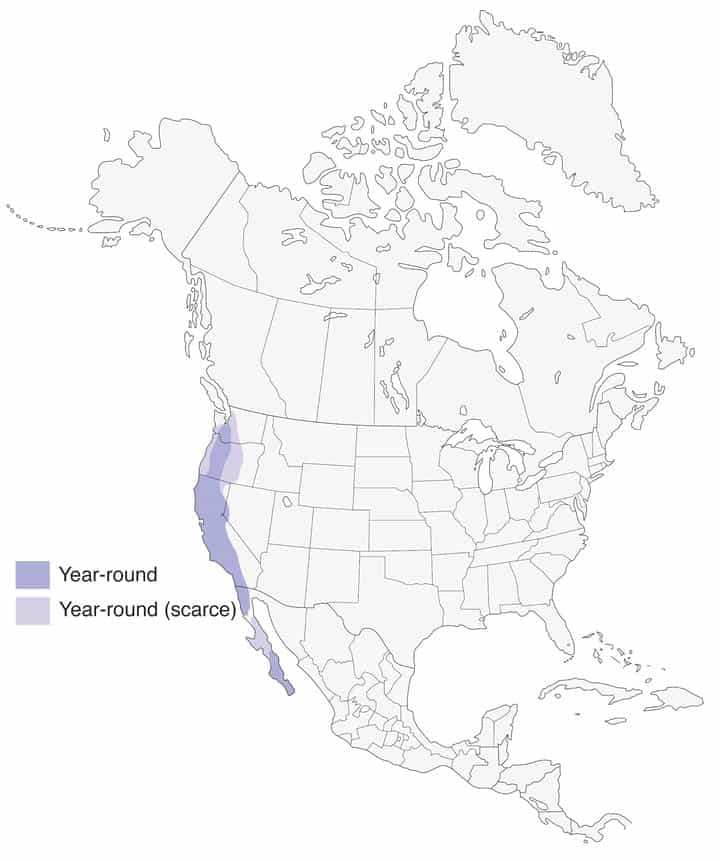
California Towhee
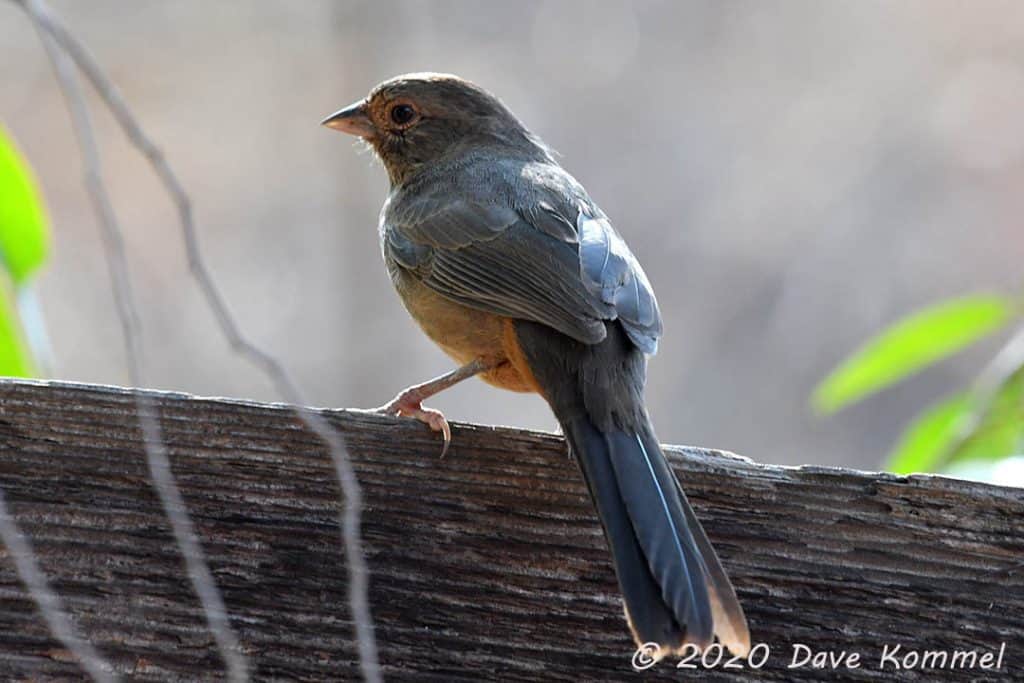
The California towhee is another one of the most common backyard bird species that has a limited range, but in large enough population to be considered “common”!
Description: The California towhee is a medium-sized bird about 9″ long. They’re brown with orange-buff face and breast, a long tail, orange-buff eye ring, trianglular beak, and long tail.
Diet: Seeds and some insects.
Feeder food: Black oil sunflower seeds, cracked corn, and millet.
Habitat: This west coast bird enjoys brushy habitats both along the coast as well as high in the mountains, along streams, open woodlands, and even backyards.
Nesting: California towhees have 1-3 broods/season, usually 3-4 light blue eggs (or creamy white eggs sometimes spotted eggs). Eggs are incubated for about 14 days and fledglings leave the nest at about 8 days.
Migration: California towhees are not migrators. They remain along the pacific coasts of California and Mexico year round. Some are found along the borders of southern Oregon and northern California.
Range Map
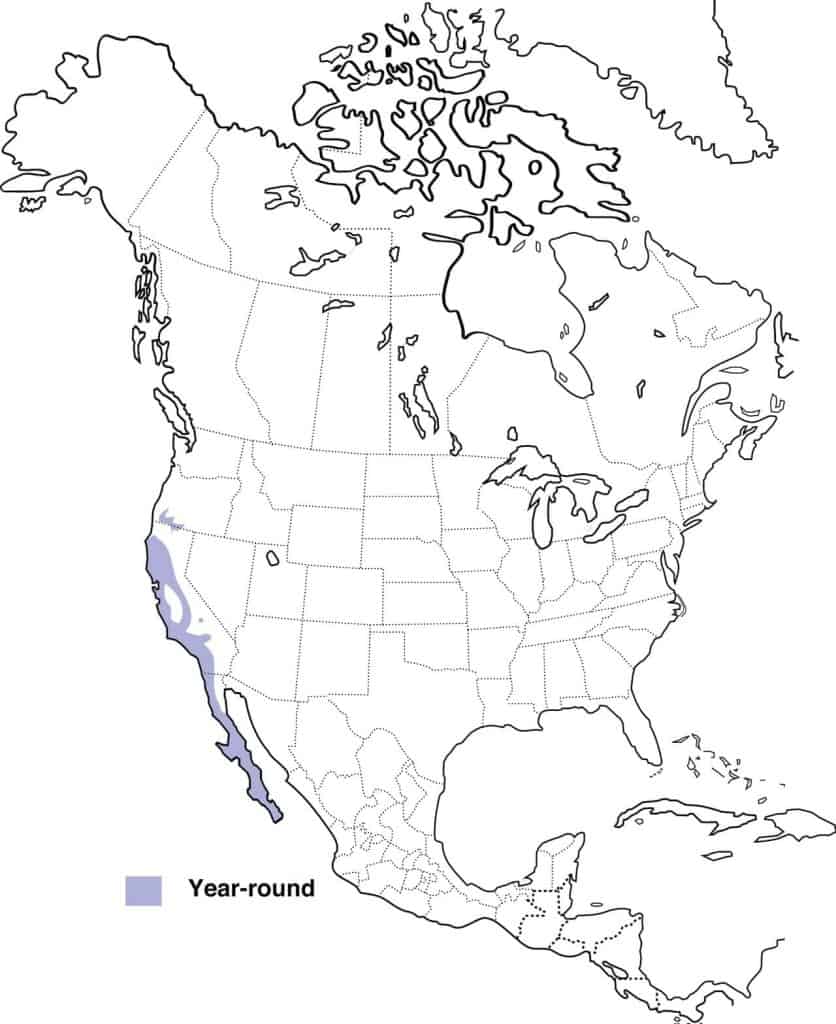
Canada Jay
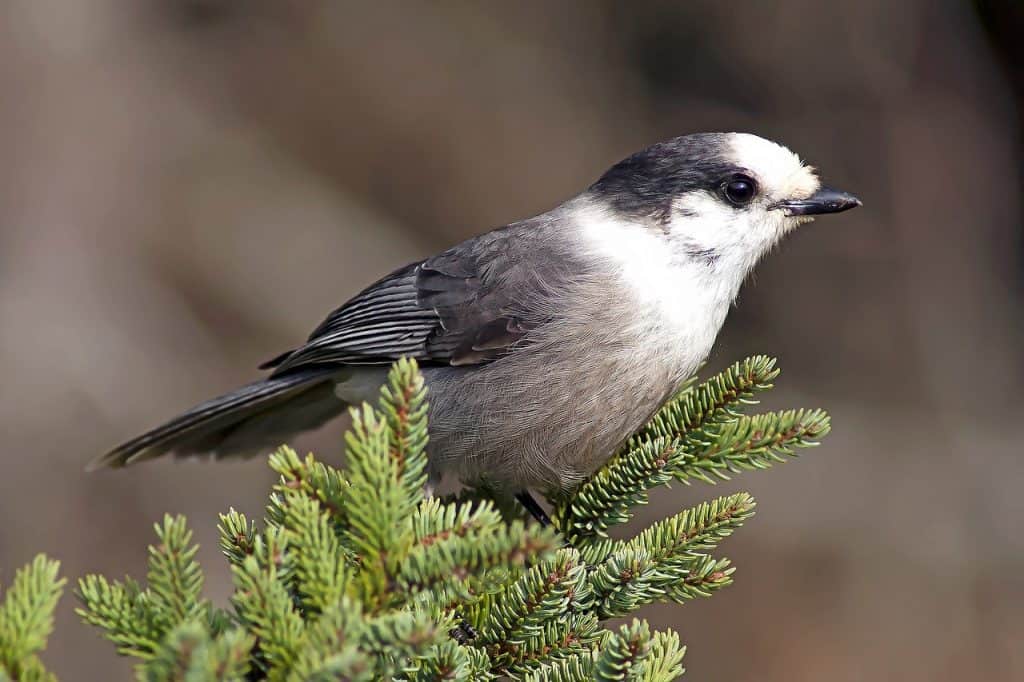
Canada jays are common backyard bird species.
| Appearance | The gray jay often referred to as the Canada jay, is a large bird about 11 1/2″ long. It’s gray all over with black on the back of its neck, a white chest, a short bill, and a dark eye. Also sports a white patch on his forehead. The female is the same as the male. |
| Diet | Insects, seeds, fruit. |
| Feeder Food | Any kind of bird seed, peanuts, fruit, mealworms, and suet. |
| Habitat | North woods. |
| Nesting | Cup-shaped nest. They have 1 brood/season, 304 gray/white eggs/brood, and incubate for 16-18 days. |
Range Map
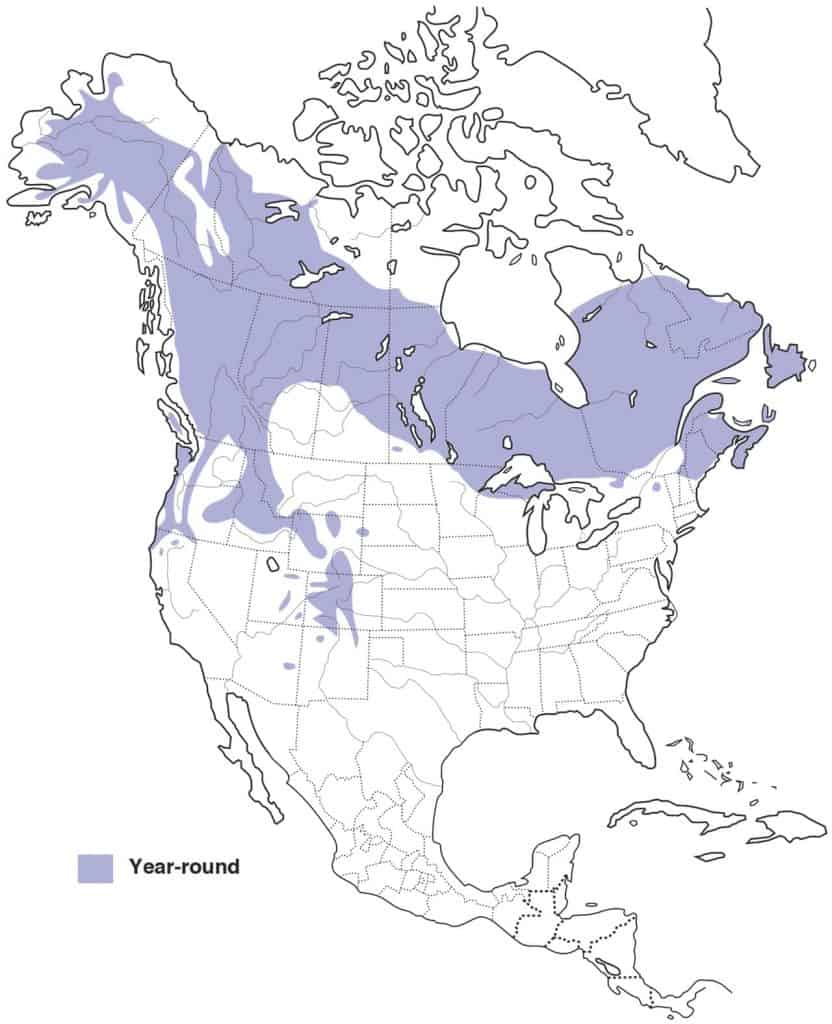
Carolina Chickadee
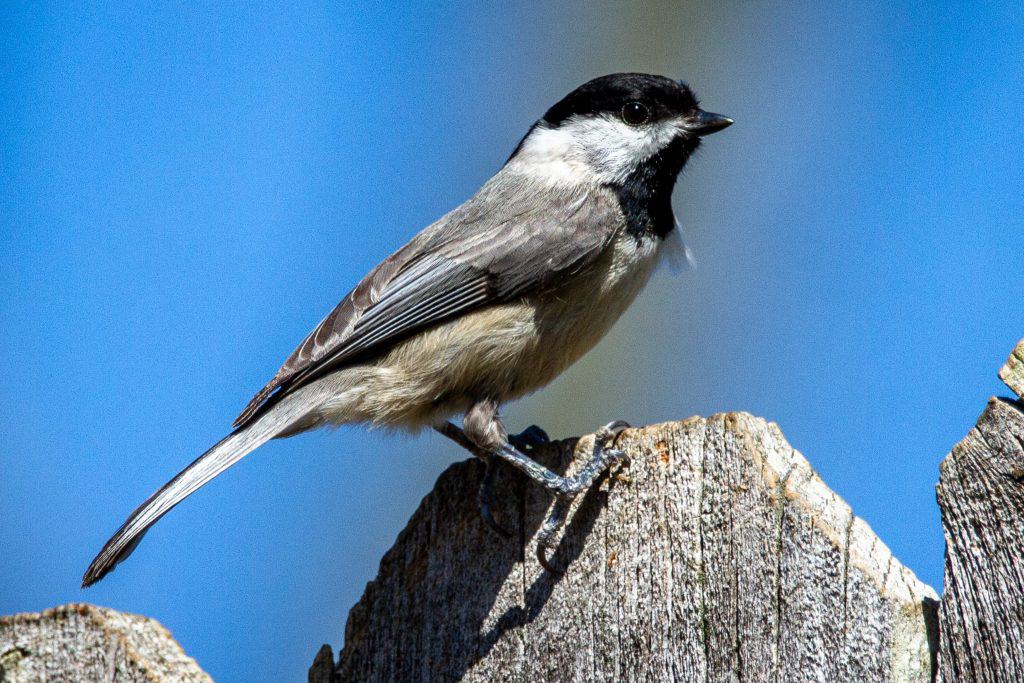
Carolina chickadees are common backyard bird species.
Appearance: The Carolina chickadee is a small bird about 5″ long. They’re primarily gray on top and white underneath. They have a black cap & throat, white cheeks that fade to gray in the back, and buffy tan flanks.
Diet: Insects, spiders, seeds, and small fruits.
Feeder food: Sunflower seeds, peanut chips, and suet.
Habitat: Woodlands and wooded edges, suburbs, and city parks.
Nesting: Carolina chickadees are cavity nesters – usually in an old woodpecker hole. They have 1 brood/season with 5-8 eggs/brood. Incubation lasts for 12-15 days and fledglings leave the nest at about 16-19 days post-hatch.
Migration: Carolina chickadees are not migrators. They remain in their year-round range for all 4 seasons of the year.
Year-round range: Southeastern US states.
Range Map
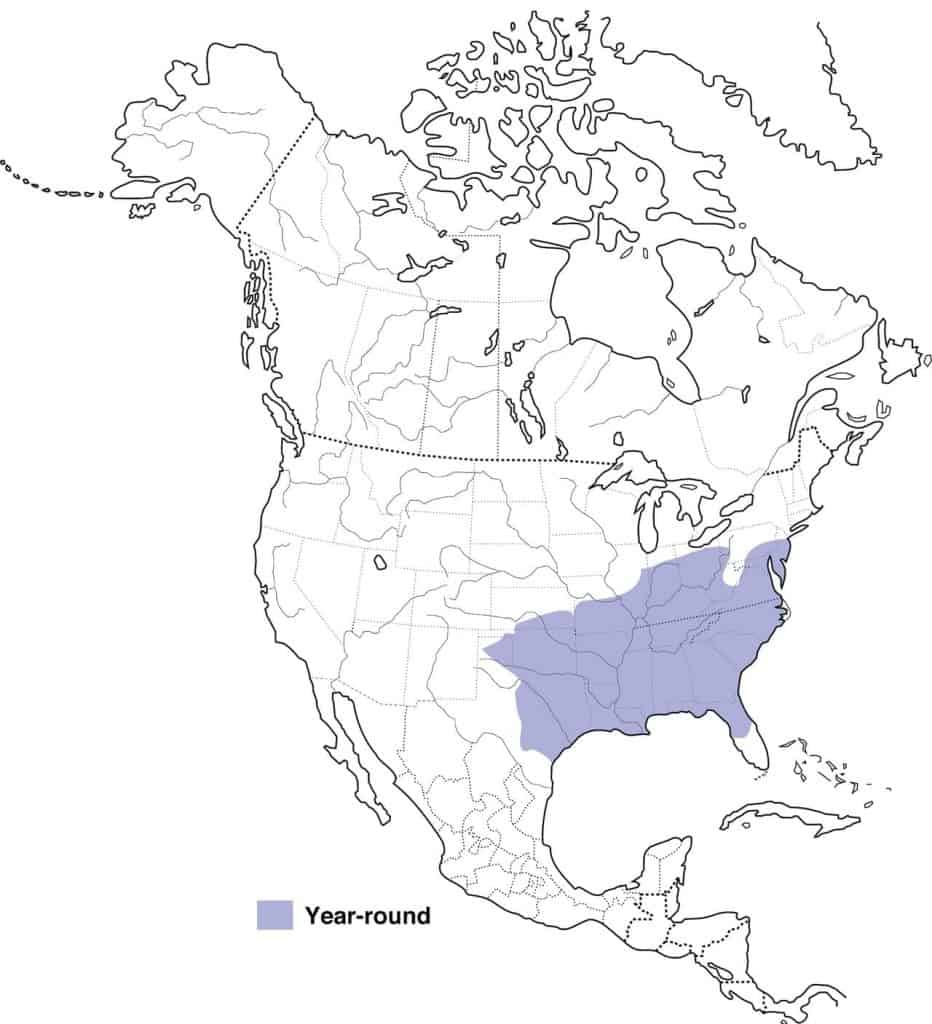
Carolina Wren
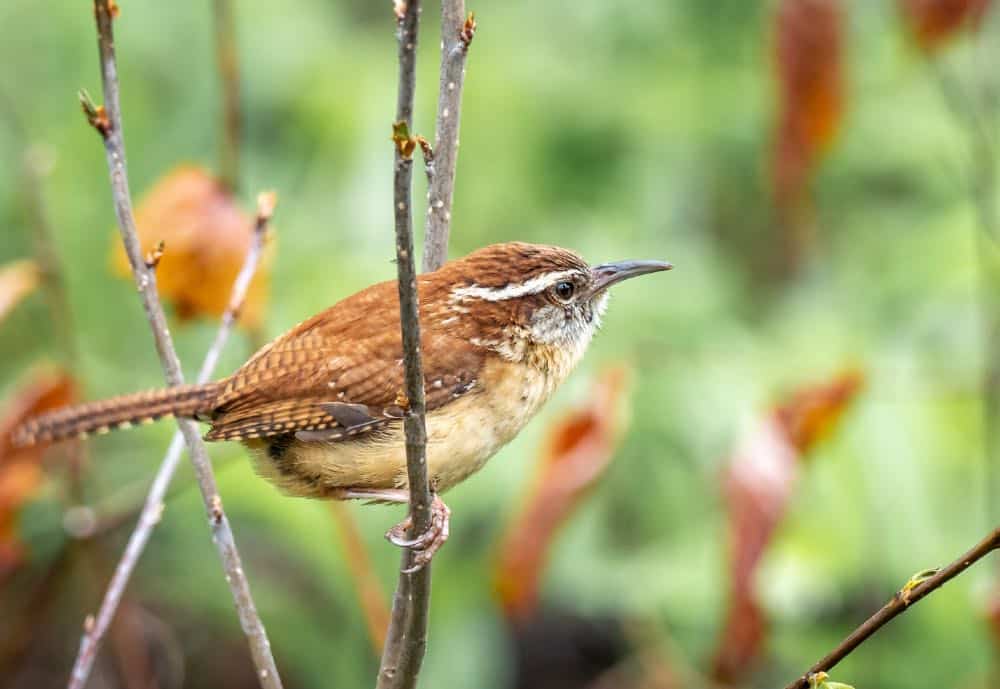
The Carolina wren is a common backyard bird species favorite in the southeast.
| Appearance | Small bird about 5 1/2″ long, chunky shape with deep rusty brown above and cinnamon color below. Bold white stripe above the eye and throat. Down curved bill. |
| Diet | Insects and spiders. |
| Feeder Food | Carolina wrens are common at the feeder. They enjoy hulled sunflower seeds, mealworms, peanut hearts, and suet in the winter. |
| Habitat | Brushy woods and wooded backyards. |
| Nesting | Bulky domed cup nest less than 10 up in a tree, inside an open tree cavity, in a hanging fern plant, or even in an upside-down flower pot. They have 1-3 broods/year, 4-6 eggs/brood, and incubate for 12-14 days. Eggs are a shade of white or pink/white with tiny brown spots. |
Range Map
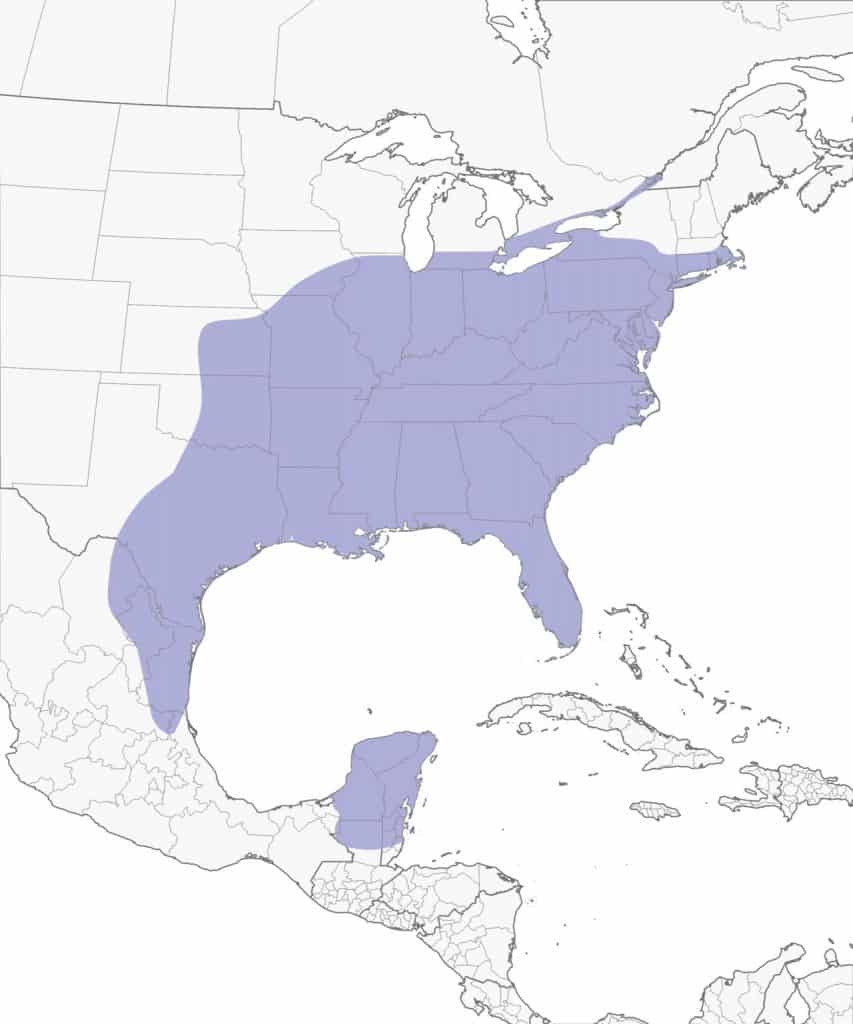
Chestnut-backed Chickadee
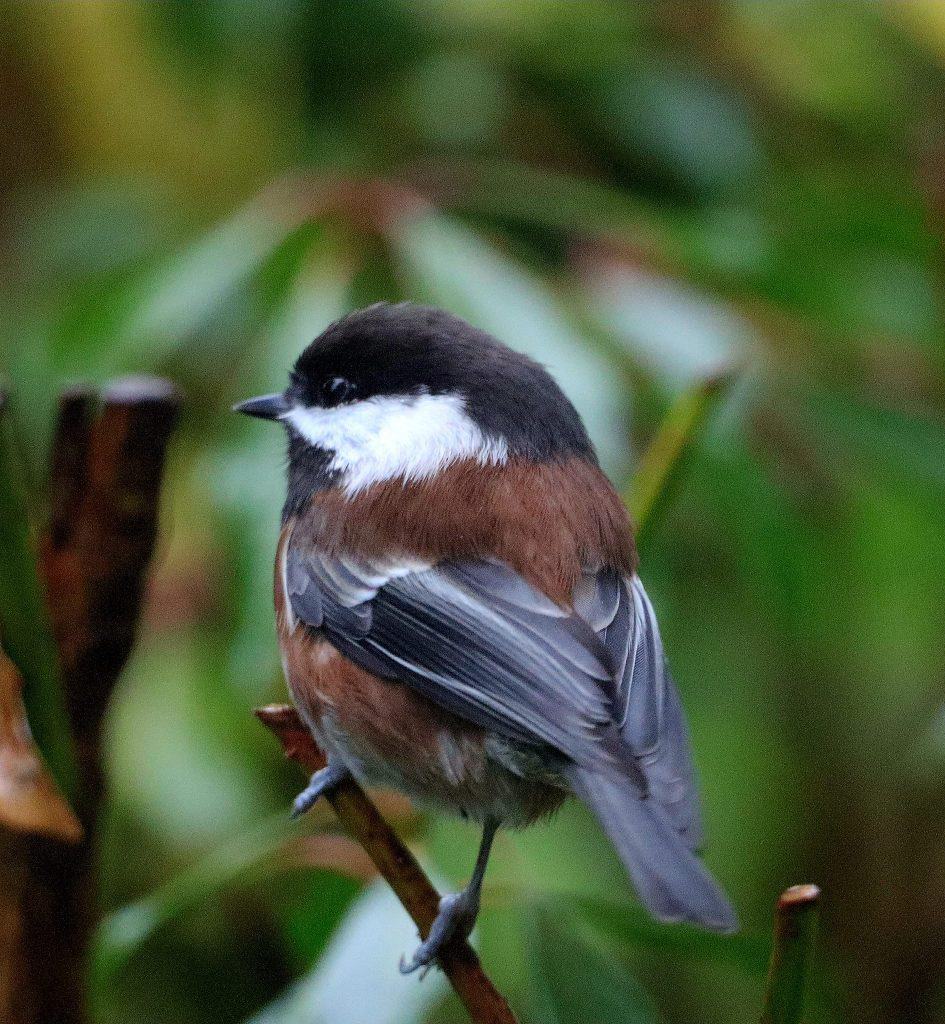
The chestnut-backed chickadee is another common backyard bird species – but only along the Pacific Northwest coast!
Description: This tiny bird is less than 5″ long and has a rich chestnut brown on its back, rump, and sides. Their cheeks are white, cap is charcoal, and underparts white. The female is similar.
Diet: insects, spiders, conifer seeds, berries, and other small fruits.
Feeder food: Black-oil sunflower seeds and suet.
Habitat: They prefer humid coastal and interior forests along the pacific coast. Also found in wooded backyards and city parks .
Nesting: Chestnut-backed chickadees are cavity nesters. They prefer an old woodpecker hole or other natural cavity. They have 1-2 broods/season, usually 6-7 white eggs with brown spots per brood, incubation is for 12-14 days, and fledglings leave the nest at about 18-21 days.
Migration: Chestnut-backed chickadees are not migrators They remain in their year-round range all seasons of the year.
Year-round range: Coasts of Alaska, British Columbia, Washington, Oregon, and California as well as inland Idaho and western Montana.
Range Map
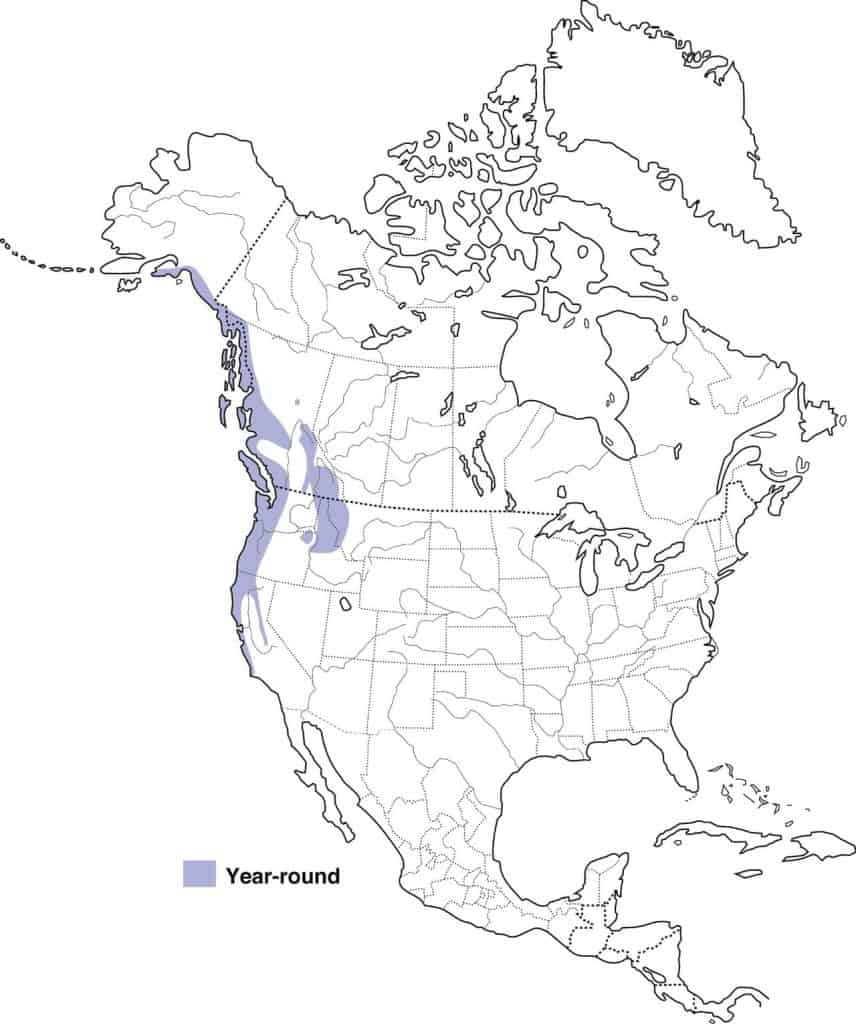
Chipping Sparrow
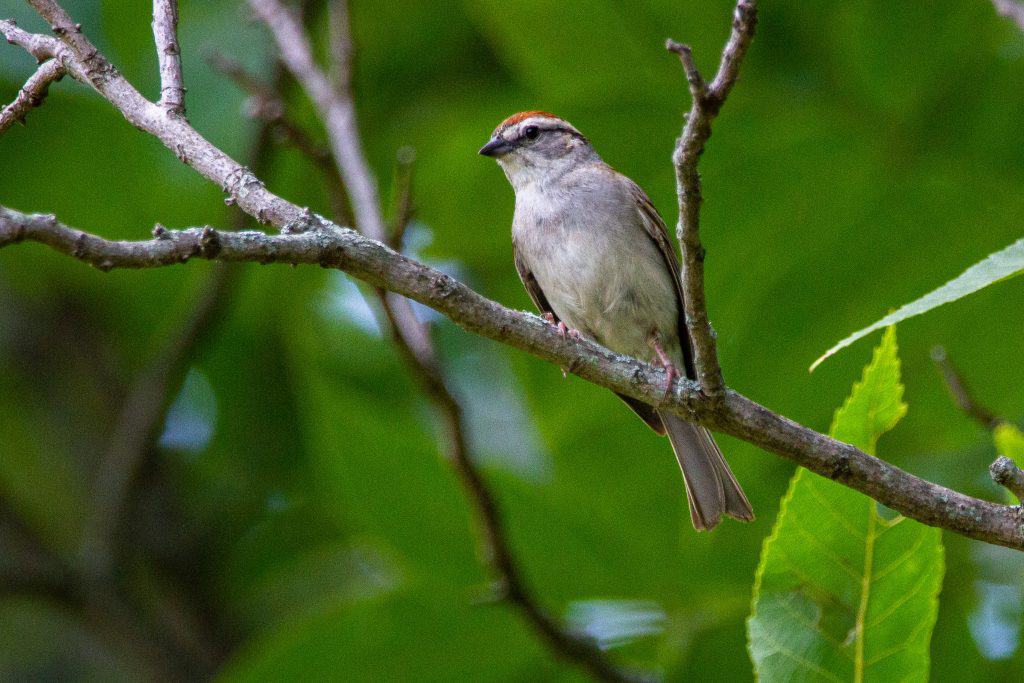
Chipping sparrows are a common backyard bird species across the U.S. and Canada – especially in the springtime.
Appearance: The chipping sparrow is a small bird about 5″ long, gray/brown with a light gray chest and rusty crown. Eyes have white eyebrows with a black eye lining, a thin gray-black bill, and 2 wing bars. Males and females look the same.
Diet: Insects and seeds.
Feeder food: Black-oil sunflower seed, mixed seeds. Mostly a ground feeder.
Habitat: Open areas and edges of woodlands.
Nesting: The nest is placed low in dense shrubs. They have 2 broods/year and 3-5 eggs/brood that are blue/green with brown markings. Incubation lasts 11-14 days.
Migration: Chipping sparrows are migrators. In spring they migrate north into every US state and Canadian province o breed and raise their young. Then in the fall, they head back south to southern California, Arizona, Florida, Georgia, Mexico, and the Caribbean islands for winter.
Breeding range: All US states and Canadian provinces.
Winter range: Southeastern California, southwestern Arizona, the pacific coasts of Mexico, Florida, southwestern Georgia, and the Caribbean island.
Year-round range: A population of the birds remains in their year-round range in central to southern California as well as parts of Central America.
Range Map
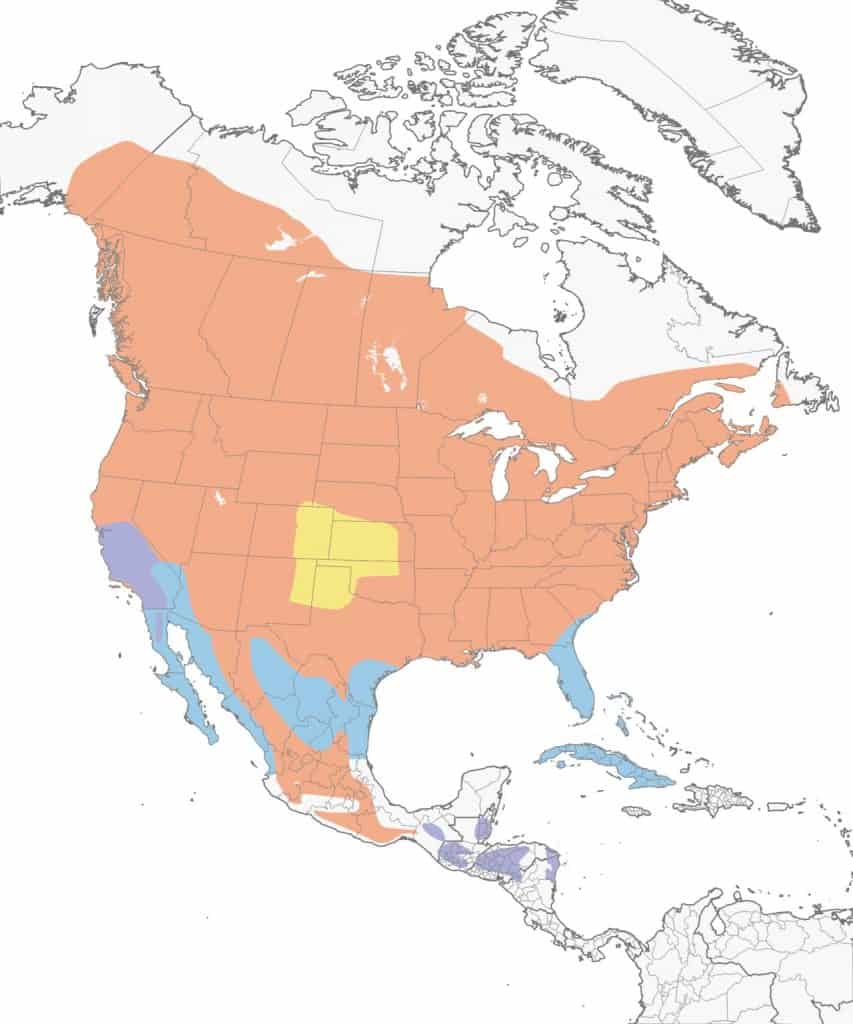
Common Grackle
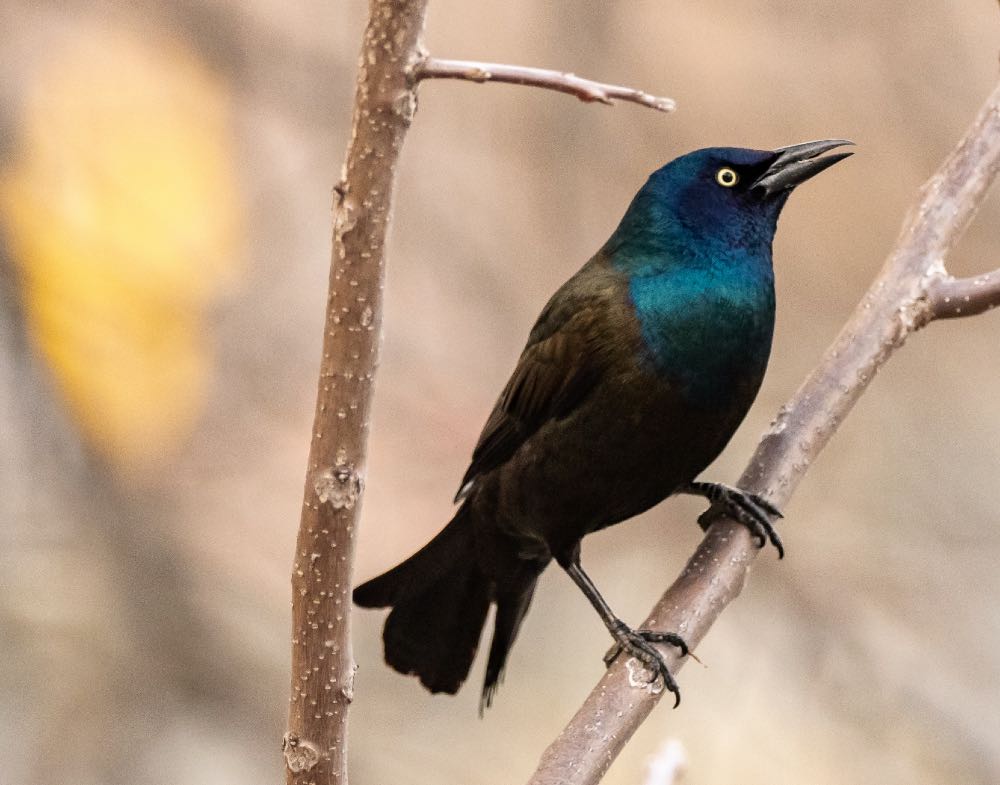
Common grackles are common backyard bird species.
Appearance: The common grackle is a large bird about 12.5″ long bird with iridescent blue purple and bronze. Their eyes are yellow and they have long flared tails. The female is similar with less vibrant coloring (browner) and a shorter tail.
Diet: Insects, grains, seeds, fruit, scavenged garbage.
Feeder food: Sunflower seeds, black-oil sunflower seeds.
Habitat: Fields with scattered trees, open woodlands, farmlands, and marshes. Common in suburban yards.
Nesting: Bulky cup-shaped nest of twigs placed 3-20′ high in a conifer tree. 3-5 eggs incubated for 12-15 days. Young fledge at about 12-15 days.
Migration: Common grackles are migrators. While many remain in their year-round range all four seasons, many head north in spring (as far north as Canada’s Northwest Territories) to breed and raise their young. Then in the fall, they head back south into their year-round range. A small part of the population pushes further southwest of Texas.
Year-round range: Nebraska and the US states south and east of it. US states
Breeding range: Montana, Idaho, Wyoming, Colorado, New Mexico, North Dakota, South Dakota, Kansas, western Kansas, Minnesota, Wisconsin, Michigan, the New England states, and all Canadian provinces (except for Nunavut and barely British Columbia).
Winter range: Southwest edge of their Texas year-round range.
Range Map
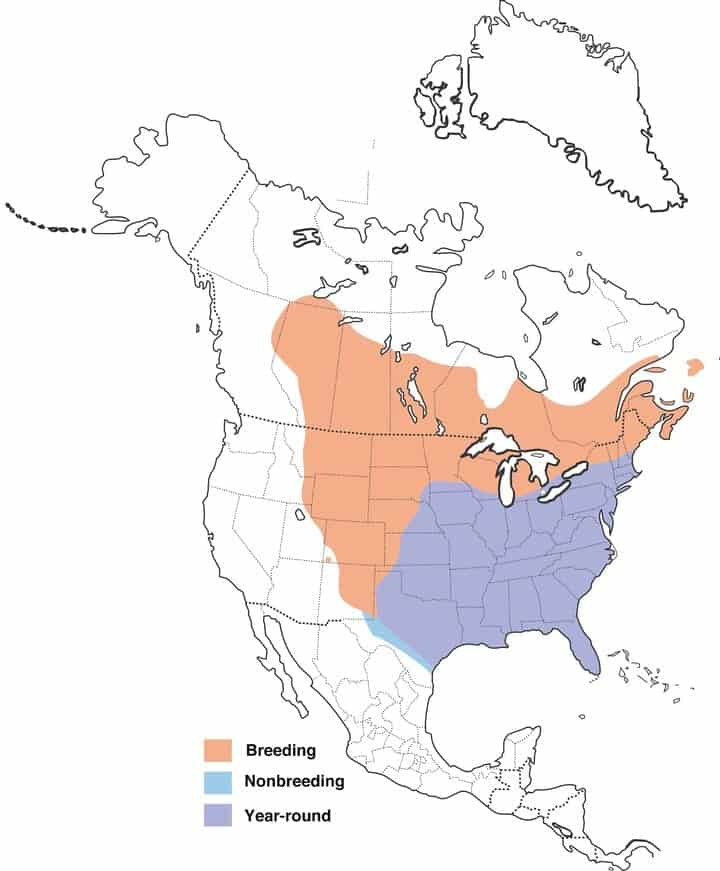
Common Raven
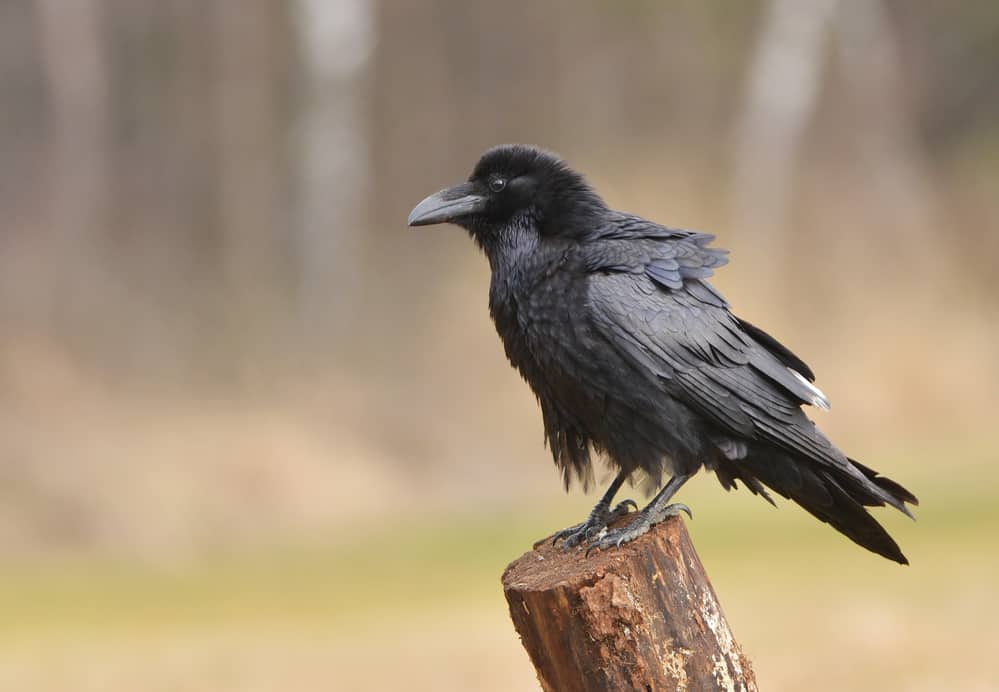
Common ravens are common backyard bird species.
| Appearance | The common raven is a very large bird about 22-27″ long. It’s all black with a large black bill and a jagged array of feathers on its chin. The tail is also large and shaped like a wedge. The female is the same as the male. |
| Diet | Insects, fruit, small animals, carrion. |
| Feeder Food | Black-oil sunflower seed, hulled sunflower seed, suet, cracked corn, peanuts, and peanut hearts. |
| Habitat | Forested areas. |
| Nesting | They build a platform nest and have 1 brood/season. They have 4-6 eggs/brood colored pale green with brown markings. Incubation is for 18-21 days. |
Range Map
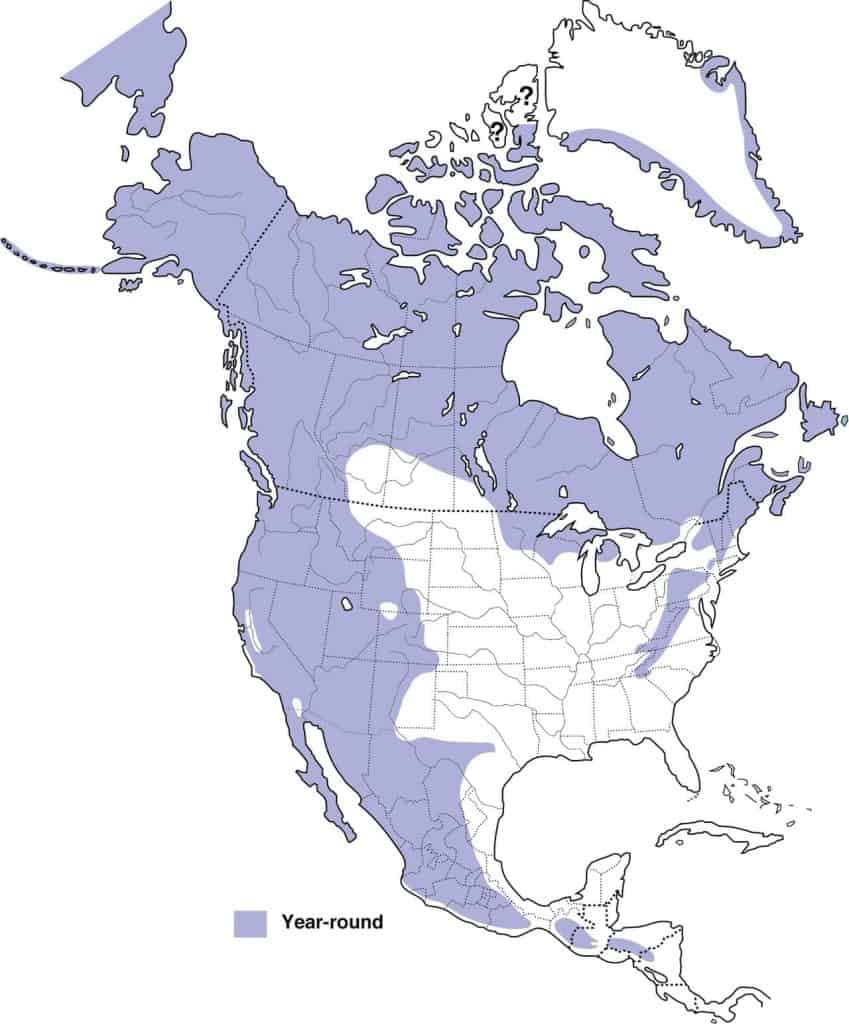
Common Redpoll
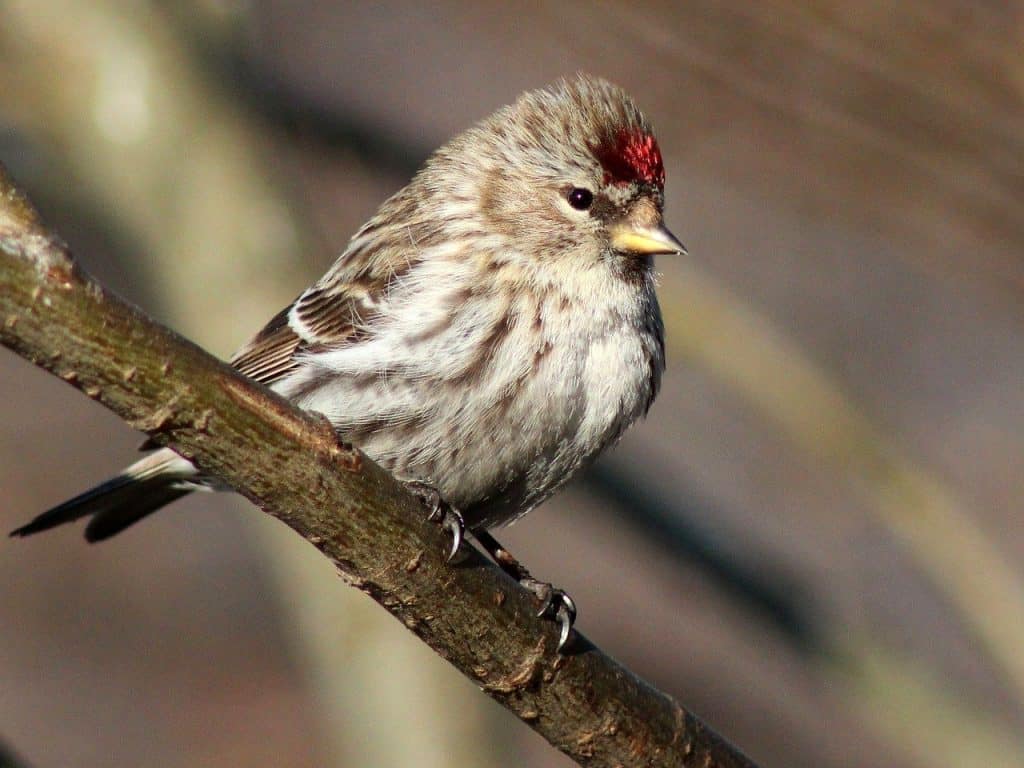
The common redpoll is another common backyard bird species. While their year-round range is limited to the very northwestern and northeastern parts of the content, they manage to make themselves known broadly throughout the U.S. and Canada.
| Appearance | The common redpoll is a small bird about 5″ long. It’s a heavily streaked bird with a bright red crown, a black spot beneath the chin, and raspberry splotch on its chest. The female is similar except without the raspberry chest. |
| Diet | Seeds, insects. |
| Feeder Food | Black-oil sunflower seed, hulled sunflower seed, and nyjer. |
| Habitat | Open areas lined with trees. |
| Nesting | Cup-shaped nest. They have 1 brood/season and 4-5 eggs/brood that are pale green with purple markings. |
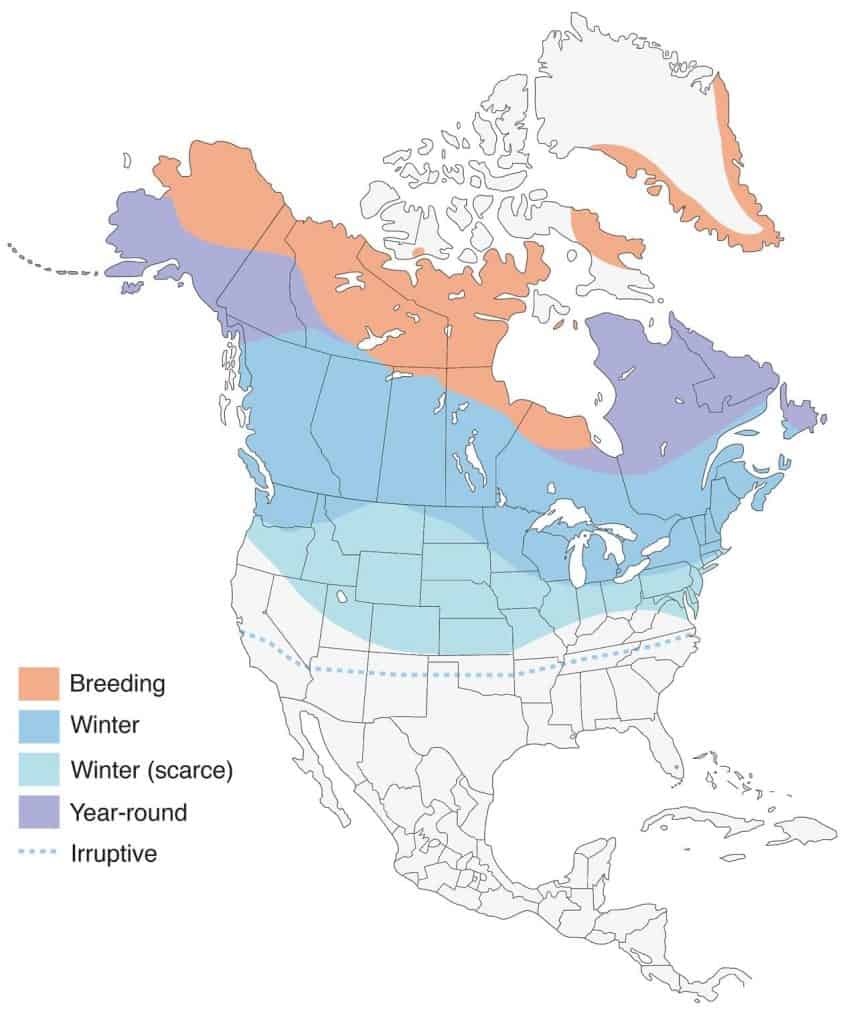
Range Map
Dark-Eyed Junco
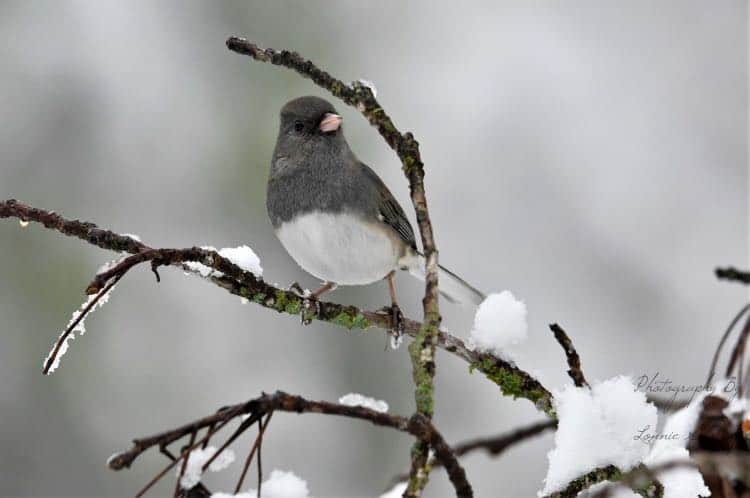
Without question, the dark-eyed junco is a very common backyard bird species throughout North America.
Appearance: Dark-eyed juncos are tiny birds about 5.5″ – 6.5″ long. Males are dark gray with a white underside and pink bill. Females are the same except brownish gray.
Diet: Insects, spiders, seeds.
Feeder food: Nyjer, black-oil sunflower seeds, hulled sunflower seeds, safflower seeds, cracked corn, hulled peanuts, and suet.
Habitat: Juncos are found across the US and Canada so can be found in a variety of habitats including forested areas (both coniferous and deciduous), wide-open spaces, partially wooded edges, parks, and backyards.
Nesting: Nests are located in a variety of locations from ground level surrounded by vegetation to a hanging basket. They have 1-3 broods/season, 3-6 eggs per brood that can be any of these colors: White, gray, pale bluish-white, or pale-greenish white speckled with brown, gray, and green. Occasionally unmarked. Incubation lasts 9-13 days.
Migration: Dark-eyed juncos are partial migrators. Some remain in their year-round range all seasons of the year while others migrate north in spring and south for the winter.
Year-round range: Southern Alaska, Washington, Oregon, Idaho, Montana, Wyoming, Utah, California, Nevada, Colorado, Arizona, New Mexico, northern Minnesota, Wisconsin & Michigan, Pennsylvania, New York, New England, and British Columbia & Alberta in Canada.
Breeding range: Alaska and Canada.
Winter range: The remaining US states (outside the year-round range above), southeast Alberta, southern Saskatchewan, far southeast Ontario, and Mexico.
Range Map
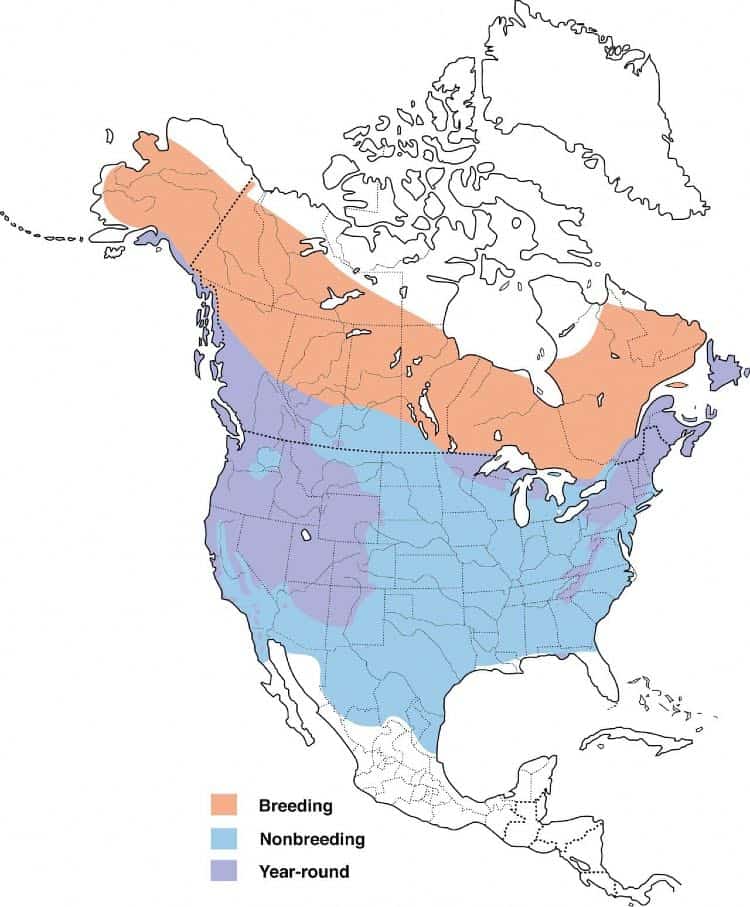
Downy Woodpecker

Downy woodpeckers are also common backyard bird species throughout the continent.
Appearance: Downy woodpeckers are small birds 6″ – 7″ long. Males are tuxedo-black with a white stripe on the back, white belly, white outer tail feathers, some spotted areas of white on the wings, a yellow/tan spot above the beak, and the infamous red patch on his head at the back of the crown. Females are nearly identical without red coloring.
Diet: Insects, and fruit from trees/shrubs.
Feeder food: Suet, peanut butter spread, Sunflower seeds, Safflower seeds, hulled peanuts, corn, fruits, nectar (sugar water).
Habitat: Anywhere there are trees.
Nesting: Downy woodpeckers nest in cavities – either a hole in a tree trunk or a nesting box. Usually only one brood per season, 3-6 all-white eggs. Incubation is about 11-12 days.
Migration: Downy woodpeckers are not migrators. They remain in their year-round range all four seasons.
Year-round range: Every US state and Canadian province (except Nunavut).
Range Map
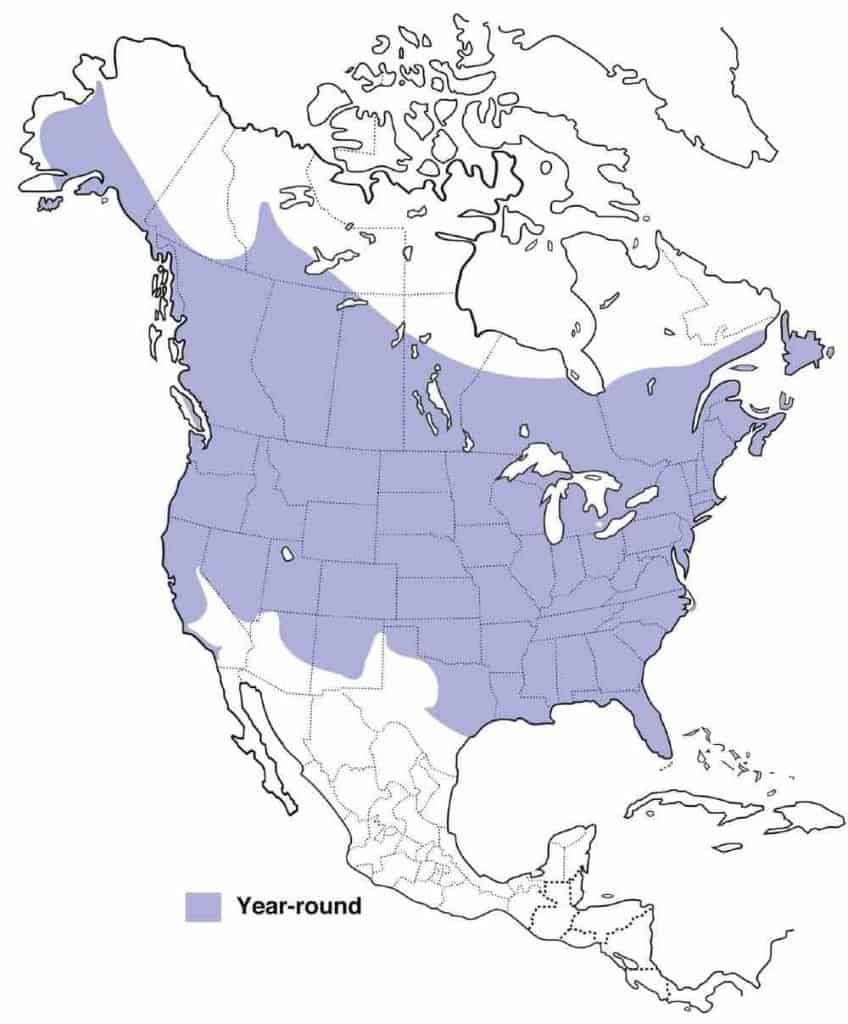
Eastern Bluebird
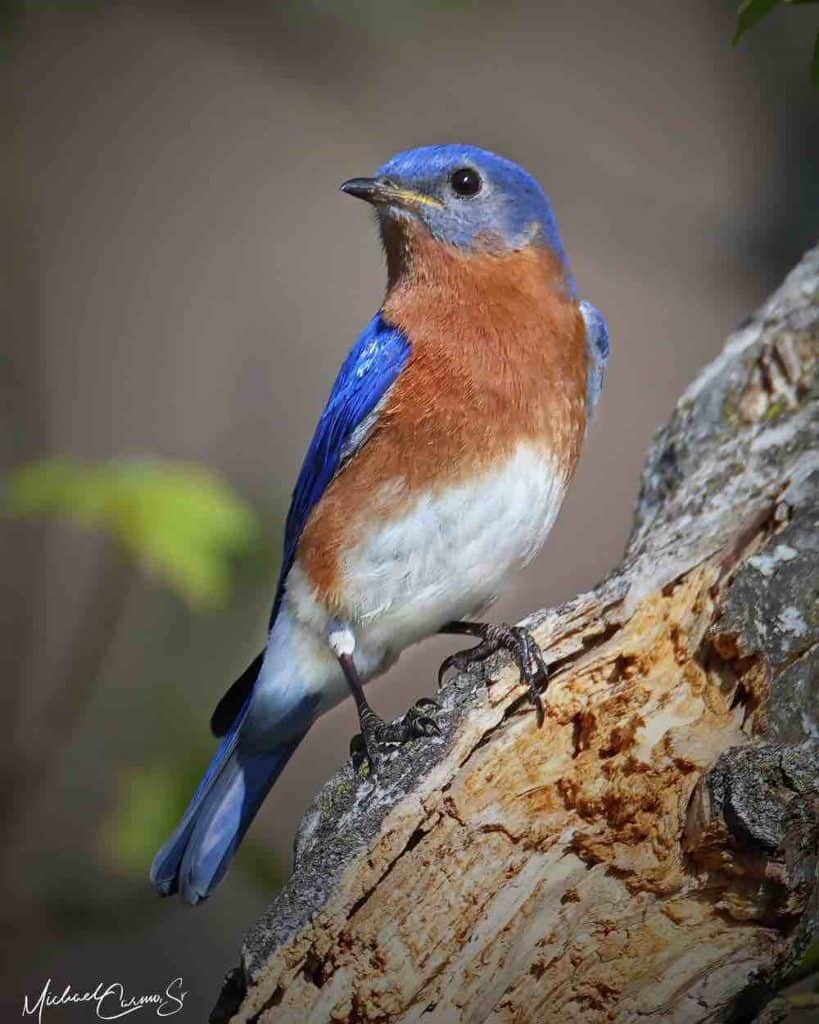
Eastern bluebirds are common backyard bird species.
Appearance: Eastern bluebirds are small birds about 7″ long, royal blue, orange throat & breast, white belly & undertail. Female is similar but with more muted colors
Diet: Insects & spiders in spring/summer. Small fruit in Fall/Winter.
Feeder food: Suet, sunflower seeds, dried fruit, jelly.
Habitat: Wide-open spaces, fields, meadows.
Nesting:
- Nest: Cavity nesters. The male bluebird determines the nest site (an old woodpecker hole in a tree or manmade nestbox), but the female is the one who builds the nest. She keeps the nest for multiple broods.
- Brood: 2-7 broods/season
- Clutch: 4-5 eggs/brood
- Egg color: Pale blue eggs (sometimes white) with no blemishes or discoloration.
- Egg size: 0.9 inches by 0.8 inches
- Incubation: 11-19 days
Migration: Some eastern bluebirds are migrators. While many remain in their year-round range all year long, some migrate north for breeding and raising their young then head south in winter back into the year-round range or further west into Colorado, New Mexico, and western Texas.
Year-round range: The US states south and east of Nebraska, Mexico, and Central America.
Breeding range: Northwest Nebraska, South Dakota, North Dakota, Minnesota, the northern half of Wisconsin & Michigan, New Hampshire, Maine, and the southern part of these Canadian provinces: Saskatchewan, Manitoba, Ontario, and Quebec.
Winter range: Eastern Colorado, New Mexico, western Texas, and northeast Mexico.
Range Map
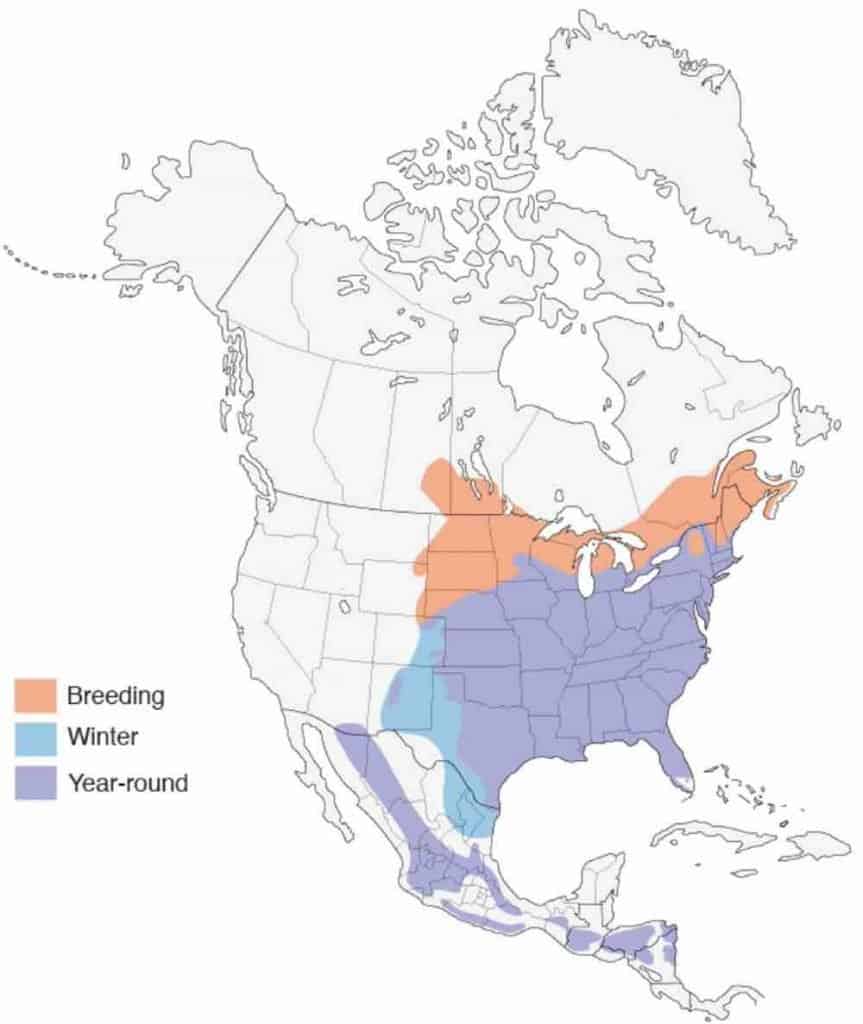
Eurasian Collared-Dove
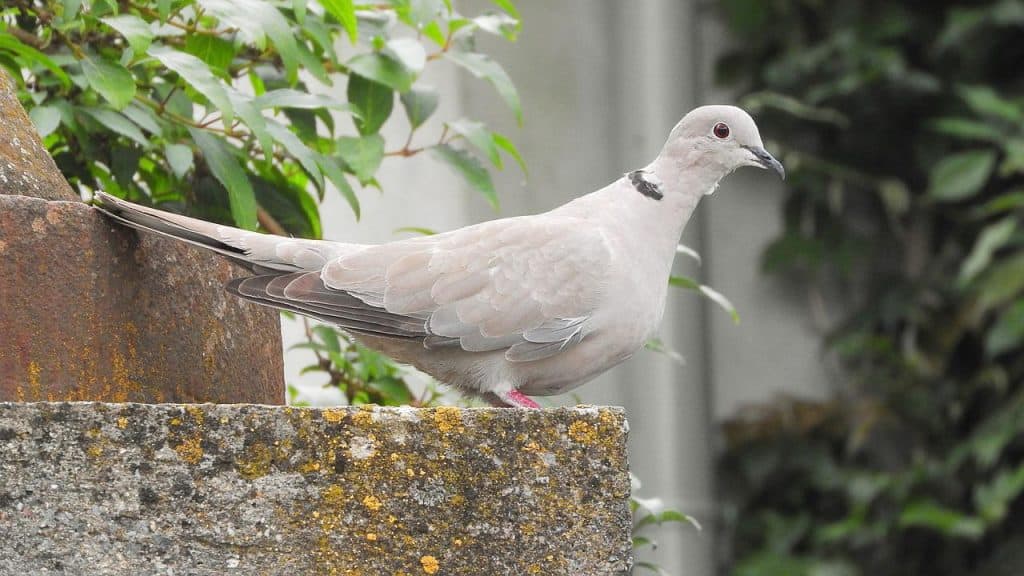
Eurasian collared doves are common backyard bird species.
Appearance: The Eurasian collared dove is a large bird about 12 1/2″ long, gray/tan with a black collar on the back of its neck. Eyes are large and black, bill long and slightly curved down. They have a long, squared-off tail with a white tip best seen from underneath.
Diet: Seeds, grain, berries, and insects.
Feeder food: Millet on the ground or platform feeder.
Habitat: They live in towns, suburbs, and farms.
Nesting: They build their flimsy platform nest of twigs and stick then place them in a tree or shrub about 1/2 way up. They have 3-6 broods/season with 1-2 eggs/brood. Eggs are white and slightly glossy. Incubation is for 14-19 days and fledglings leave the nest about 16-20 days after hatching.
Migration: Eurasian-collared doves do not migrate. They remain in their year-round range for all seasons of the year.
Year-round range: The western half of the US, states east and south of Illinois, southern British Columbia, Alberta, and Saskatchewan, as well as Mexico.
Range Map
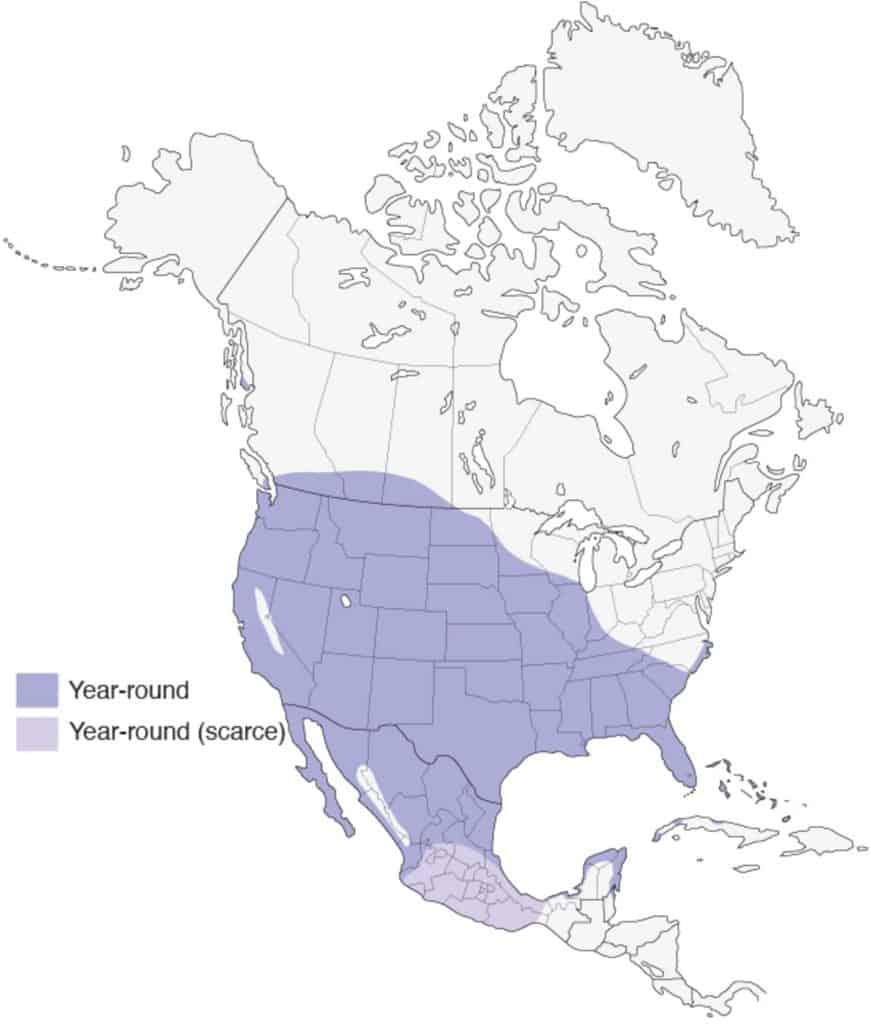
European Starling
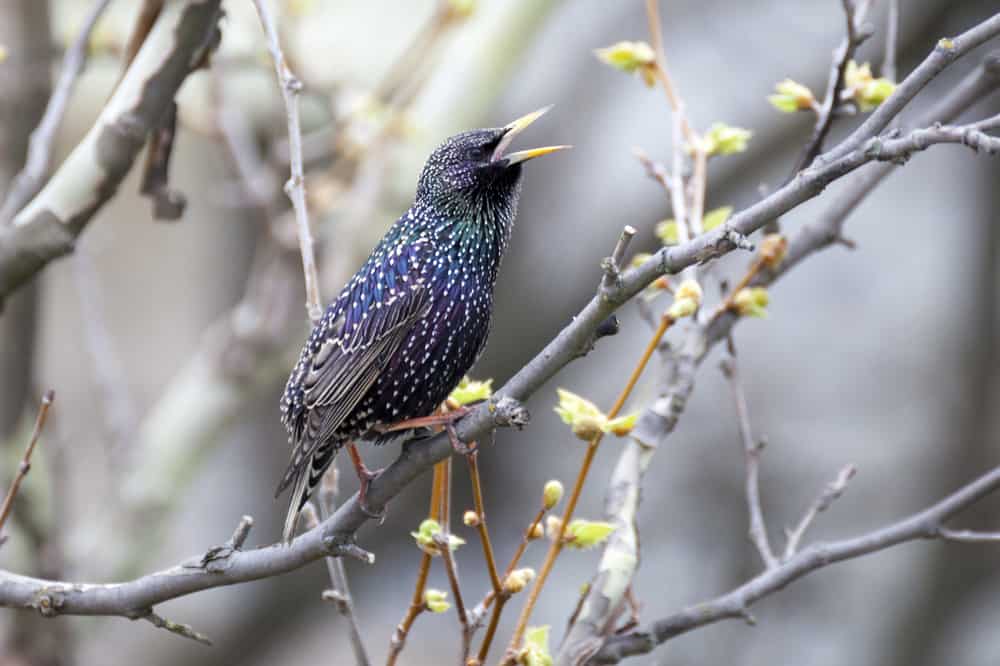
Sometimes we wish a common backyard bird species wasn’t so common. Can you relate?
| Appearance | Medium-sized bird about 7 1/2″ long with iridescent shades of purple and black with white speckles throughout. They have a long pointed gray bill in fall and yellow in spring. The tail is short. The Female looks the same. |
| Diet | Insects, seeds, fruit. |
| Feeder Food | Everything and anything you could offer at the feeder. |
| Habitat | Urban and residential areas throughout the US and Canada including backyard lawns, parks, and fields. |
| Nesting | Nest: They are cavity nesters Brood: 2 broods/year. Clutch: 4-6 eggs/brood Egg color: Glossy bluish or a pale green Egg size: 1.1 – 1.3 inches by 0.8 – 0.9 inches Incubation: 12-14 days. |
| Migration | North American European starlings are not migrators. They remain in their year-round range all seasons of the year. That said, some may head further south into Mexico for winter. Year-round range: Every US state and Canadian province, and Mexico. |
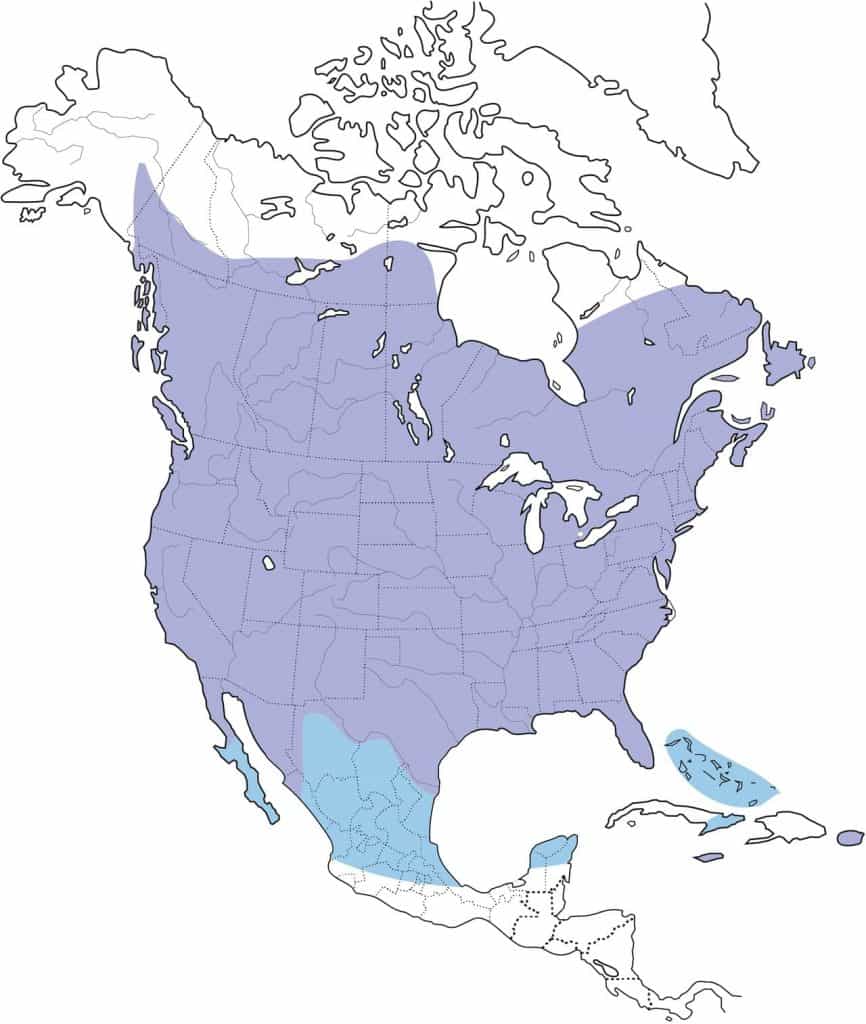
Fox Sparrow
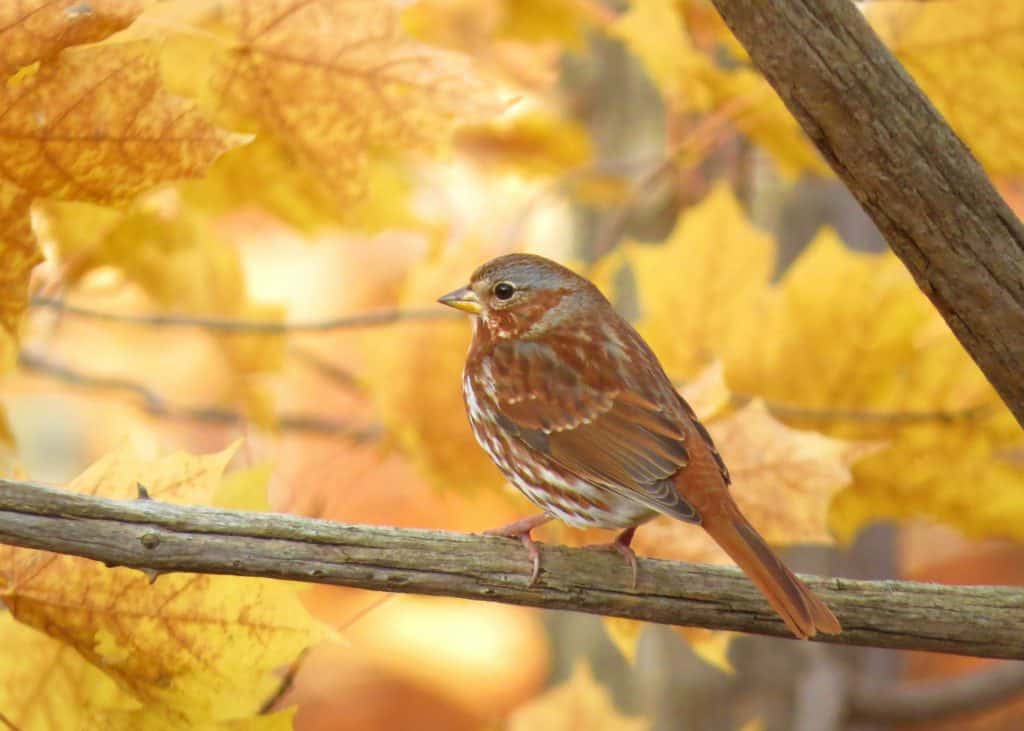
Fox sparrows are common backyard bird species.
| Appearance | The fox sparrow is a medium-sized bird about 7 1/2″ long with rusty-red color. It has a heavy streaking of rust color on its breast and tail. The head and back are shades of gray. The female looks like the male. |
| Diet | Insects and seeds. |
| Feeder Food | Black-oil sunflower seed, hulled sunflower seed, nyjer, cracked corn, millet, and milo. |
| Habitat | Scrubby areas with thick vegetation. |
| Nesting | A cup-shaped nest. They have 2 broods/season with 2-4 pale green eggs with reddish spots, per brood. Incubation is for 12-14 days. |
Range Map
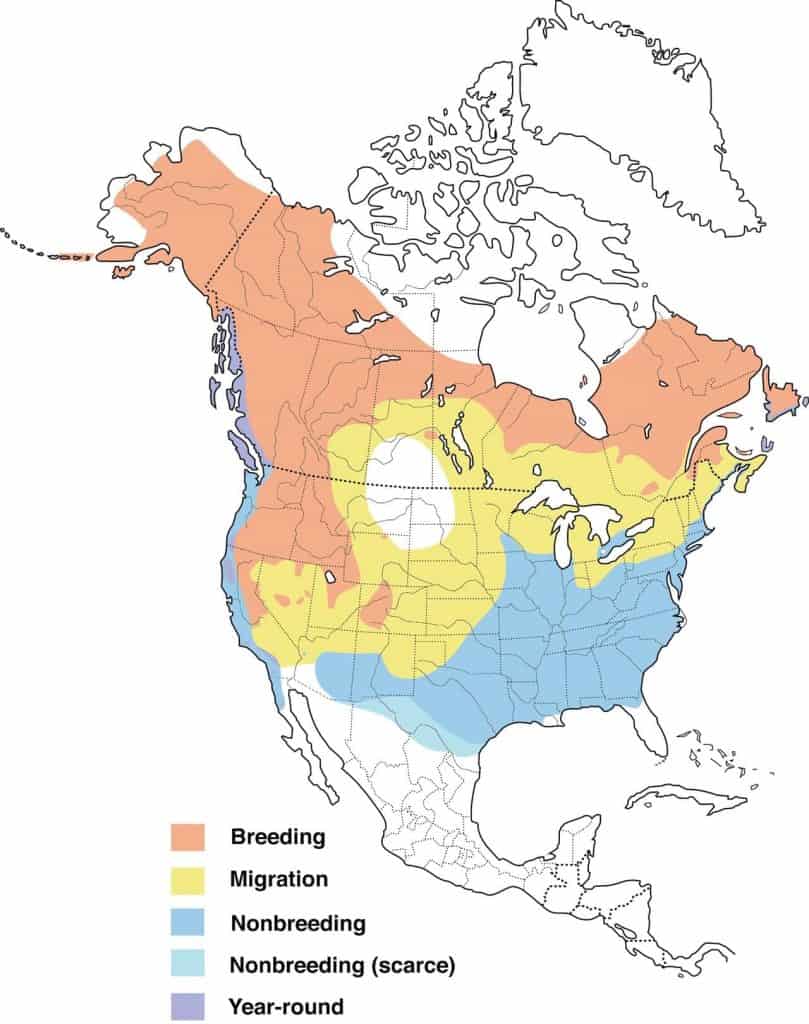
Golden-crowned Sparrow
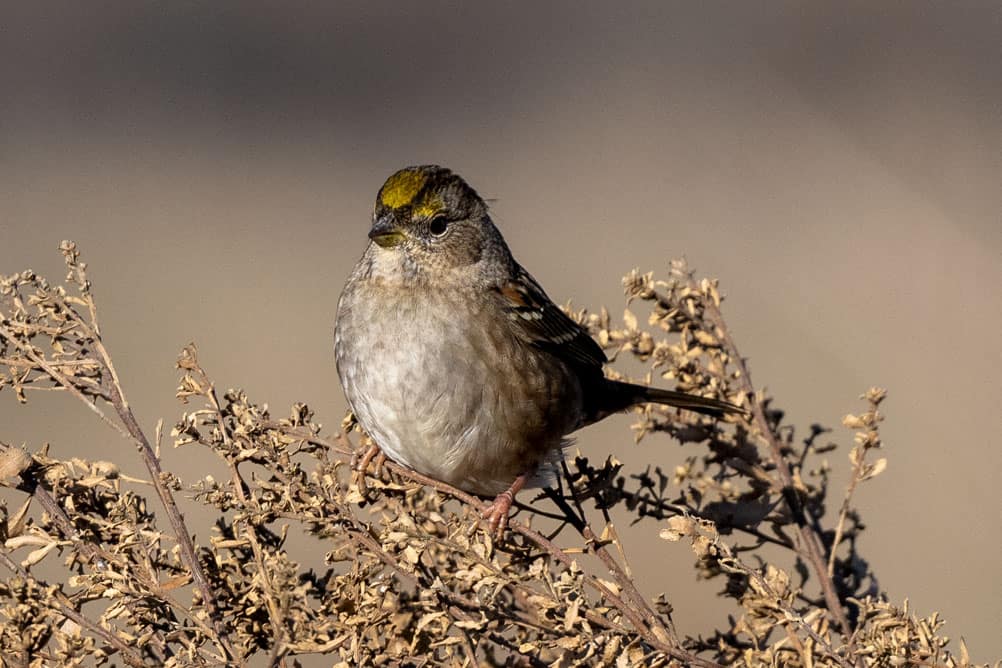
The golden-crowned sparrow is a common backyard bird species throughout the pacific coast.
Description: The golden-crowned sparrow is a small bird about 7″ long. They’re primarily brown with a gray face, bright yellow forecrown, black eyebrows, and white tips on wings. In the winter, the cap fades to a muted yellow and eyebrows to a soft gray. The bill also becomes darker. The females are similar.
Diet: Seeds, buds, berries, and insects.
Feeder food: Black-oil sunflower seed, hulled sunflower seed, safflower, cracked corn, peanut hearts, millet, and milo.
Habitat: In winter can be found in thickets, chaparral, backyards, and city parks. During breeding season they prefer treelines, and patches of willow & adler trees along the Alaskan and British Columbian coasts
Nesting: Golden-crowned sparrows built a cup-shaped nest comprised of twigs, bark, moss and other vegetation. It’s usually placed on the ground concealed by vegetation. They have 1-2 broods/season, 3-5 eggs/brood, incubation is for 11-12 days, and fledglings leave the nest at 9-11 days.
Migration: Golden-crowned sparrows are migrators. In the spring they migrate north to Alaska and British Columbia to nest and raise their young. Then in the fall, they migrate south along the Pacific coast and inland Washington, Oregon, California and along the Nevada/Arizona/California state lines.
Range Map
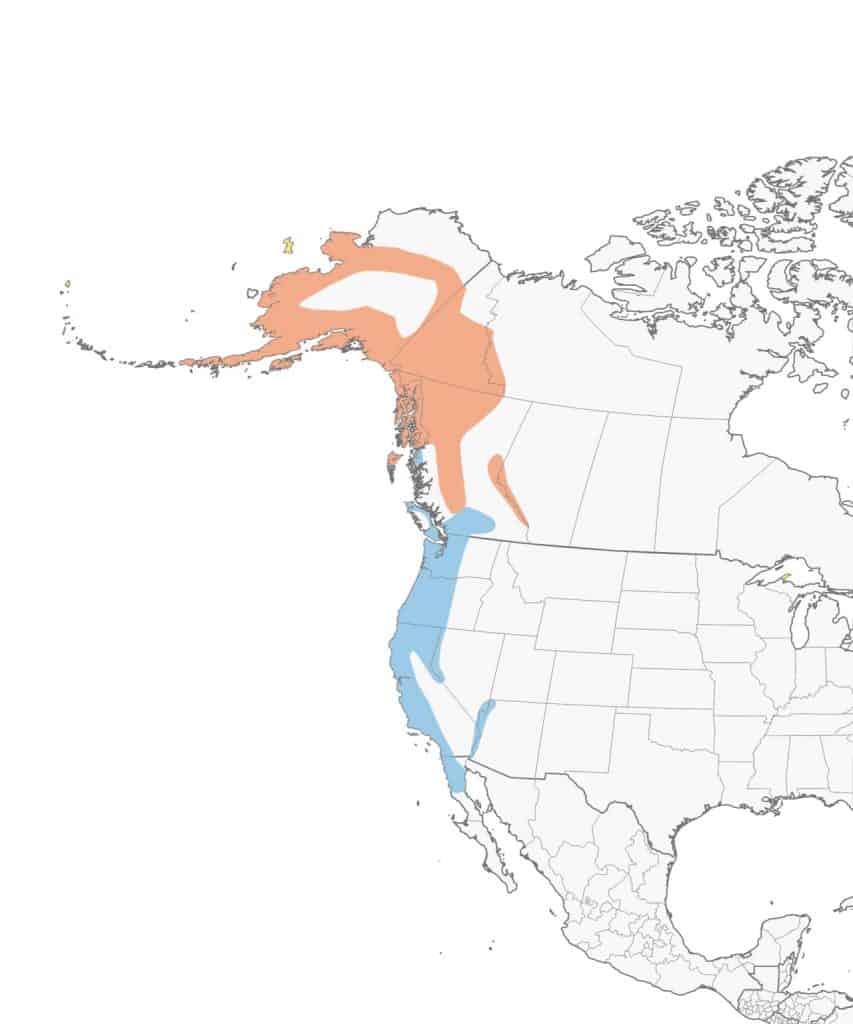
Hairy Woodpecker
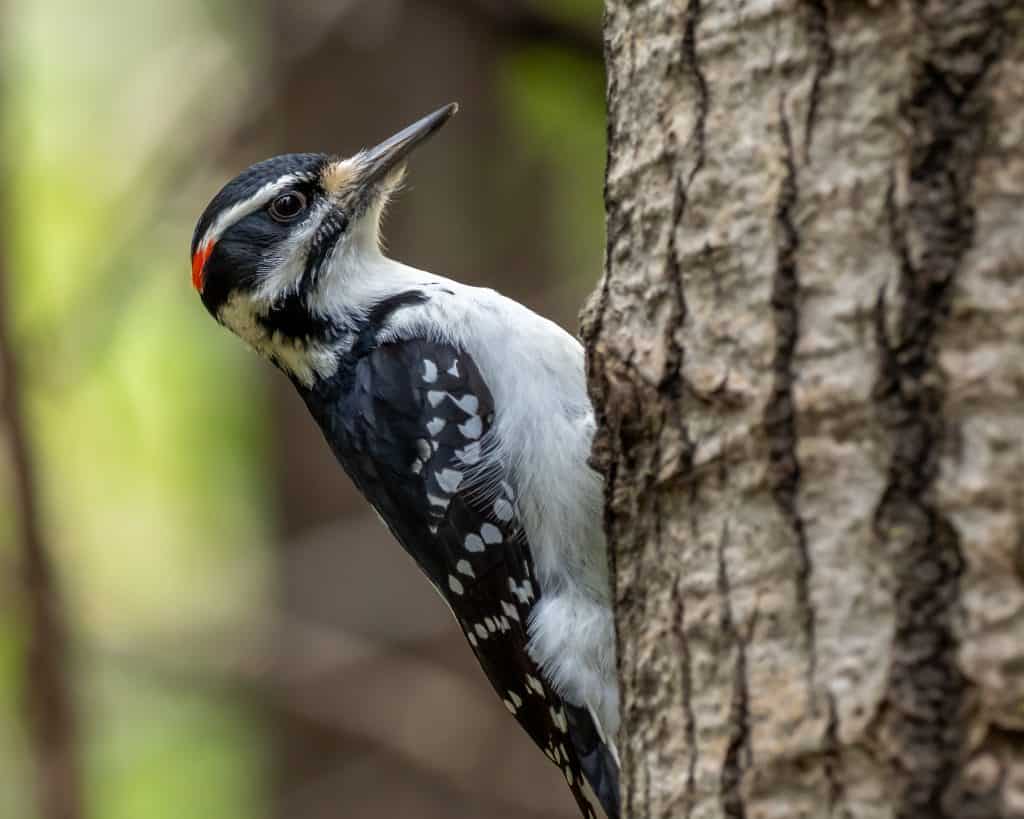
Hairy woodpeckers are common backyard bird species.
Appearance: A medium-sized black-and-white bird about 9″ long with a white belly, and black wings with white spots. A white stripe runs down the back. They have a red mark on the back of the head and a long black bill. The Female is the same except with no red mar
Diet: Insects, seeds, nuts.
Feeder food: Suet, hulled peanuts.
Habitat: Mature forested areas, urban and suburban areas where dense trees are found.
Nesting: They are cavity nesters generally excavating their own holes. They have 1 brood/year, and 3-6 white eggs per brood. Incubation is 11-15 days.
Migration: Hairy woodpeckers are not migrators. They remain in their year-round range all seasons of the year.
Year-round range: All US states, every Canadian province except Nunavut, Mexico, and Central America.
Range Map
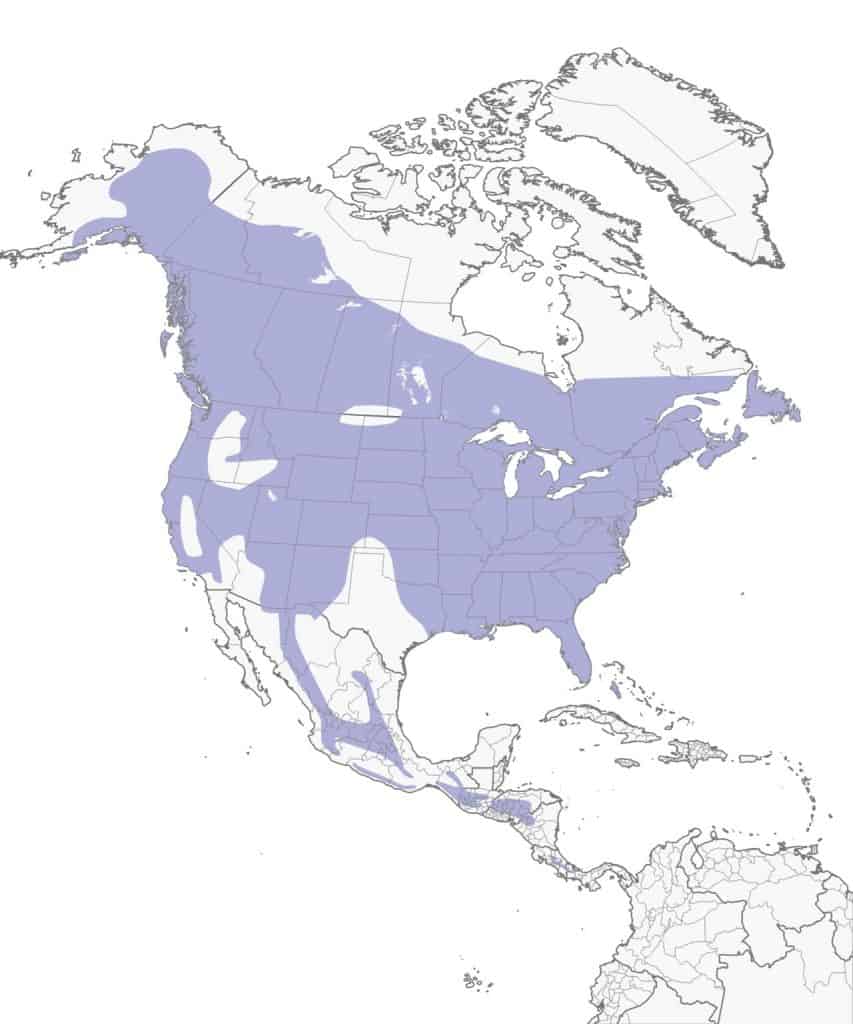
Hoary Redpoll
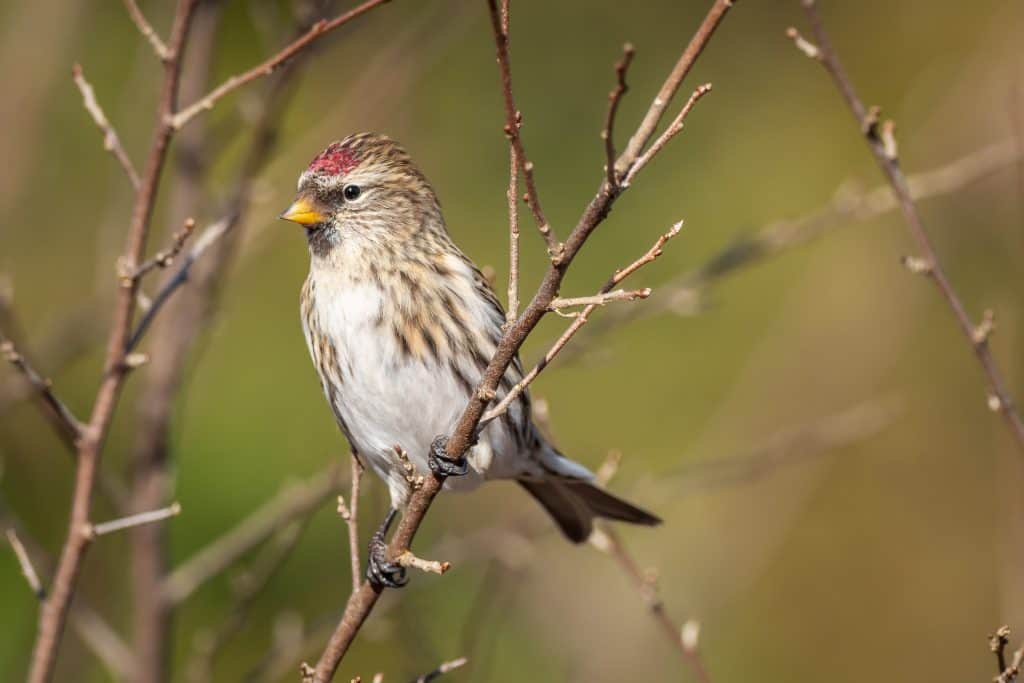
Hoary redpolls are common backyard bird species.
Appearance: Hoary redpolls are small birds about 5″ long with brown/gray streaks throughout, pink belly, charcoal tail & wings, and the infamous red patch on the forehead. Their bill is yellow, short, and stubby. Females are similar with less streaking and a white belly.
Diet: Seed from trees, insects, and spiders.
Feeder Food: Thistle (nyjer) seed.
Habitat: Hoary redpolls live in the far north of Canada and prefer areas with scattered shrubs or short trees.
Nesting: Hoary redpolls build a cup-shaped nest of twigs and grasses, then place them in a shrub or shorter tree. They have 1 brood/year, and 1-6 green/blue eggs/brood.
Migration: Hoary redpolls are migrators. In spring, , they migrate north to the northern edges of Canada. Then in the fall, they migrate south into Alaska, northern parts of North Dakota, Minnesota, Michigan, and southern Canada. They remain in their year-round range all seasons of the year but that area is confined to the western coast of Alaska and northeast Nunavut (Canada).
Year-round range: Western coast of Alaska, and the eastern part of Canada’s Nunavut.
Breeding range: Northern edge of Alaska, Yukon Territory, and Northwest Territories.
Winter range: Alaska, northern parts of North Dakota, Minnesota, and Michigan, and Canada’s Yukon Territory, Northwest Territories, northeast Alberta, Saskatchewan, Manitoba, Ontario, and Quebec.
Range Map
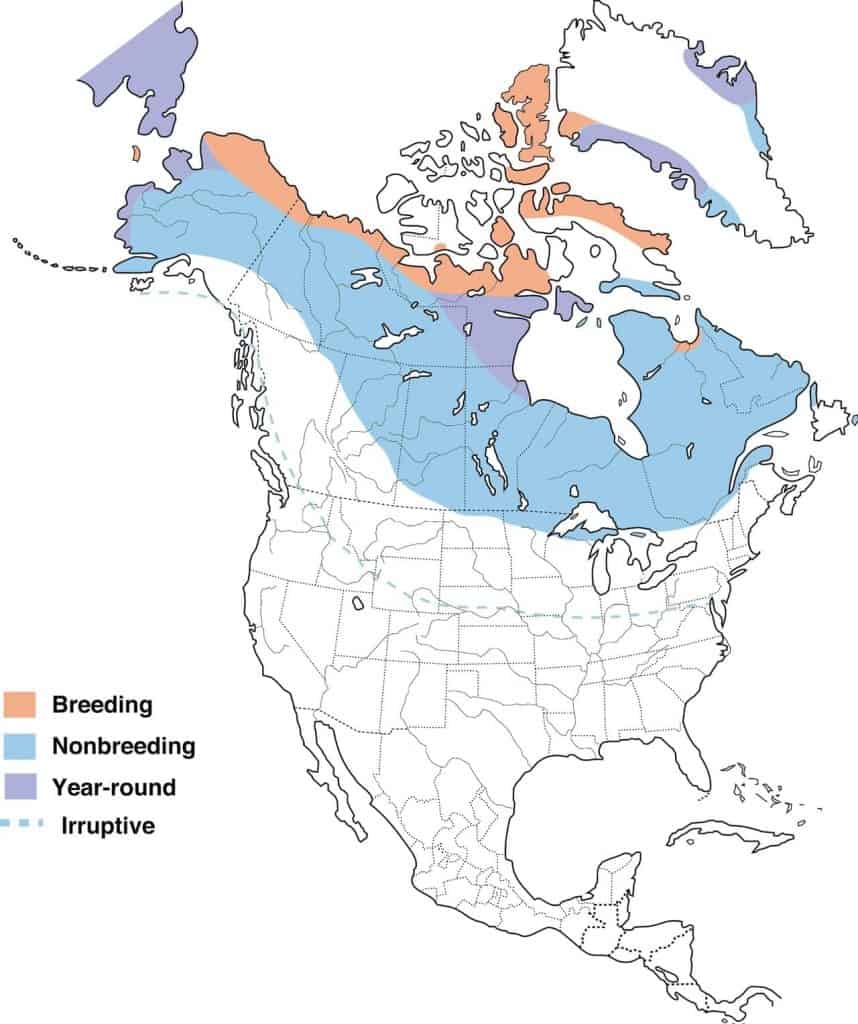
House Finch
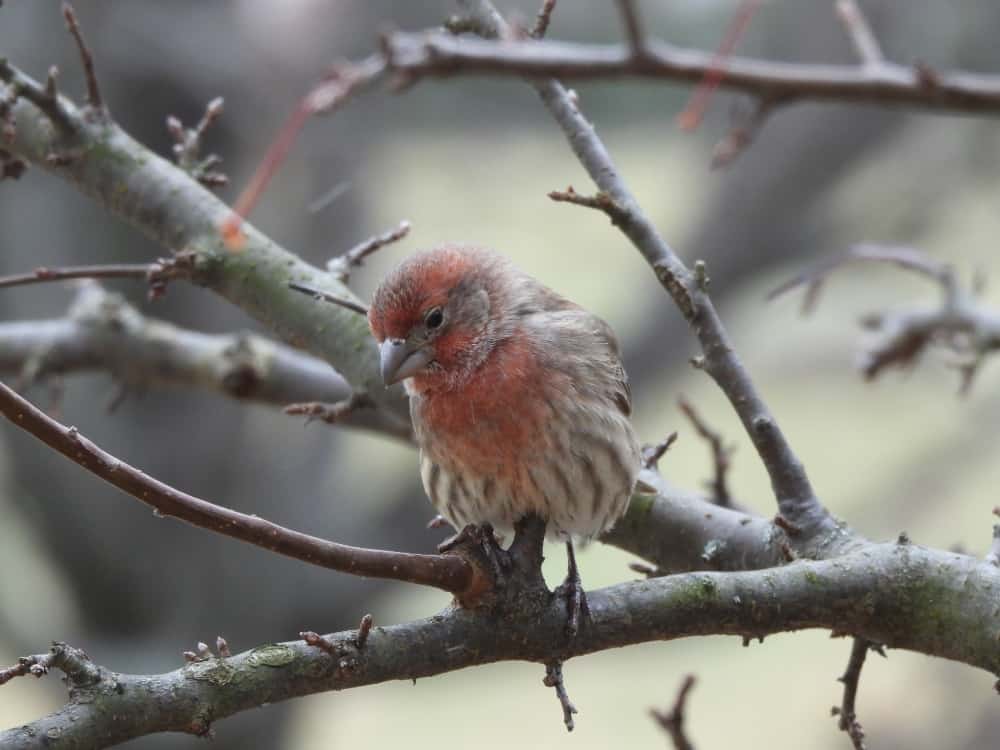
House finches are common backyard bird species throughout most of the U.S.
| Appearance | They’re a small bird about 5″ long, orange/red face chest, and rump. Brown wings streaked with white. White belly with brown streaks. The Female and juvenile are brown with streaks of white. |
| Diet | Seeds, fruit, tree buds. |
| Feeder Food | Black oil sunflower seed is their favorite. |
| Habitat | House finches are found in the western and eastern parts of the US. They prefer to live around human dwellings (buildings, backyard trees, shrubs, and barns. Also are found in parks and other urban areas. |
| Nesting | Nest: Small cup about 3-7″ wide, constructed from stems, leaves and plant roots, and feathers. The nests are built in coniferous or deciduous trees or even any place that holds a nest (ledges, vents, hanging plants). Broods: 1-6 broods/season Clutch: 2-6 eggs/brood (typical is 4-5) Egg color: Eggs are pale blue and speckled with black and purple dots. Egg size: 0.6 – 0.8 inches by 0.5 inches Incubation: 13-14 days and the young fledge between 12-19 days. |
| Migration | House finches are not migrators They remain in their year-round range for all seasons. Year-round range: Every US state except North & South Dakota, southern Ontario & British Columbia, and Mexico. |
Range Map
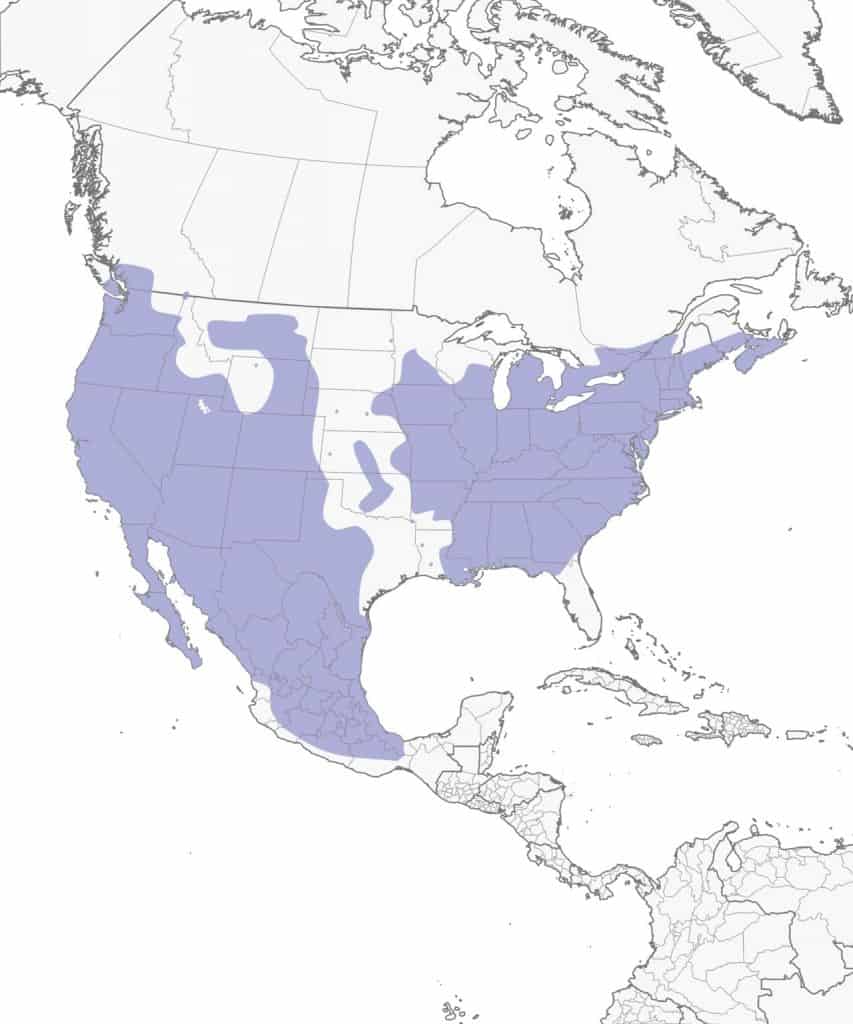
House Sparrow
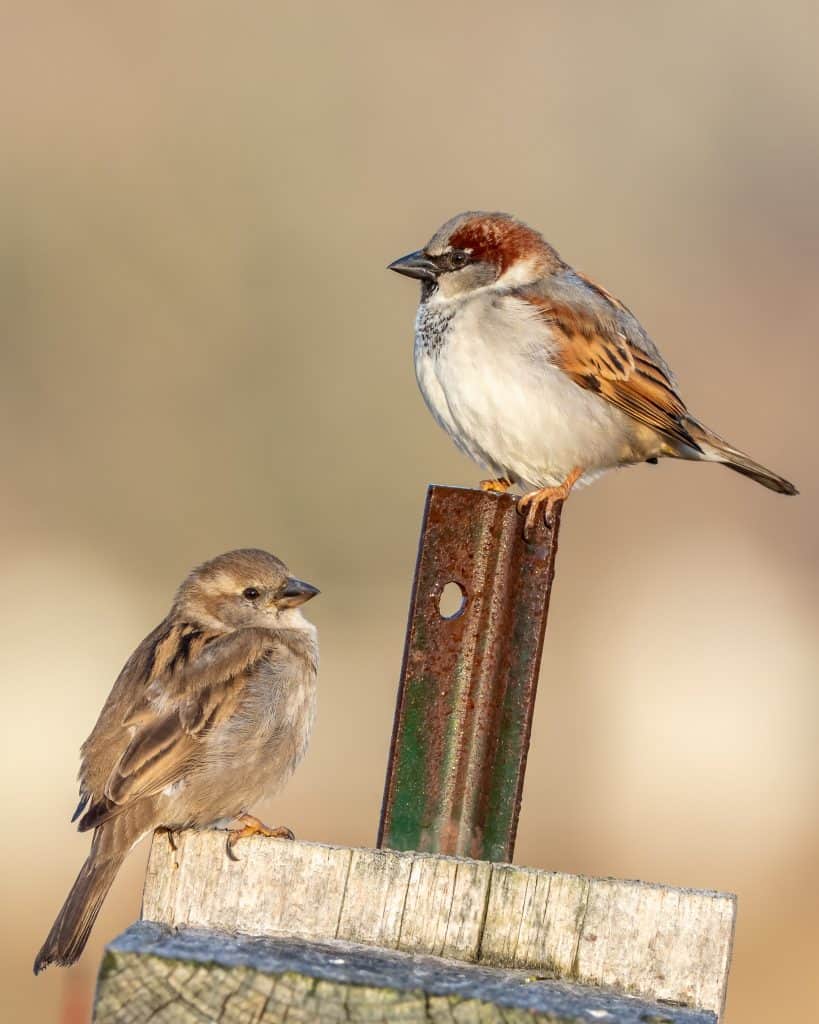
Much to the dismay of many backyard birders, the house sparrow is a very common backyard bird species.
Appearance: The house sparrow is a small bird about 6″ long. They’re brown with a large black spot on the chin down to the chest. They have white wing bars, a gray belly & crown. The female is a bit smaller, all light brown and not black.
Diet: Seeds, insects, fruit.
Feeder food: Black oil sunflower seed, cracked corn, peanut hearts, millet, and milo.
Habitat: Around people and buildings in the city, towns, villages, suburbs, and farms.
Nesting: Dome-shaped nest within a cavity. They have 2-3 broods/year, and 4-6 white eggs with brown markings. Incubation is 10-12 days.
Migration: House sparrows are not migrators. They remain in their year-round range every season of the year. Their year-round range is massive encompassing nearly every part of North America (except Alaska and far northern Canada), Mexico, and Central America.
Range Map
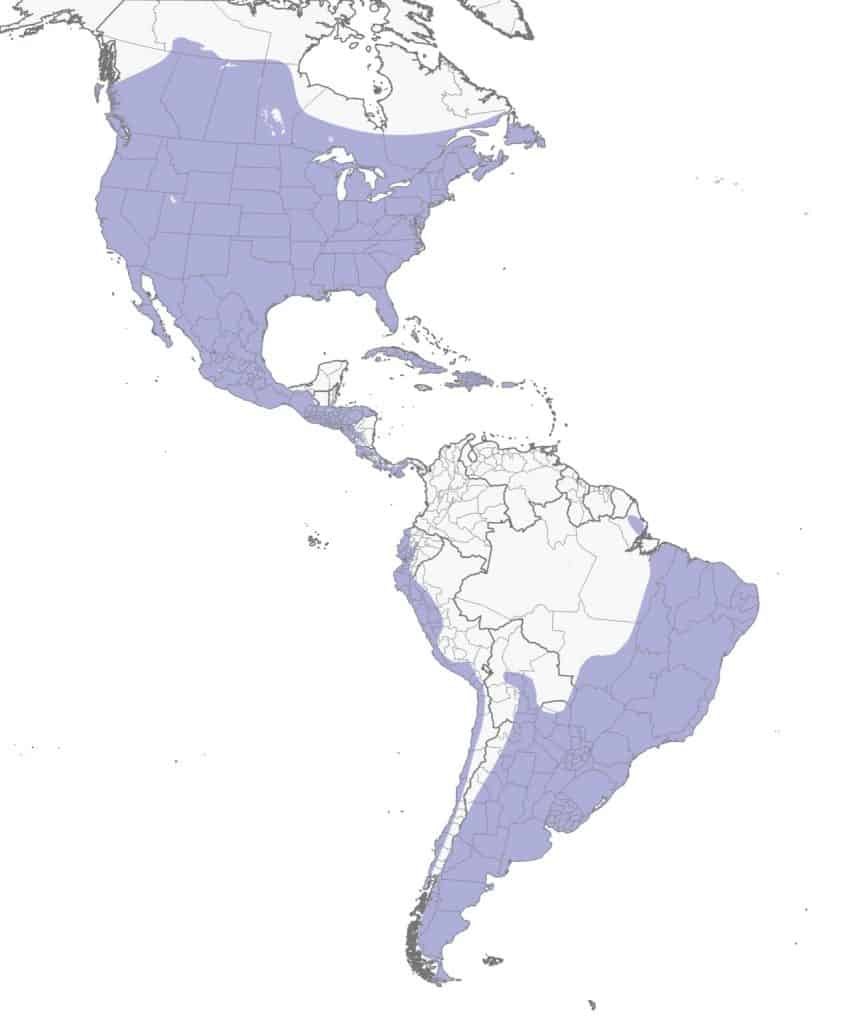
Lesser Goldfinch

Lesser goldfinchesThe house finch is a common backyard bird species throughout most of the U.S. except the central states.
Appearance: The house sparrow is a small bird about 6″ long. They’re brown with a large black spot on the chin down to the chest. They have white wing bars, a gray belly & crown. The female is a bit smaller, all light brown and not black.
Diet: Seeds, insects, fruit.
Feeder food: Black oil sunflower seed, cracked corn, peanut hearts, millet, and milo.
Habitat: Around people and buildings in the city, towns, villages, suburbs, and farms.
Nesting: Dome-shaped nest within a cavity. They have 2-3 broods/year, and 4-6 white eggs with brown markings. Incubation is 10-12 days.
Migration: House sparrows are not migrators. They remain in their year-round range every season of the year. Their year-round range is massive encompassing nearly every part of North America (except Alaska and far northern Canada), Mexico, and Central America.
Range Map

Mourning Dove
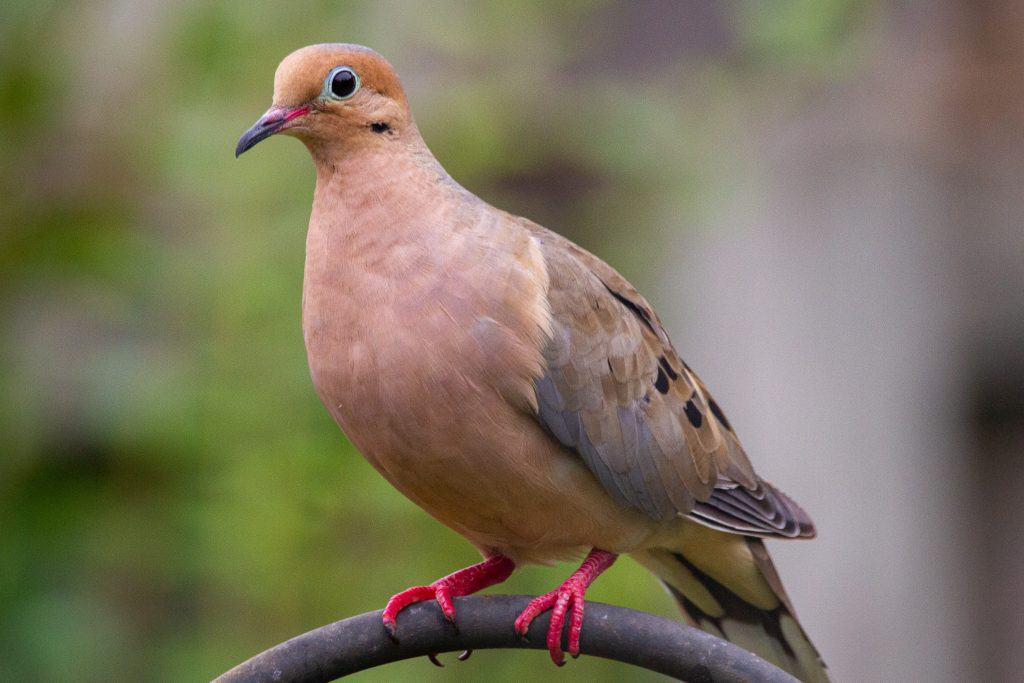
Mourning doves are common backyard bird species.
| Appearance | The mourning dove is a common backyard bird species. It’s a large bird about 12″ long and smooth with fawn colors. Black spots on the wings and tail. A single black spot below and behind the eyes. Wide brown tail with white edges. Red-orange legs. Gray patch between the head and back and iridescent colors around the neck. Large black eyes with light blue around the eyes. Pointy bill. |
| Diet | Seeds. |
| Feeder Food | Will come to eat seeds that drop below the feeder. |
| Habitat | Open areas. |
| Nesting | They build a platform-style nest that’s located on a tree branch. Sometimes will nest on the ground. They have 2 broods/year and 2 eggs/broods that are white. Incubation is 13-14 days. |
Range Map
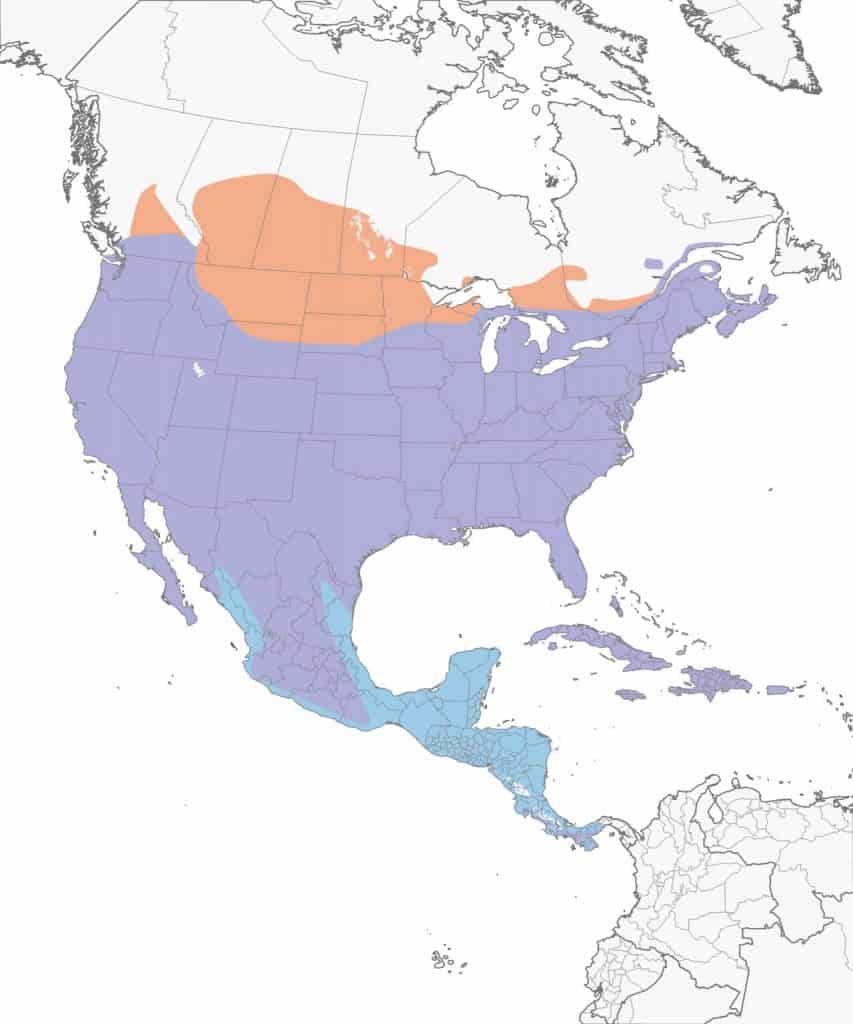
Northern Cardinal
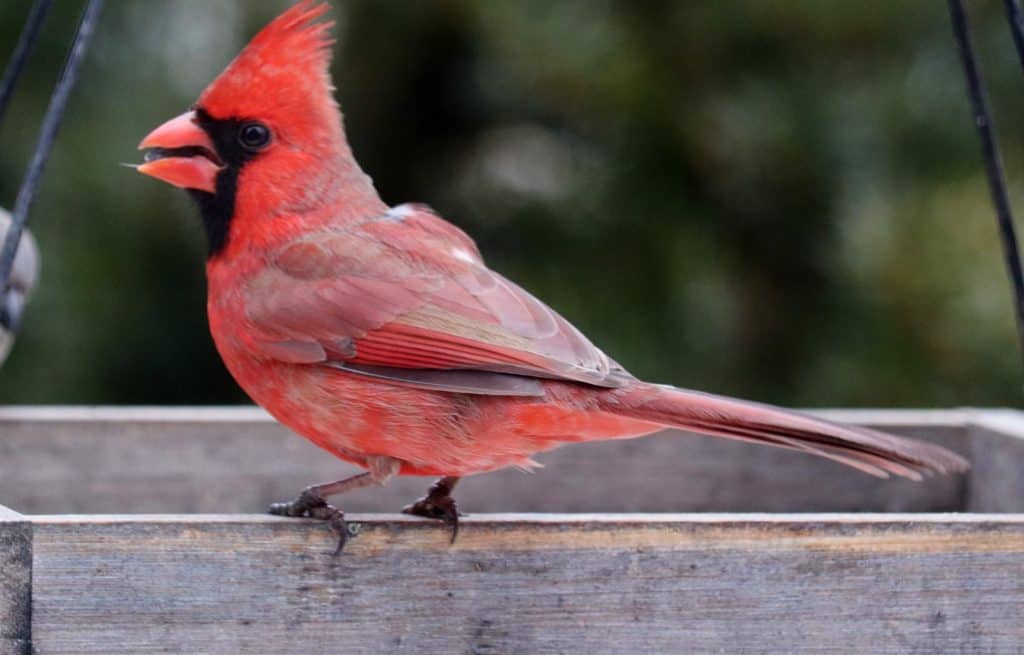
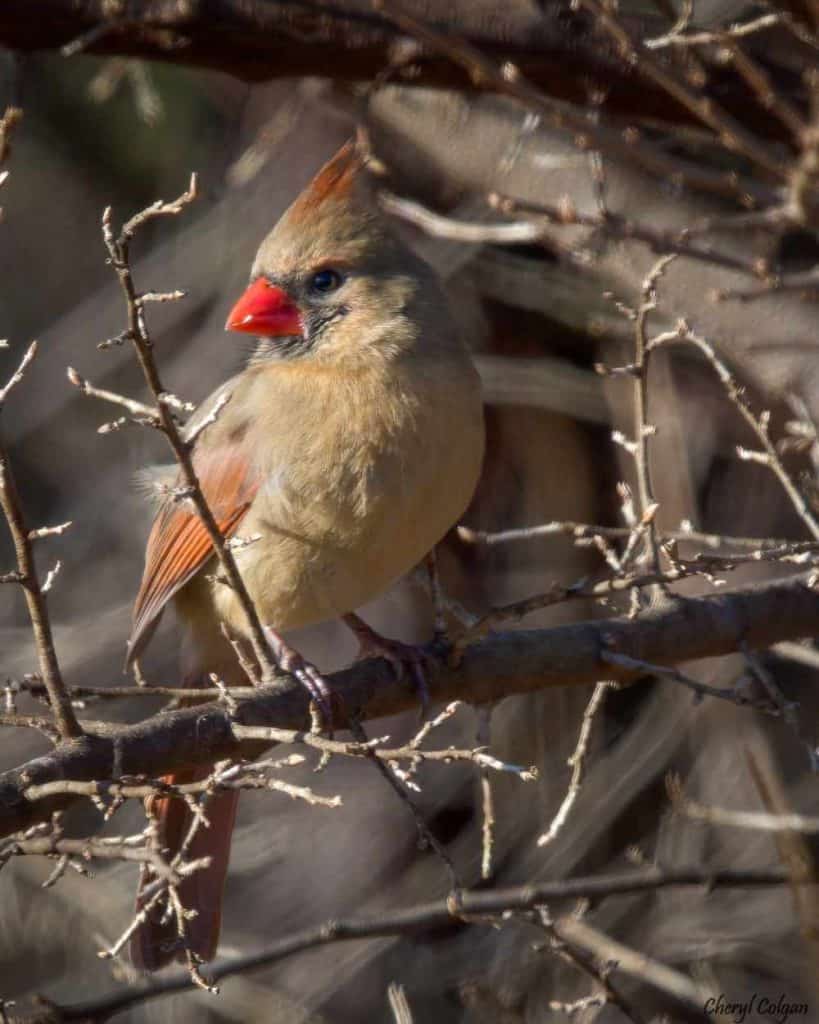
While they may not come in flocks, northern cardinals are common backyard bird species within their year-round range.
Appearance: Northern cardinals are medium-sized bright red birds about 8 1/2″ long with a black mask, red crown, orange beak, and black areas on wings and tail. The female also has an orange beak but
Diet: Insects, spiders, centipedes, snails, and slugs. Fruit and seeds from plants.
Feeder food: Black-oil sunflower seed, safflower seed, mealworms, striped Sunflower seed, hulled peanuts, and cracked corn.
Habitat: Edges of wooded areas to thickets, tangled vines, city parks, and our backyard gardens.
In the southwest live around desert washes, areas thick with mesquite, and along the riverbanks of wooded areas.
Nesting: Open-cup nest in a dense shrub about 3-10′ up. They have 2-3 broods/year, and 1-5 eggs/brood that are beige with brown spots. Incubation is 12-13 days.
Migration: Northern cardinals are not migrators. They remain in their year-round range every season of the year.
Year-round range: Eastern half of the US, Arizona, New Mexico, and Mexico.
Range Map
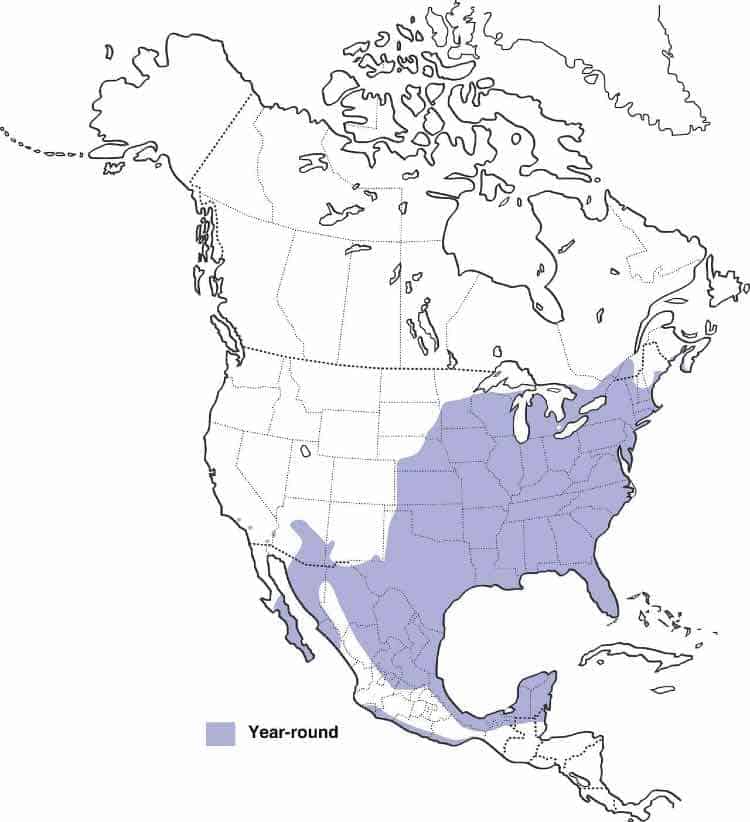
Northern Flicker
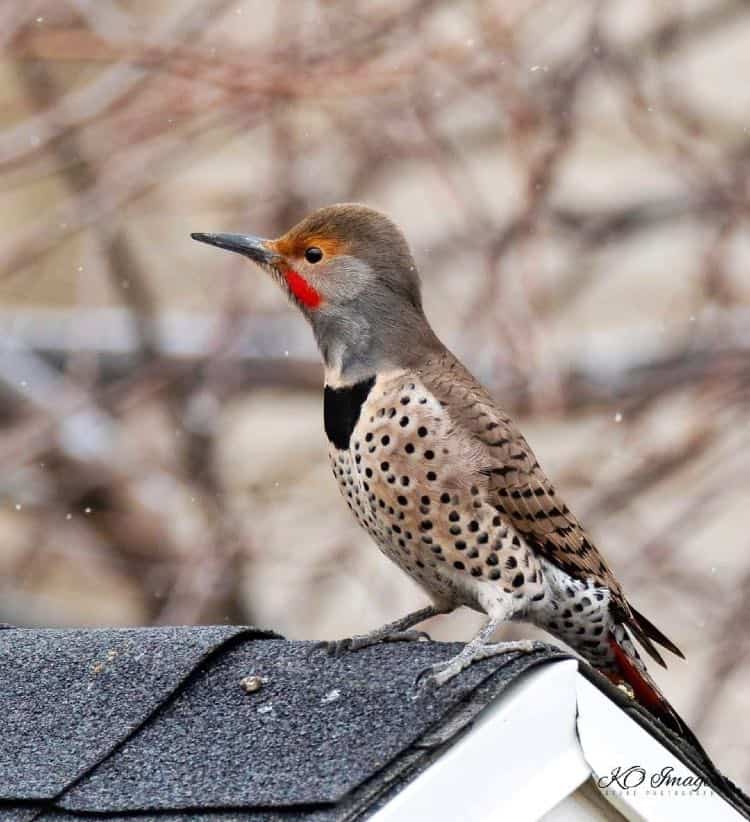
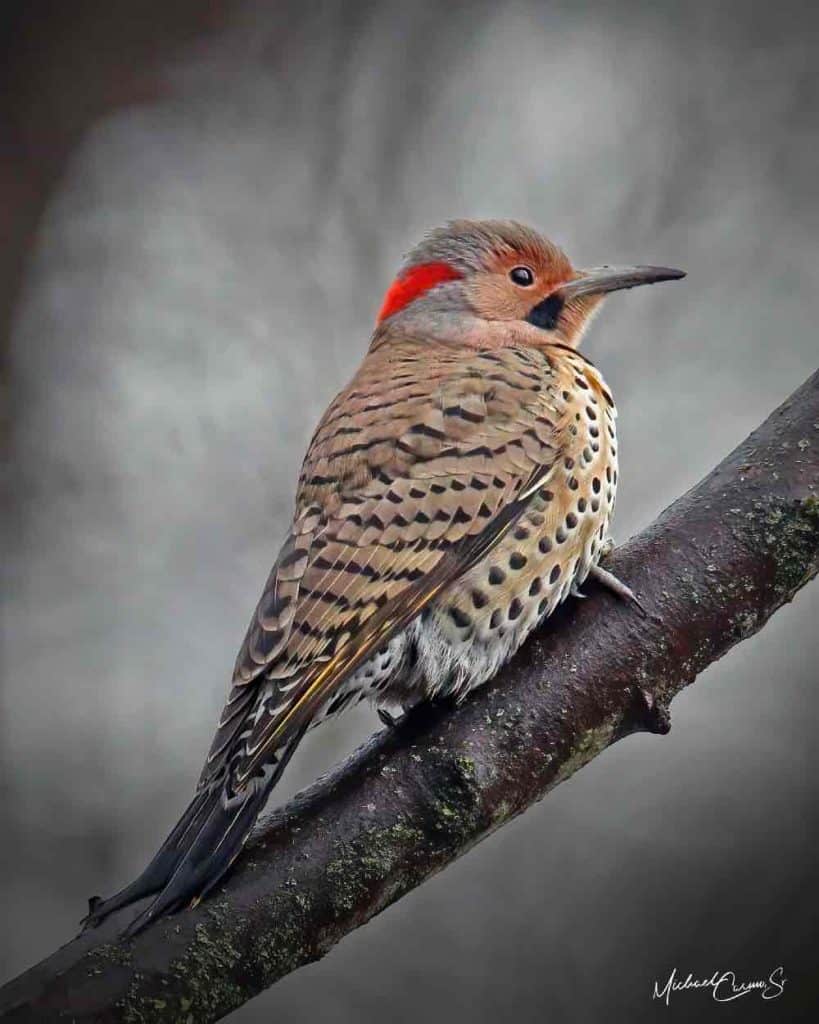
Northern flickers are a common backyard bird species.
Appearance: A large bird about 12.5″ long. They have brown backs with black bars, a black crescent on the upper chest, and white with black spots on the belly and underparts.
• In the eastern part of their range, they are referred to as “yellow-shafted northern flickers” and have bright yellow underwings and undertail. They have a gray crown, tan face, and a red patch on the nape. The male has a black swipe on his cheek, the female does not.
• In the western part of their range, they are referred to as “red-shafted northern flickers” and have pink underwings and undertail, brown crown, gray face, and crown & nape are brown. The male has a red swipe on his cheek, the female does not
Diet: Insects, especially ants.
Feeder food: Hulled peanuts and suet.
Habitat: Open areas near trees.
Nesting: They are cavity nesters and have 1 brood/year. 5-8 white unmarked eggs per brood. Incubation is 11-14 days.
Migration: Northern flickers are migrators. Scientists believe the timing and duration of their migration from the breeding range to their winter range are dependent on weather. They generally migrate at night and travel in large but loose flocks of up to 100 or so birds.
Year-round range: Each US state as well as parts of British Columbia,
Breeding range: Alaska, Canada, and inland parts of their year-round range in Washington, Oregon, and California.
Winter range: Many will winter in the year-round range while others head further south into southeast California, southwest Arizona, Texas, and Mexico.
Range Map
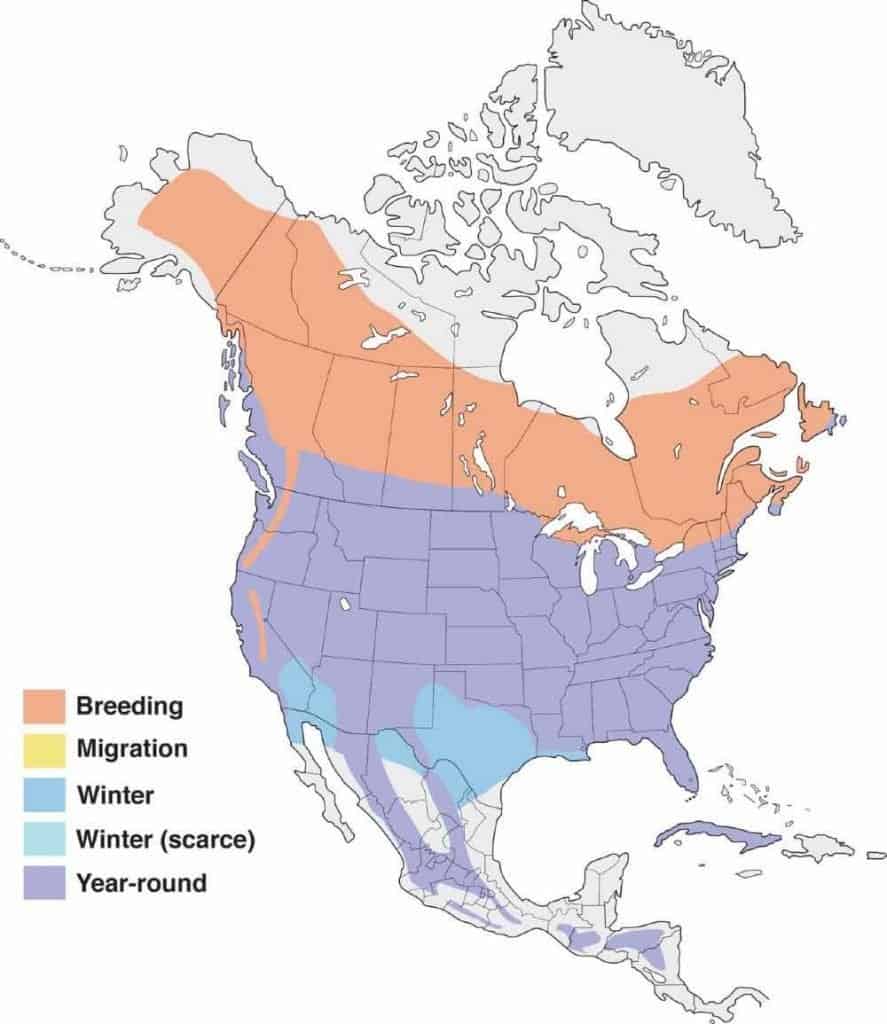
Northern Mockingbird
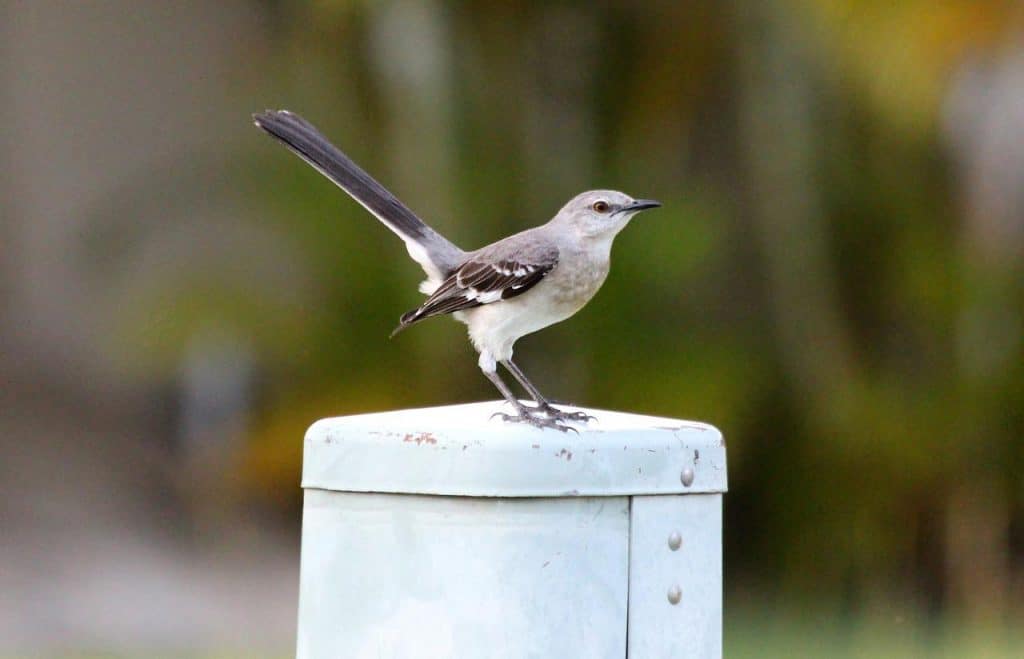
Northern mockingbirds are a common backyard bird species.
Appearance: Northern mockingbirds are about 10″ long. They have gray above and white below. Wings are dark gray with patches of white. They have long beaks and yellow eyes.
Diet: Insects and berries.
Feeder food: Suet
Habitat: Northern mockingbirds prefer thickets and brushy areas with open areas nearby.
Nesting:
- Nest: They nest in a thick shrub or tree between 1-10′ up. Northern mockingbird males select several nesting sites and begin building nests in each. The female will pick her favorite and finish the nest. They won’t abandon these nests but move to another with each brood
- Brood: 2-3 broods/season
- Clutch: 2-6 eggs/brood
- Egg color: Light blue to greenish-white sporting brown or red spots.
- Egg size: 1.1 inches by 0.8 inches
- Incubation: 12-14 days and fledglings leave the nest at 11-15 days.
Migration: Northern mockingbirds do not migrate. They remain in their year-round range all seasons of the year.
Year-round range: Every US state, the southern edges of Canada’s British Columbia, Alberta, Saskatchewan, Manitoba, Ontario, Quebec, and Mexico.
Did you know the Mockingbird is a symbol of adaptability and creativity? When you encounter one it may be trying to encourage you to be open to new ideas or explore your creative potential.
Range Map
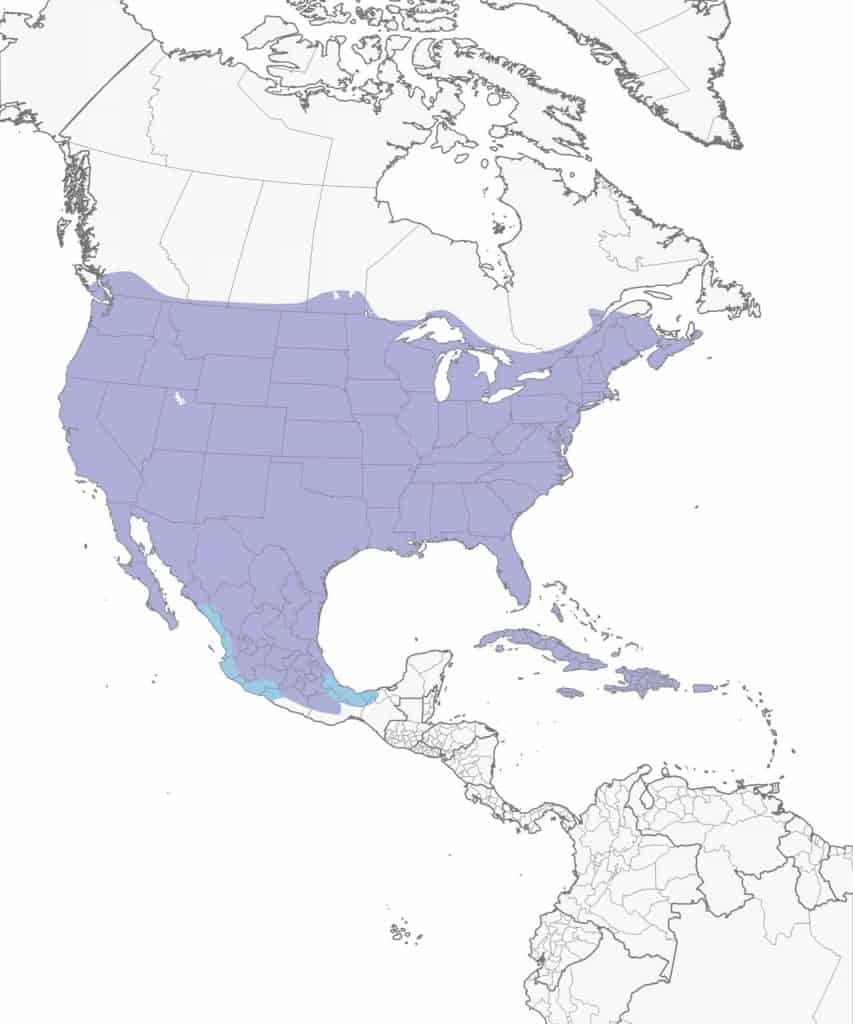
Northern Shrike
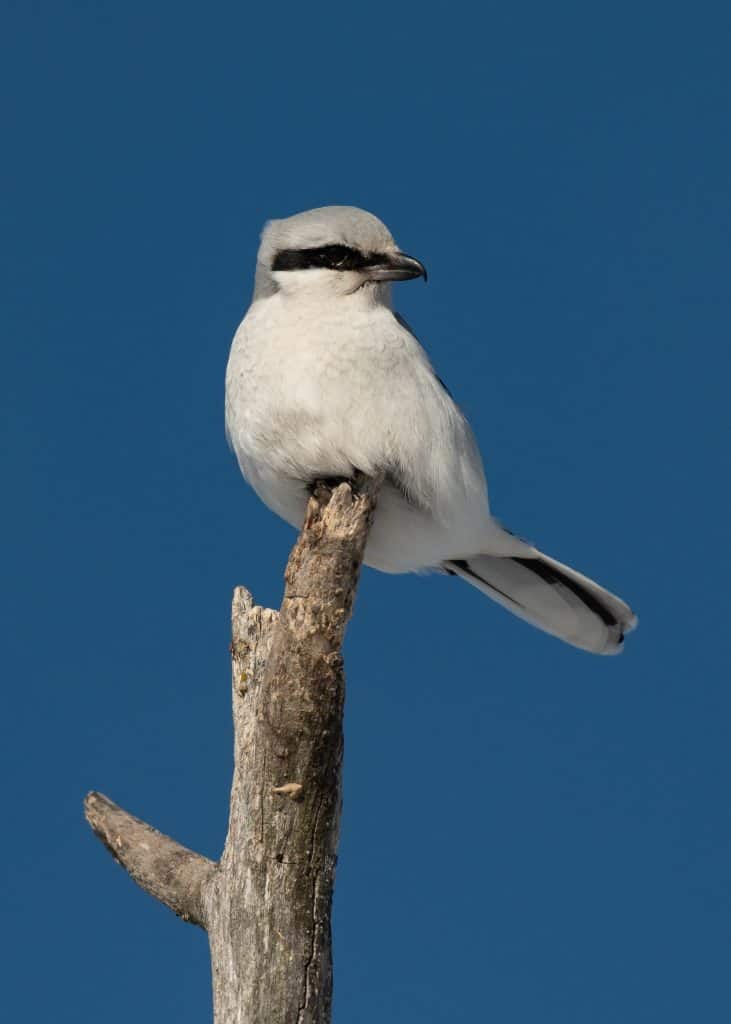
Northern shrikes are common backyard bird species.
Appearance: Northern shrike is a medium-sized bird about 9.5″ long. They’re gray with white bellies, black wingtips & tails, and a black mask that extends from each eye back to the ear area. Their short bill is notched at the end. Females are the same. Immature northern shrikes are browner.
Diet: Insects, birds, and small mammals.
Feeder food: They may show up at the feeder to hunt feeder birds!
Habitat: Northern shrikes prefer the northern tundra regions, especially where the thick forest meets the tundra. They also are found in open areas.
Nesting: Northern shrikes nest in trees and shrubs, usually 8 feet or higher. They’re not opposed to reusing nests from other birds. They have 1 brood/season, 4-9 gray/green or white eggs/brood, incubation is 14-21 days, and fledglings leave the nest after about 20 days.
Migration: Northern shrikes are migrators. In the spring they migrate north into Alaska and northern Canada regions to breed. Then in the fall, they migrate south into the northern half of the US and southern Canada.
Breeding range: Alaska, Canada’s Yukon Territory, Northwestern Territories, northern Ontario, and Quebec.
Winter range: Northern US states, western states, and Canada’s northern provinces.
Range Map
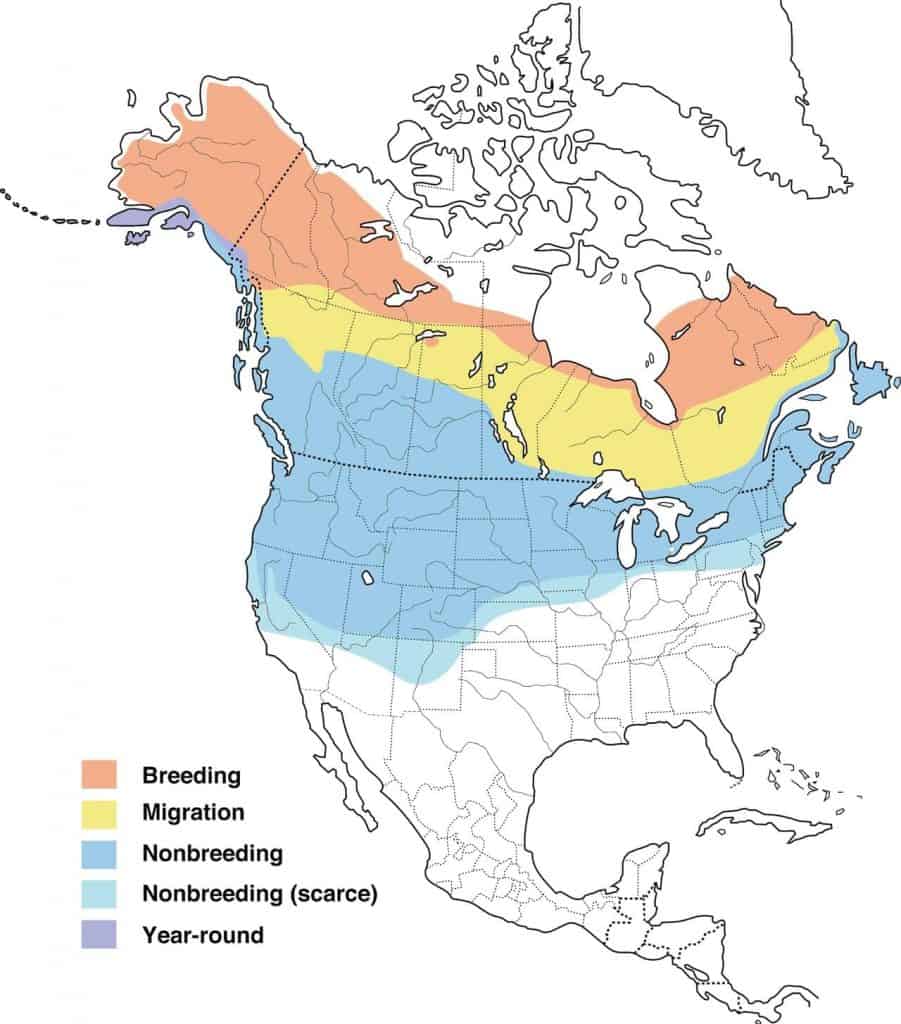
Oak Titmouse
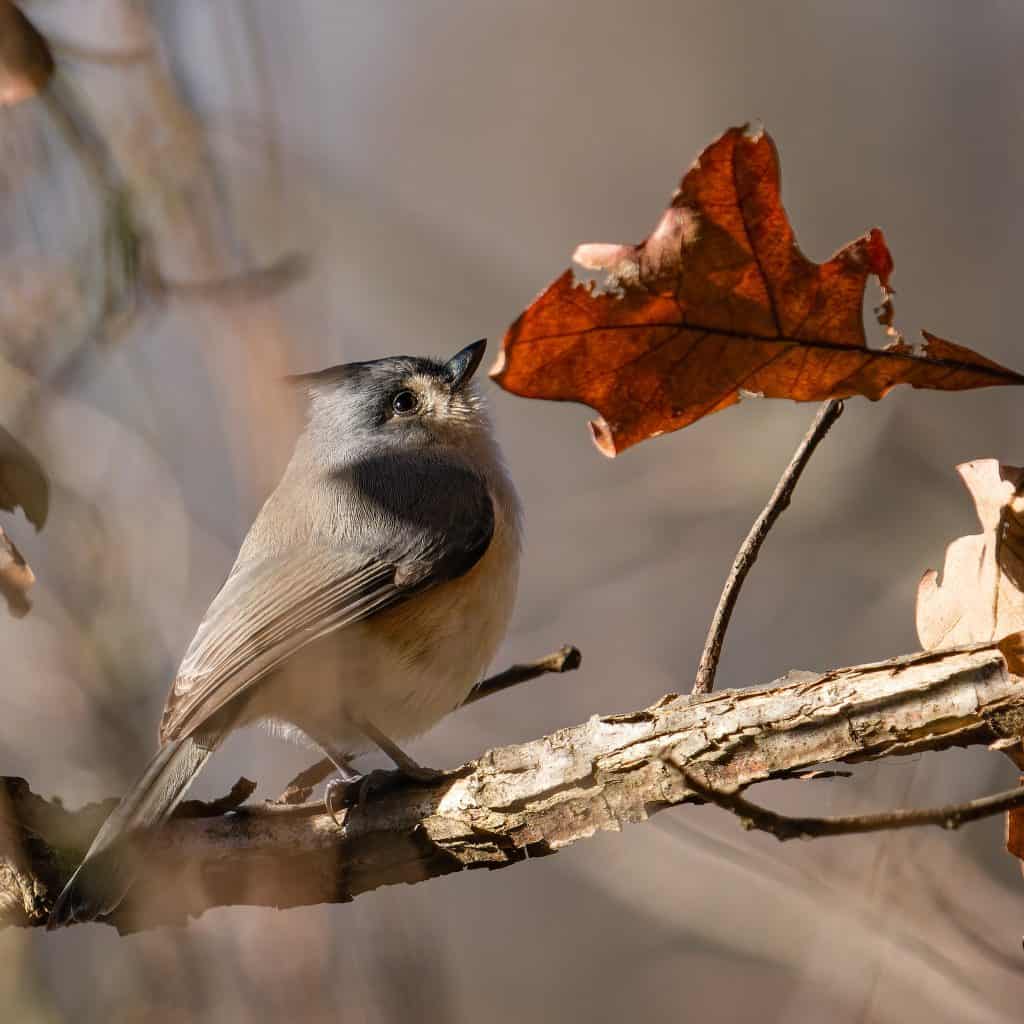
Oak titmice are common backyard bird species.
Description: The oak titmouse is a small bird about 5″ long. They have a short crest that they raise/lower depending on level of agitation. They’re primarily grayish brown with paler colored underparts. The females look the same.
Diet: Insects, seeds (especially acorns), buds, berries, and fruits.
Feeder food: Hulled sunflower seed, black-oil sunflower seed, safflower seed, whole peanuts, suet, and mealworms.
Habitat: Wooded areas.
Nesting: Oak titmice are cavity nesters. They prefer an old woodpecker hole or other natural cavity but will also use a manmade nest box. They have 1-2 broods/season, 6-7 white (sometimes speckled) eggs/brood, incubate for 14-16 days, and fledglings leave the nest at about 16-21 days.
Migration: Oak titmice are not migrators. They remain in their year-round range all seasons of the year. Year-round range includes the eastern 1/2 of the U.S.
Range Map
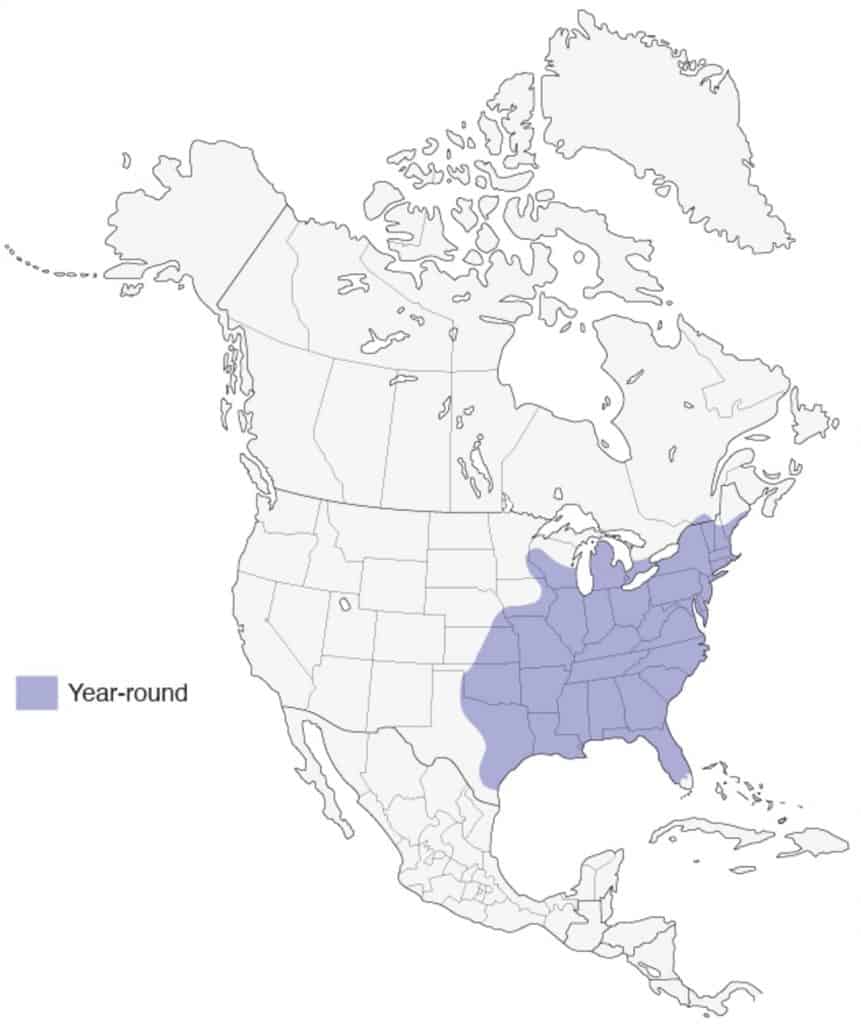
Pileated Woodpecker
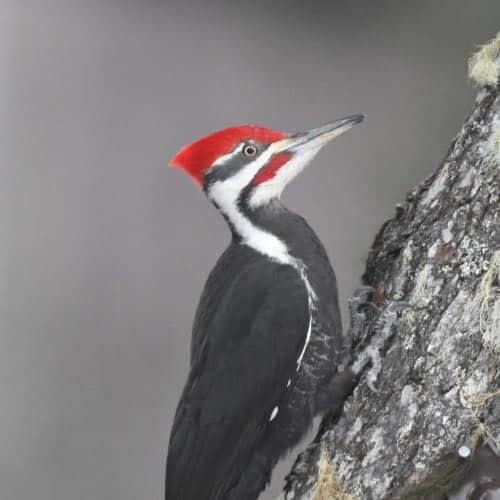
Pileated woodpeckers are common backyard bird species within their range.
Appearance: A large bird about 19″ in length. They’re mostly black with white stripes on their face and neck with white underwings. The flaming red triangle-shaped crest is unmistakable and the male also has a red stripe on his cheek. The female is the same except her crest does not go all the way to her bill. And, she does not have a red stripe on her cheek.
Diet: Insects, especially carpenter ants.
Feeder food: Suet, shelled peanuts, safflower seed, sunflower seed, and
songbird fruit & nut seed mix.
Habitat: Forests and wooded areas that offer tall deciduous (leafy trees like maple & beech), coniferous trees (like evergreen & pine), and lower fruit & nut-bearing trees & shrubs.
Nesting: They excavate their own cavity in a tree. They have 3-6 white eggs per brood and incubate them for 15-18 days.
Migration: Pileated woodpeckers are not migrators. They remain in their year-round range every season of the year.
Year-round range: Canada’s southern provinces, the west coast of Washington, Oregon & California, and the eastern half of the US.
Range Map
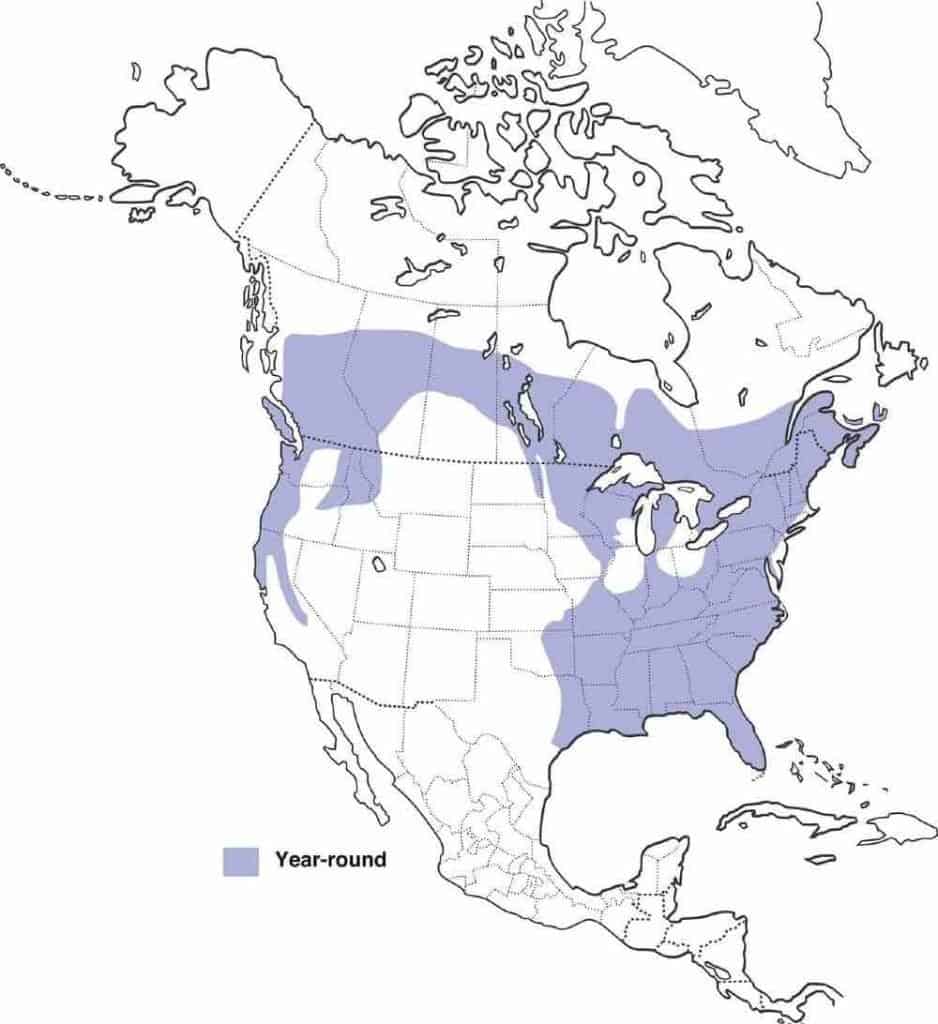
Pine Grosbeak
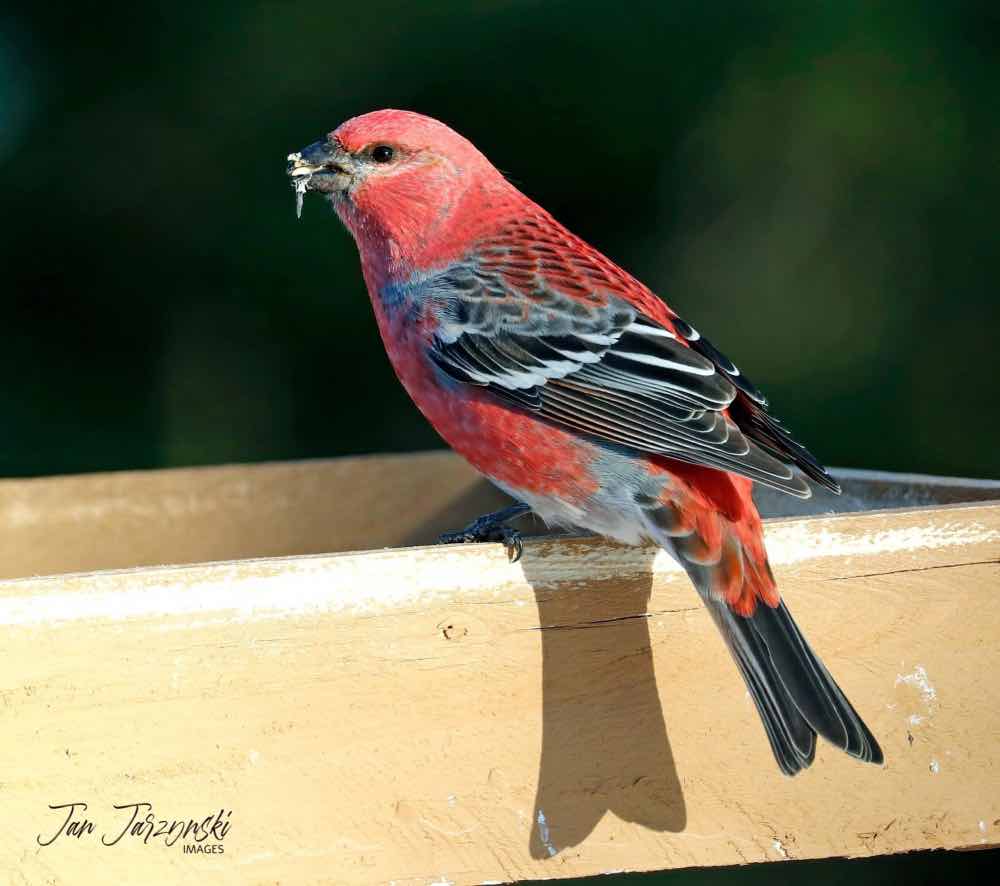
Pine grosbeaks are common backyard bird species.
| Appearance | Sturdy bird approx 8-10″ long, soft pinkish-red with gray & charcoal body, short charcoal beak, medium tail with black tip, wings of black, white, and red. No crown. The Female is gray with a yellow head and tail. |
| Diet | Mostly seeds and fruits from their habitat (pine trees). Sometimes supplements with insects. |
| Feeder Food | Black-oil sunflower seeds and suet. |
| Habitat | Open areas with coniferous trees and deciduous trees in winter. |
| Nesting | About 20′ up in evergreen trees rests their rather large nest constructed with roots and twigs then lined grass, pine needles, and feathers. 1 brood/season, 3-4 eggs/brood, incubation lasts 13-14 days and they fledge between 13-20 days. Eggs are light blue and dotted. |
Range Map
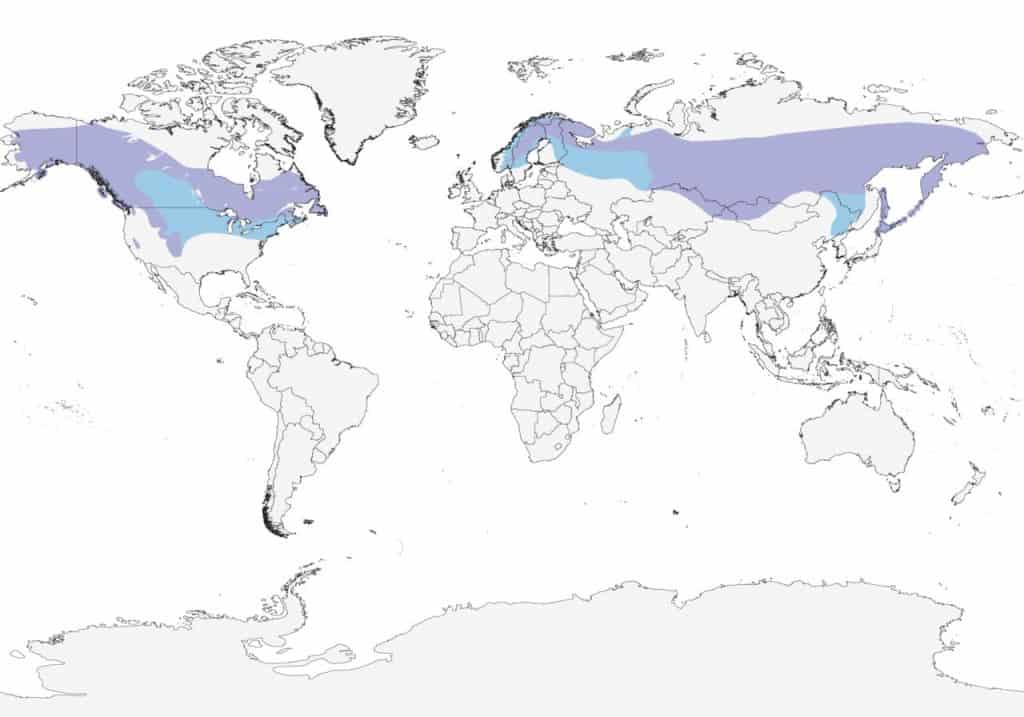
Pine Siskin
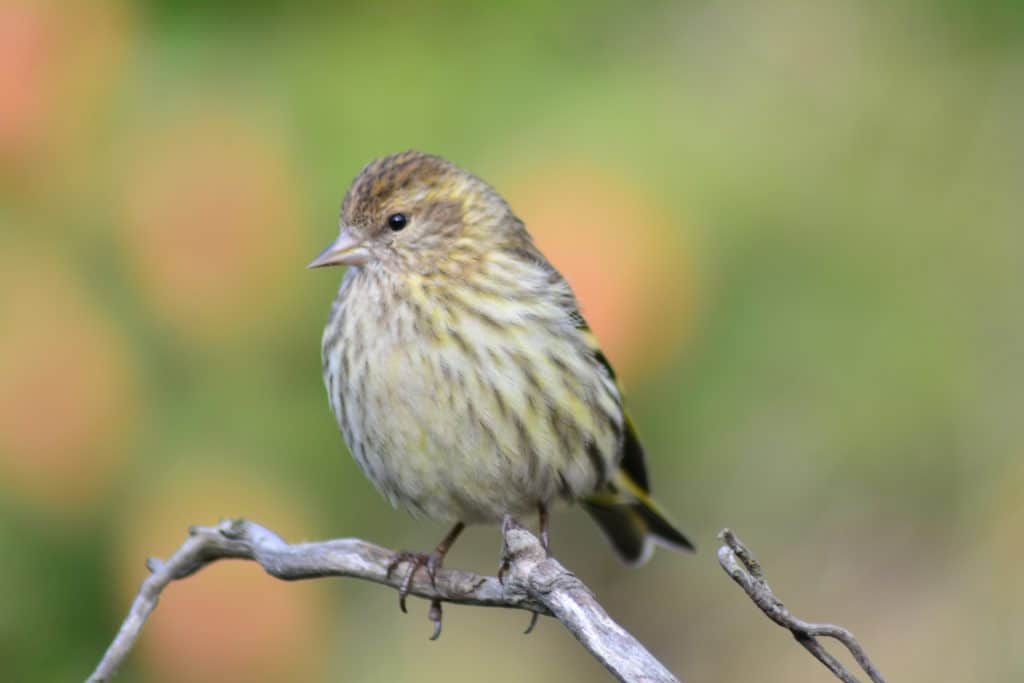
At some point throughout the year, pine siskins are common backyard bird species.
Appearance: Small brown bird about 5″ long with streaks on the back, breast, and belly. They have some yellow in the wing bars at end of the tail. The Female is the same.
Diet: Seeds, insects.
Feeder food: Black-oil sunflower seeds, hulled sunflower seeds, suet & fruit.
Habitat: Open areas, wooded edges.
Nesting: Cup-shaped nest for 2 broods/year. 3-4 eggs/brood that is green/blue with brown spots. Incubation is 12-13 days.
Migration: While some pine siskins remain in their year-round range, most are migrators. In spring, the migrators head south to Canada to breed and raise their young. Then in the fall, they migrate south for the winter.
Year-round range: The northern edge of the US, the Pacific Northwest states, the southern edge of the Canadian provinces, and the central strip of Mexico.
Breeding range: Alaska’s southeastern corner, the southern part of Canada’s Northwest Territories, the northern part of British Columbia, Alberta, Saskatchewan, Manitoba, Ontario, and Quebec.
Winter range: The entire US (outside of the year-round range).
Range Map
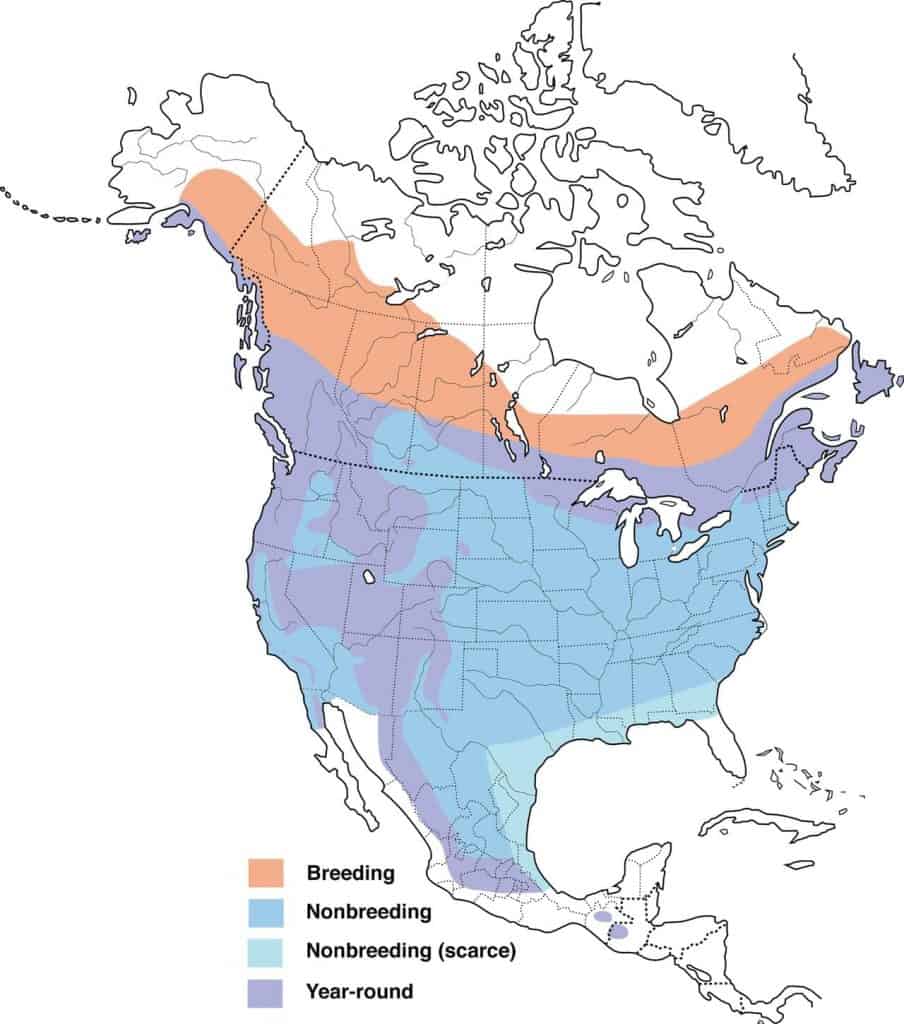
Pine Warbler
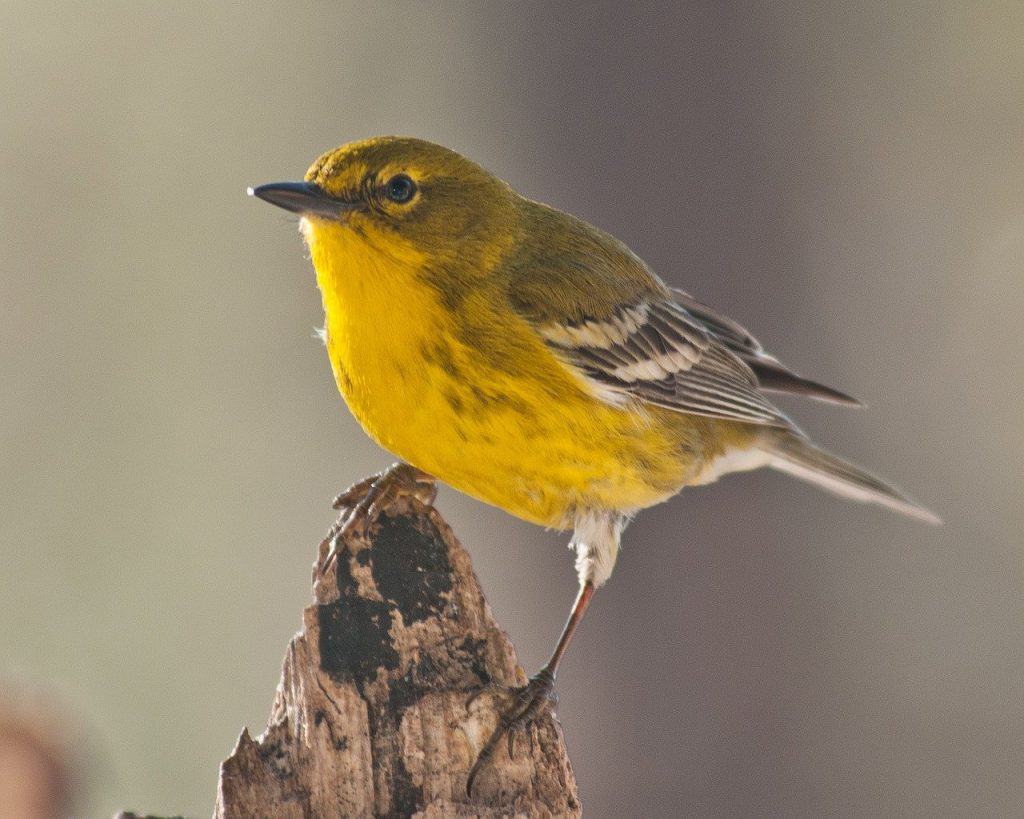
Pine warblers are common backyard bird species in the eastern part of the U.S.
Appearance: The pine warbler is a yellow bird about 5 1/2″ long. The wings are brown with white and rump tan. They have short stubby bills, a subtle dark streak behind the eye, and bright yellow eyering. The female is duller and has a white belly.
Diet: Insects, berries, and seeds.
Feeder food: Millet, sunflower seed, cracked corn, peanuts, and suet.
Habitat: Mixed forested areas.
Nesting: Pine warblers build their open-cup nest high in a pine tree – as high as 50′ up. They have 1-2 broods/season and 4 eggs/brood. Incubation is for 10 days and fledglings leave the nest after 10 days.
Migration: Many pine warblers are migrators. While a population of this species remains in their year-round range all seasons of the year, many migrate north and east to in spring to breed and raise their young. Then in the fall, the migrators return south to the year-round range of further southwest to the winter expanded range.
Year-round range: Texas, Oklahoma, Arkansas, Mississippi, Alabama, Georgia, Florida, South Carolina, North Carolina, and Virginia.
Breeding range: northern Minnesota & Wisconsin, Michigan, southern Illinois & Indiana, eastern Ohio, Kentucky, Tennessee, and New England.
Winter range: Southeast Texas, southern Arkansas, and Louisiana.
Range Map
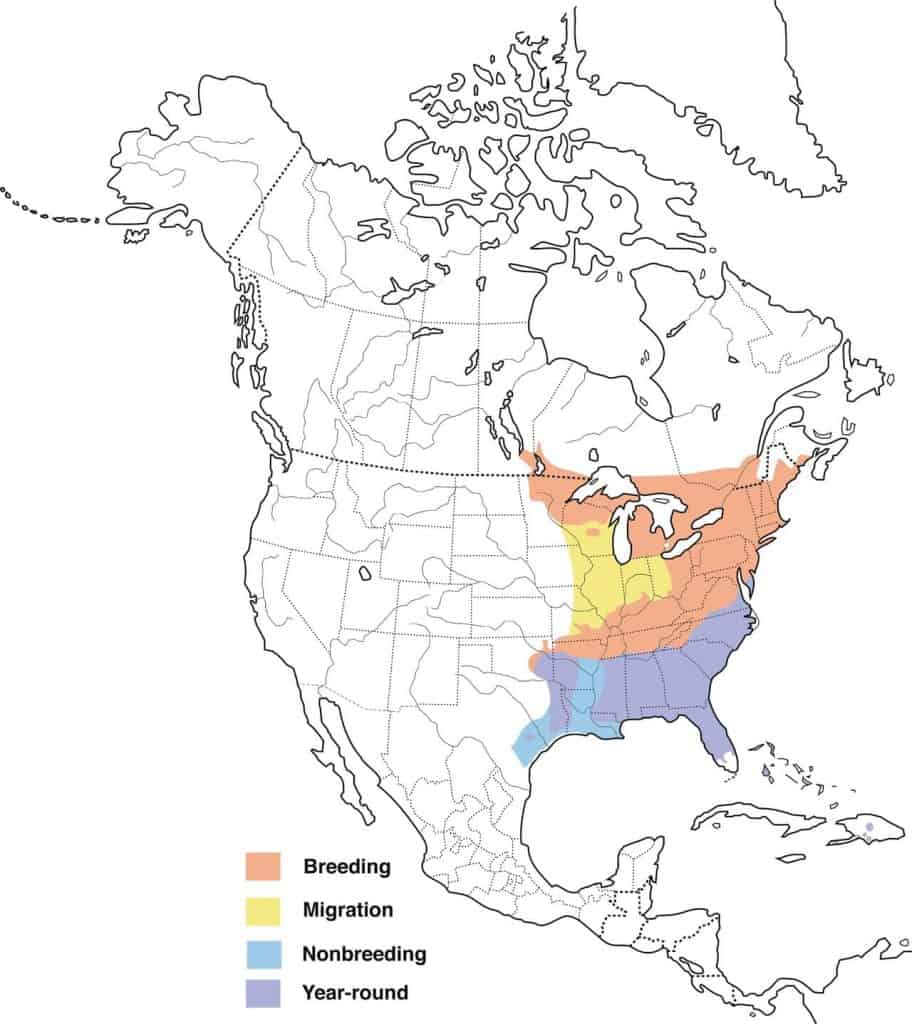
Purple Finch
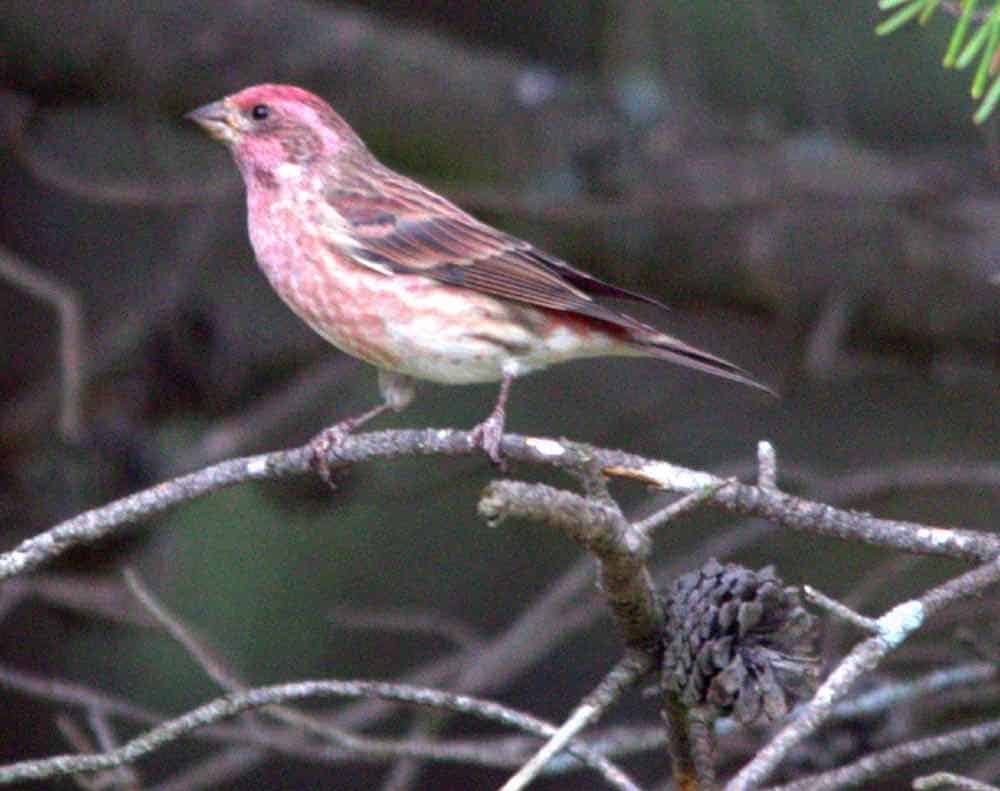
Purple finches are common backyard bird species in their range.
Appearance: Small bird about 6″ long with a raspberry-red head with lighter shades on the breast, back, and rump. The wings and tail are brown. Females are brown with brown striped breasts and white streaks across their eyes.
Diet: Seeds, insects, and fruit.
Feeder food: Black oil sunflower seeds are their favorite.
Habitat: Prefer coniferous forests in summer along with mixed forests near streams and tree-lined backyards.
Nesting: Purple finches’ nests are found anywhere from 2-60′ off the ground on a tree branch and constructed from twigs, sticks, and plant roots. Lined with grass and hair.
Migration: Purple finches are migrators. While many of them remain in their year-round range, others migrate north in the spring to breed and raise young. Then in the fall, the migrators head south for the winter.
Year-round range: The Pacific coast of Washington, Oregon, and California, and Canada’s British Columbia.
Breeding range: Just east of the year-round range along the Pacific northwest states and Canada’s provinces except for Nunavut.
Winter range: The eastern half of the US (except New England) and southern Arizona.
Range Map
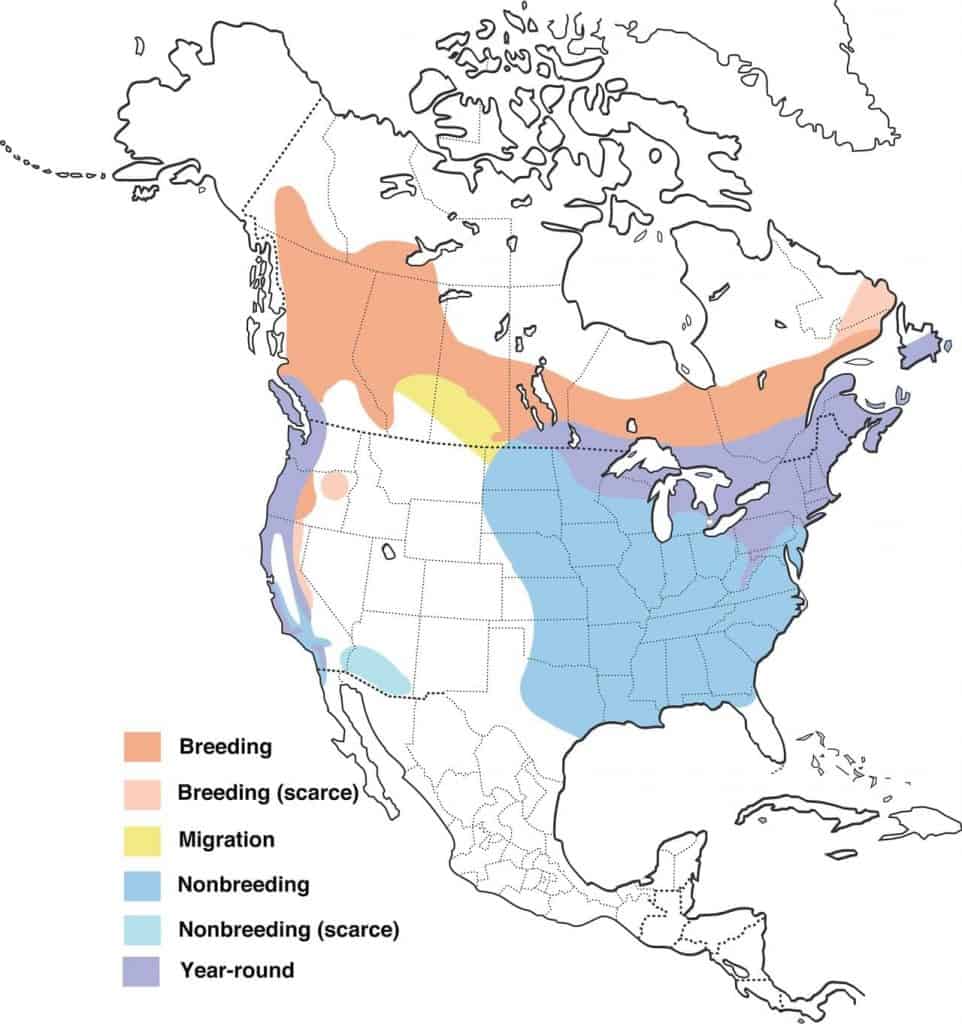
Red Crossbill
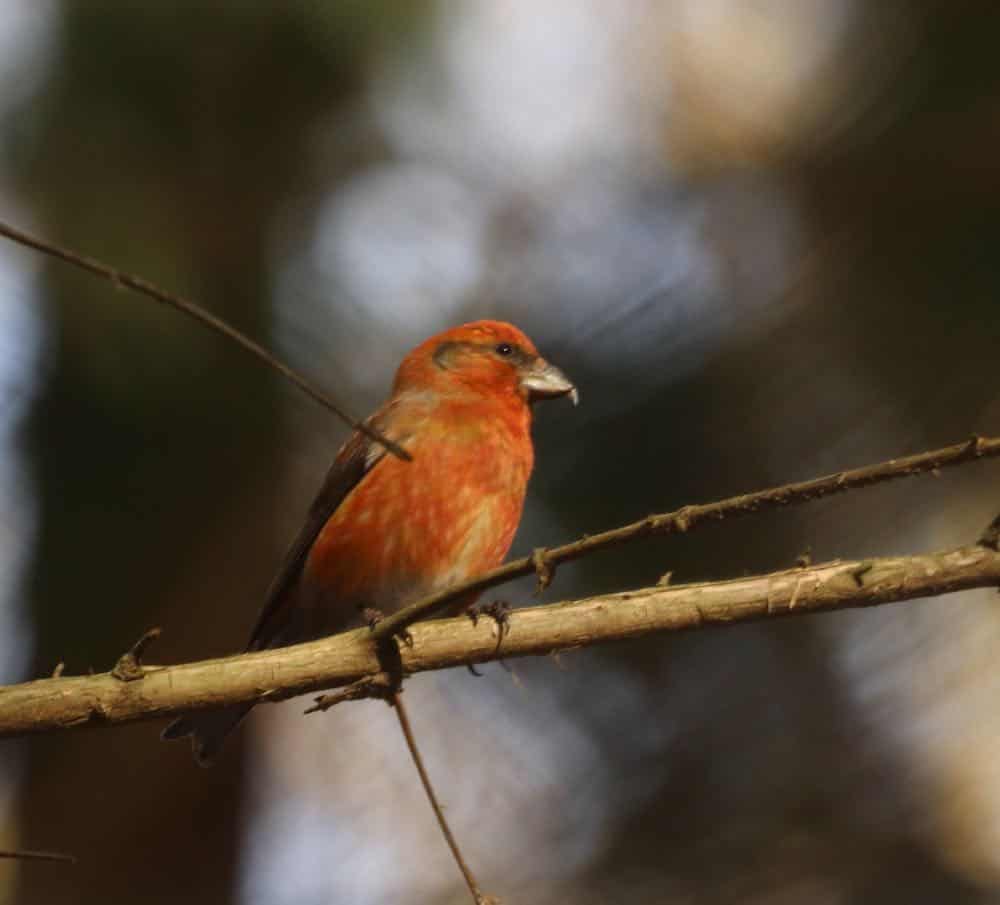
Red crossbills are common backyard bird species.
Appearance: The red crossbill is a small bird about 6.2″ long, dark red-orange with brown singes and tail. Their bill is long, pointed, and “crossed”. A brighter color of red on the head and rump. No crown. The female and young are pale yellow and gray.
Diet: Seeds – especially those inside pinecones. The bird’s “crossbill” is designed to pry open pinecones to get at the seed inside.
Feeder food: Black oil sunflower seed.
Habitat: Red crossbills either remain in their year-round territory for winter or expand south to create a wide winter range that includes Canada, the Pacific Northwest, states west of the Great Plains, Minnesota, Wisconsin, Michigan, New York, Vermont, Connecticut, and Massachusettes. They prefer mature coniferous forests.
Migration: While many red crossbills remain in their year-round range all seasons of the year, many migrate south for the winter.
Year-round range: The western half of the US, Mexico, and all Canadian provinces except Nunavut.
Winter range: Primarily northern Nevada, eastern Montana, North Dakota, South Dakota, northern Kansas, southern Minnesota & Wisconsin, northern Michigan, Pennsylvania, and New England. To a lesser degree, the remaining southern US states.
Range Map
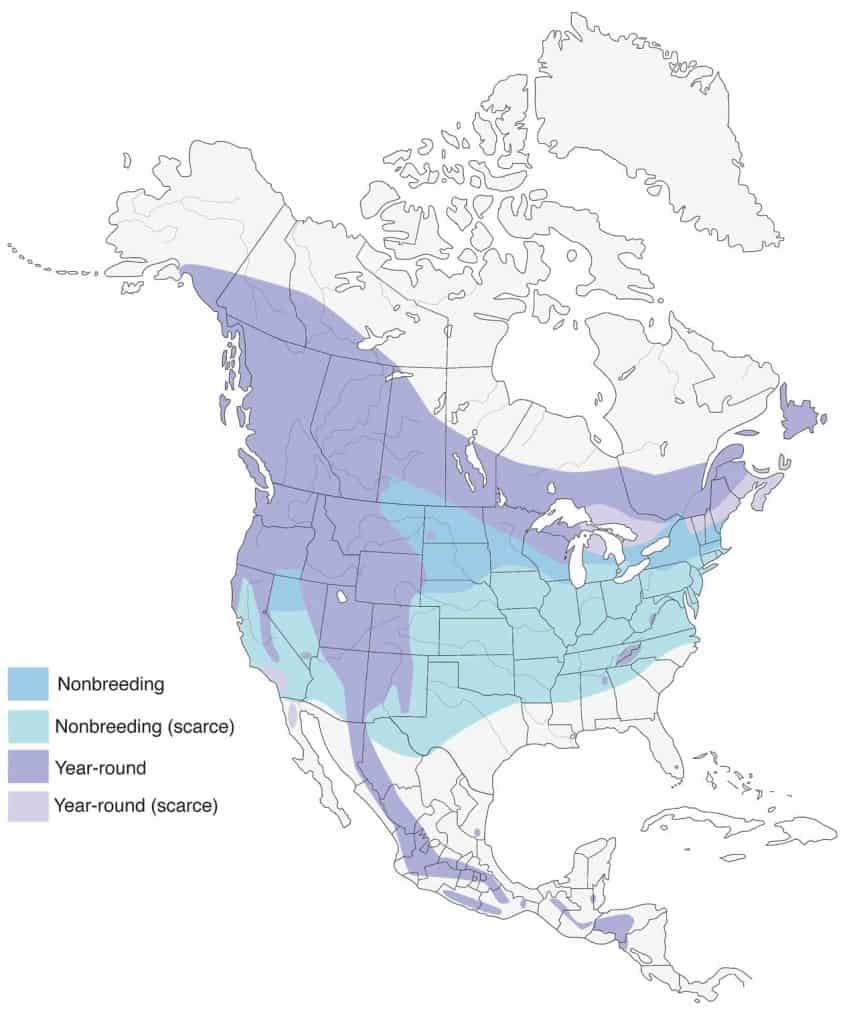
Red-bellied Woodpecker
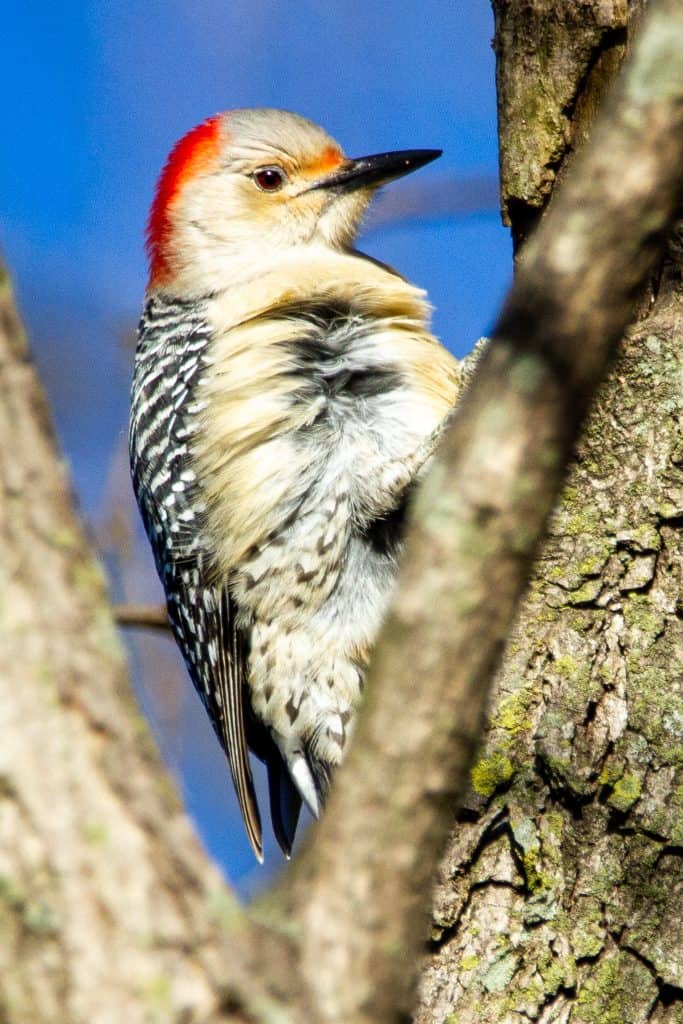
Red-bellied woodpeckers are common backyard bird species throughout the eastern half of the U.S.
Appearance: The red-bellied woodpecker is a medium-sized bird about 9 1/4″ long. They have a zebra-like striped back with a white rump. The red crown extends down the nape of the neck. The chest is tan with just a tinge of red on the belly. The females are the same except they don’t have a red crown.
Diet: Insects, nuts, fruit.
Feeder food: Suet, hulled peanuts.
Habitat: In or near forests and woodlands.
Nesting: Red-bellied woodpeckers are cavity nesters and prefer dead trees or fence posts. They have 1-3 broods/year and 2-6 eggs/brood. Eggs are white without markings. Incubation is 12-14 days.
Migration: Red-bellied woodpeckers are not migrators. They remain in their year-round range all seasons of the year.
Year-round range: Eastern half of the US but not New England.
Range Map
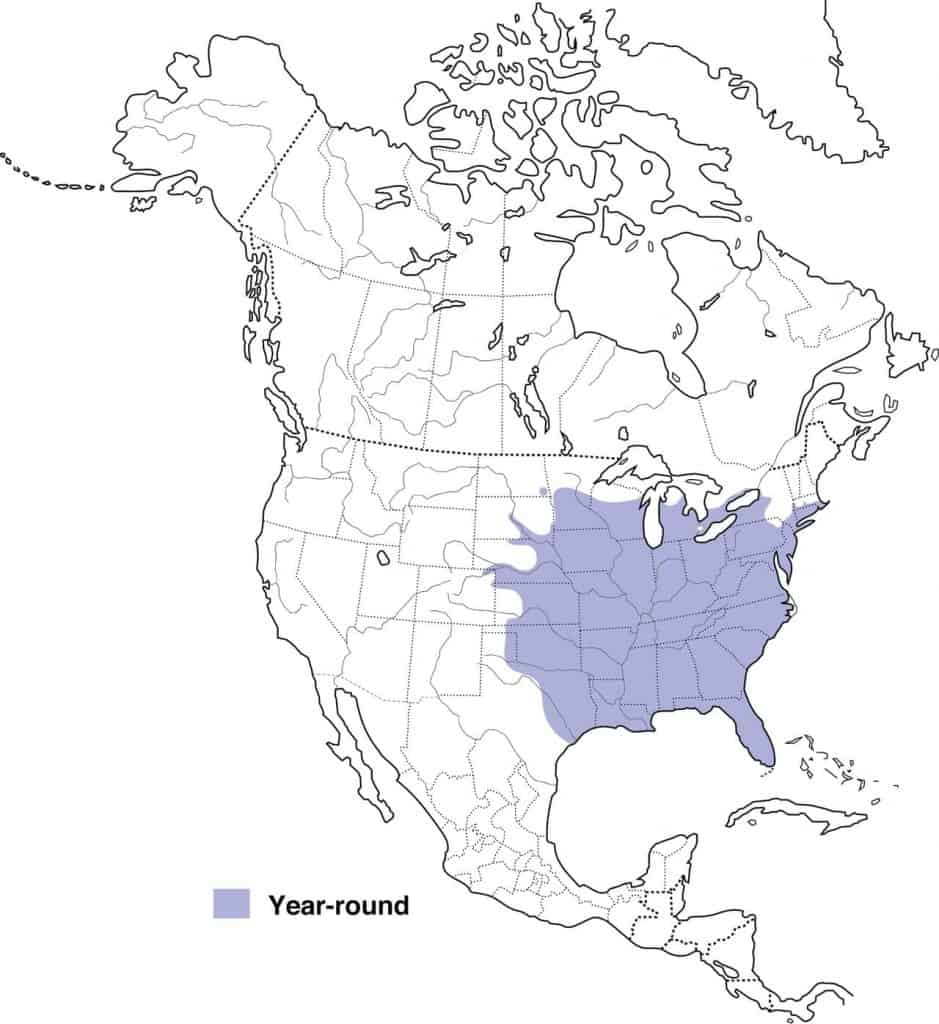
Red-breasted Nuthatch
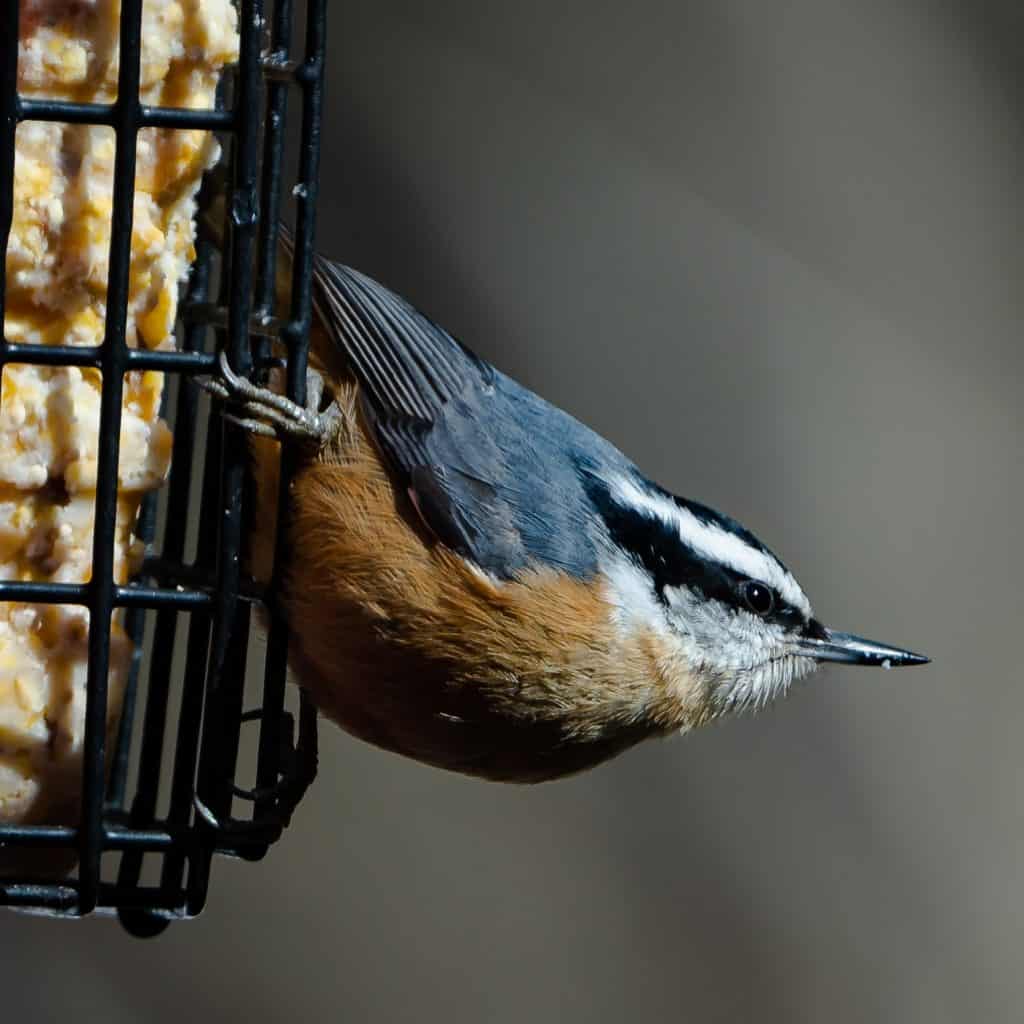
Red-breasted nuthatches are common backyard bird species.
Appearance: The red-breasted nuthatch is a small bird about 4.5″ long, with gray/blue backs, a white head with black stripes running over either eye, orange-cinnamon-colored breast, and a pointy pick-like beak. The females look the same except their underside is a more faded color. Usually spotted climbing upside-down on a deciduous tree foraging for insects beneath the bark.
Diet: Insects, spiders, and other bugs.
Feeder food: Suet, sunflower seeds, shelled peanuts, fruit.
Habitat: Forested areas primarily comprised of coniferous trees (i.e. pines). Woodsy areas of deciduous trees in the east. Southern birds prefer mountainous regions until winter comes in which case they head to lower land.
Nesting: Red-breasted nuthatches are cavity nesters and they prefer to excavate their own holes. They have 1 brood/season, and 6 eggs/brood, eggs are white & speckled with red-brown.
Migration: Red-breasted nuthatches are partial migrators. While many remain in their year-round range, others migrate south for winter.
Year-round range: Southern Alaska, states in the western third of the US, northern Minnesota & Wisconsin, Michigan, Pennsylvania, and New England as well as all Canadian provinces except Nunavut.
Winter range: US states that are not part of the year-round range.
Range Map
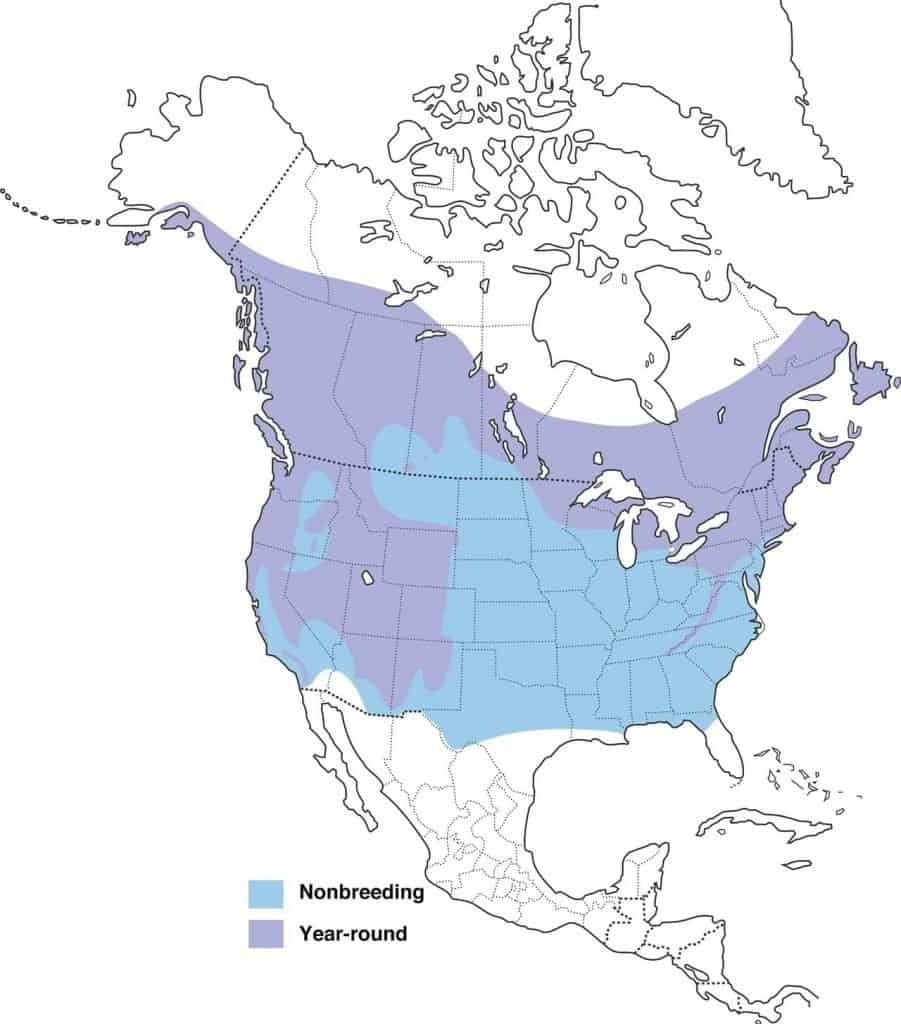
Red-winged Blackbird
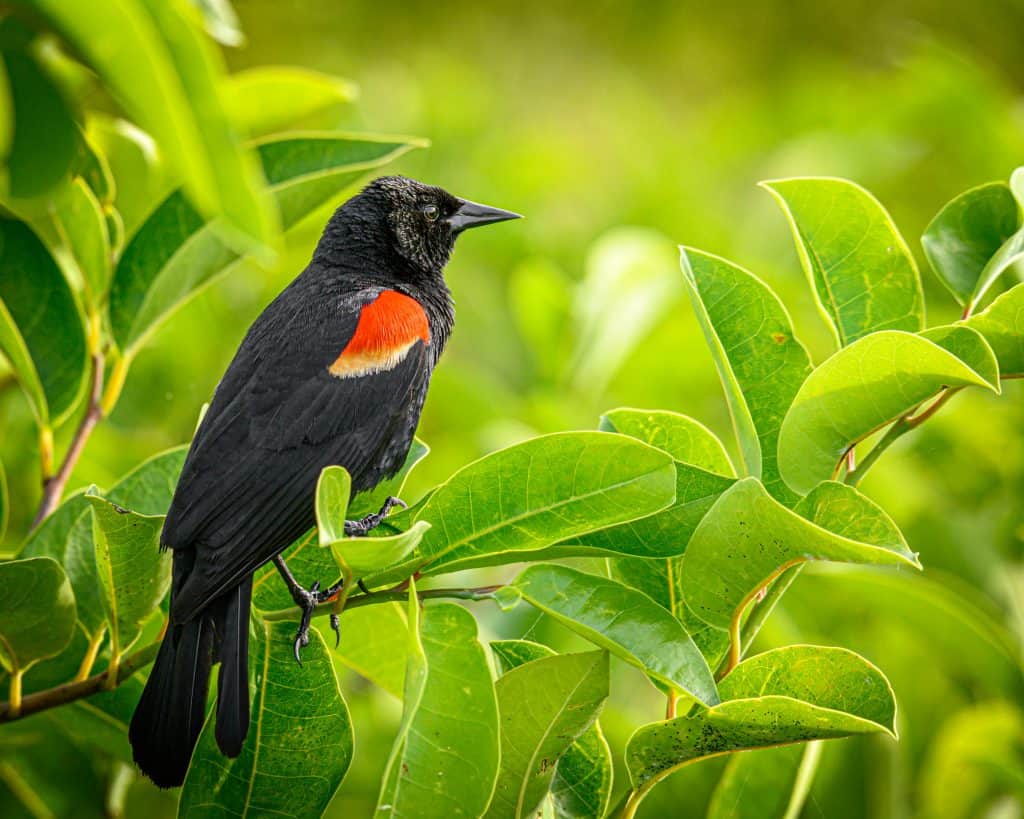
Red-winged blackbirds are common backyard bird species.
| Appearance | A medium-sized jet-black bird about 8 1/2″ long with a red and yellow patch on the shoulder of the upper wing. Pointy black bill. The females are brown and heavily streaked. She has white eyebrows and a brown bill. |
| Diet | Insects, seeds. |
| Feeder Food | Black-oil sunflower seed, hulled sunflower seeds, cracked corn, peanut hearts, millet. |
| Habitat | Wet areas like marshes but also found in meadows, fields, and even wooded edges. |
| Nesting | Nest: Cup-shaped nest located low in shrubs or trees. Broods: 1-2 broods/year Clutch: 2-4 eggs/brood Egg color: Bluish-green to gray with brown or black markings Egg size: 1″ by about .6 – .8″ Incubation: 10-12 days. |
Range Map
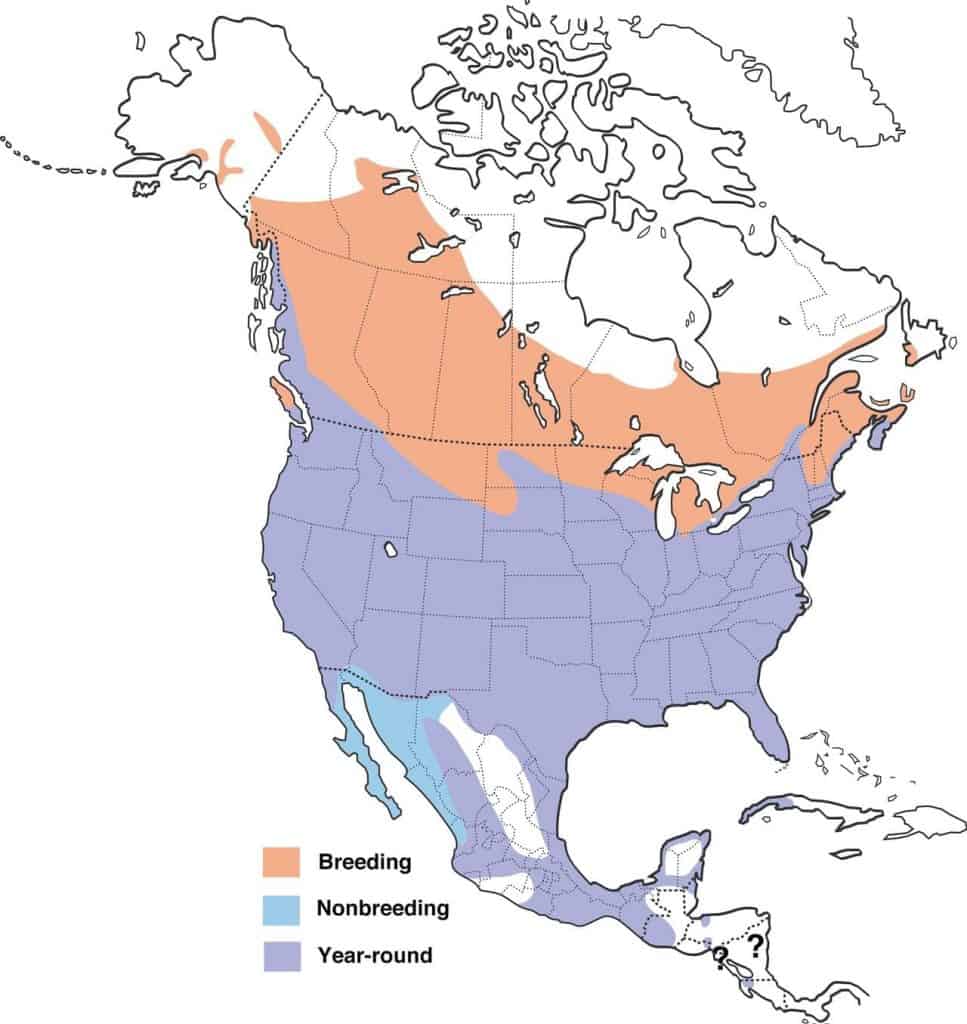
Ruby-crowned Kinglet
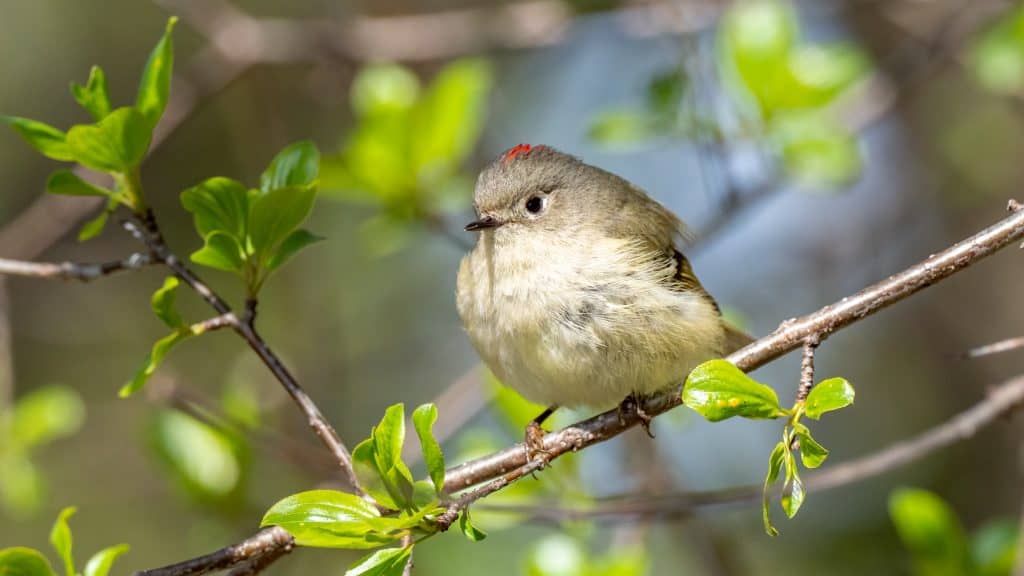
Ruby-crowned kinglets are re common backyard bird species.
| Appearance | Tiny bird about 4″ long a yellow-green color with two white wing bars and a hidden ruby-colored crown. Dark eyes with white eye-ring. Females look the same but lack the ruby crown |
| Diet | Insects, berries. |
| Feeder Food | Hulled sunflower seeds, suet, peanut hearts, and mealworms. |
| Habitat | Woodlands and forests. |
| Nesting | Nests are placed in trees near the trunk and as high as 100′. They have 1 brood/year, 4-5 white and brown spotted eggs/brood and incubate for 11-12 days. |
Range Map
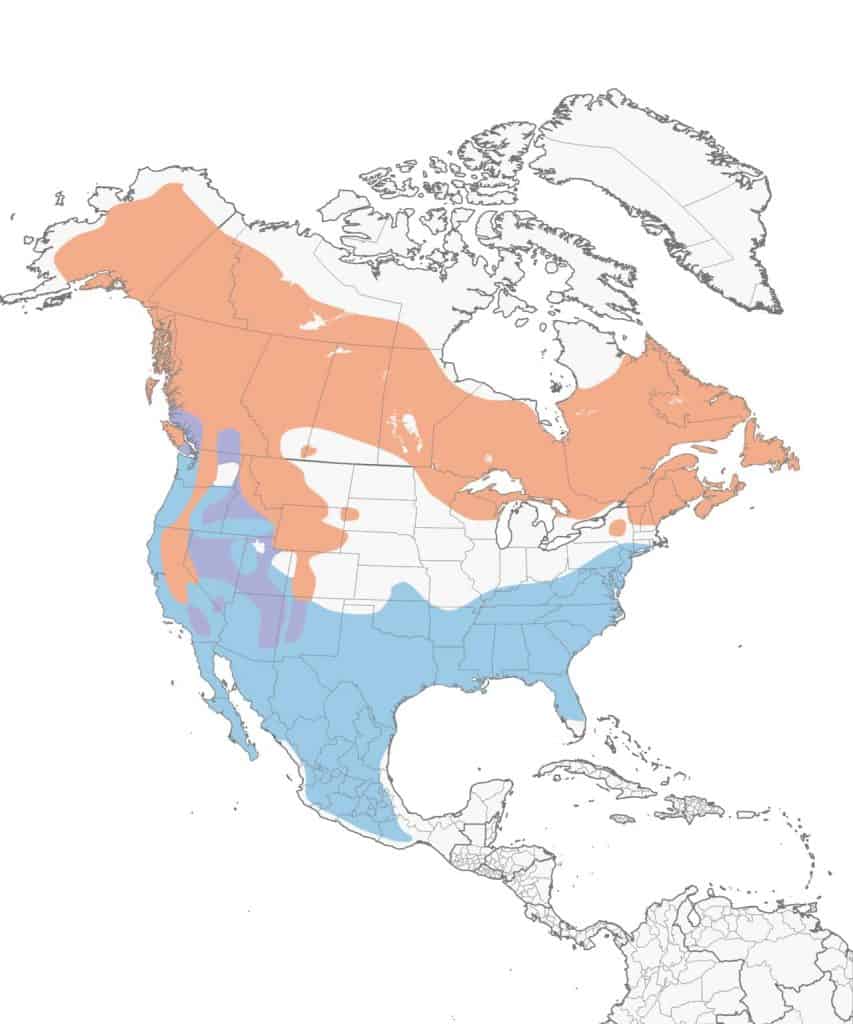
Ruffed Grouse
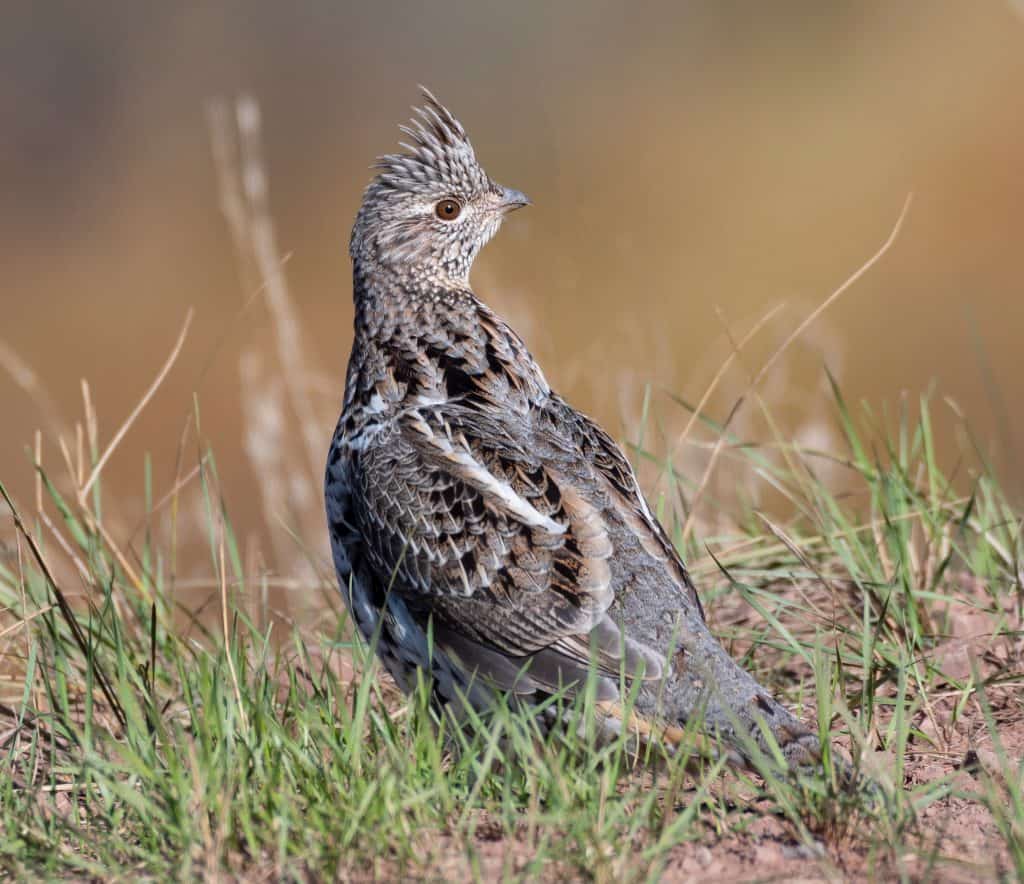
Ruffed grouse are common backyard bird species throughout Canada and parts of the U.S.
Appearance: The ruffed grouse is a medium-sized bird about 16-20″ long. They’re primarily brownish gray with a white chest/belly spotted with dark brown. They have a short crest, fanned out tail, short legs, and a short stubby beak. The females look the same.
Diet: Ruffed grouse are omnivores. They eat leaves, buds, fruits, shrubs and other vegetation. When in season, they’ll snack on fruit and acorns.
Feeder food: This bird is a ground forager that rarely visits a feeder.
Habitat: This bird prefers forested areas comprised of deciduous and coniferous trees as well as open clearings. They can commonly be found along streams.
Nesting: The ruffed grouse nest is placed on the ground and usually in a shallow depression. They have 9-14 pinky/buff eggs that are sometimes spotted brown. Incubation lasts 23-244 days. Chicks leave the nest after 24 hours as they can already move, walk, and feed themselves.
Migration: Ruffed grouse are not migrators. They remain in their year-round range all seasons of the year including Alaska, Canada, and northern U.S. states.
Range Map
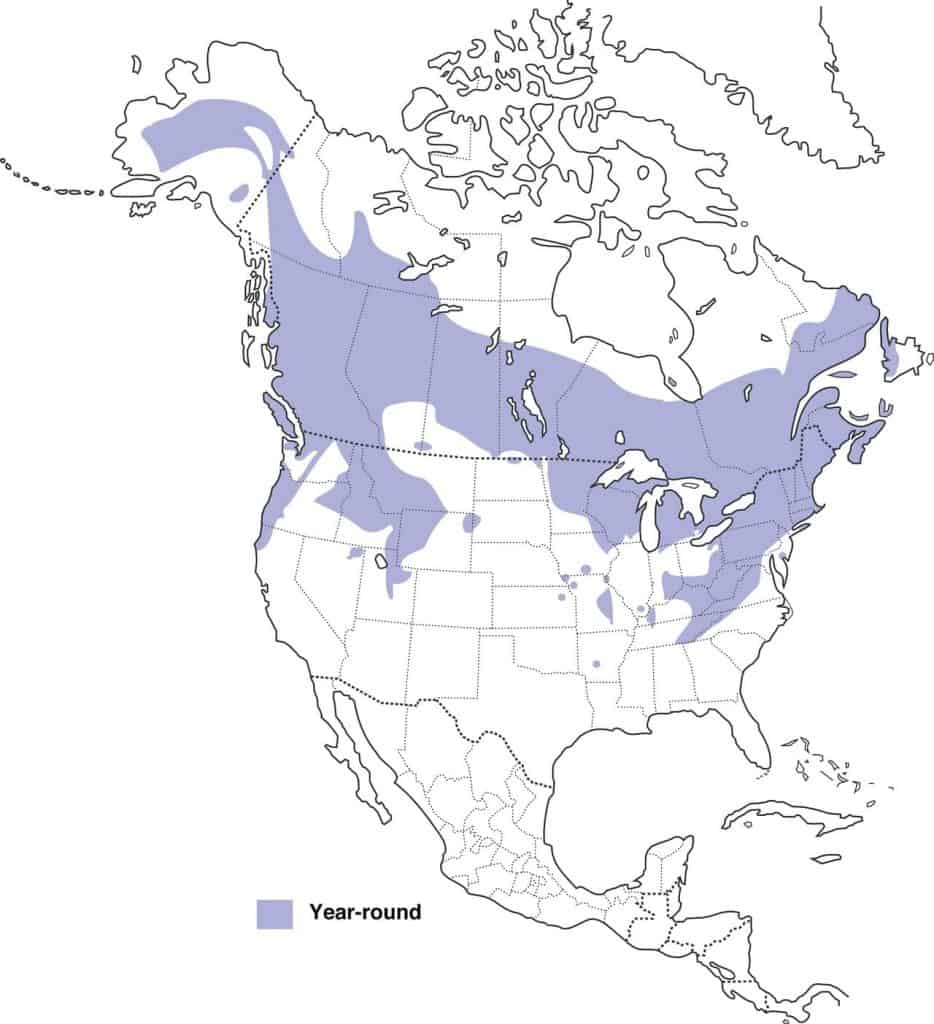
Song Sparrow
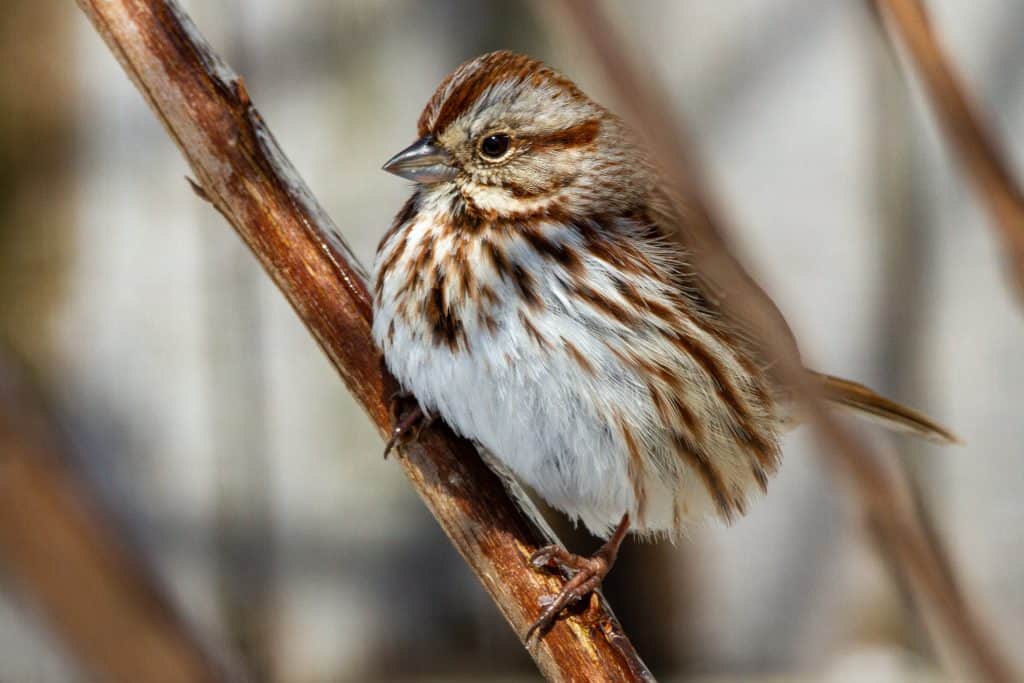
Song sparrows are common backyard bird species throughout much of North America.
| Appearance | Small bird between 5-6″ in length with a round head and varying shades of brown streaks on the chest that converge into a central dark spot. Dark brown eyes, a short stubby beak, and a long, round tail. Females appear the same. |
| Diet | Insects and seeds. |
| Feeder Food | Unlikely to visit a feeder. |
| Habitat | Open areas and edges of woodlands. |
| Nesting | Cup-shaped nest. They have 2 broods/year, and 3-4 eggs/broods, eggs are blue to green with reddish-brown marks. Incubation is 12-14 days. |
Range Map
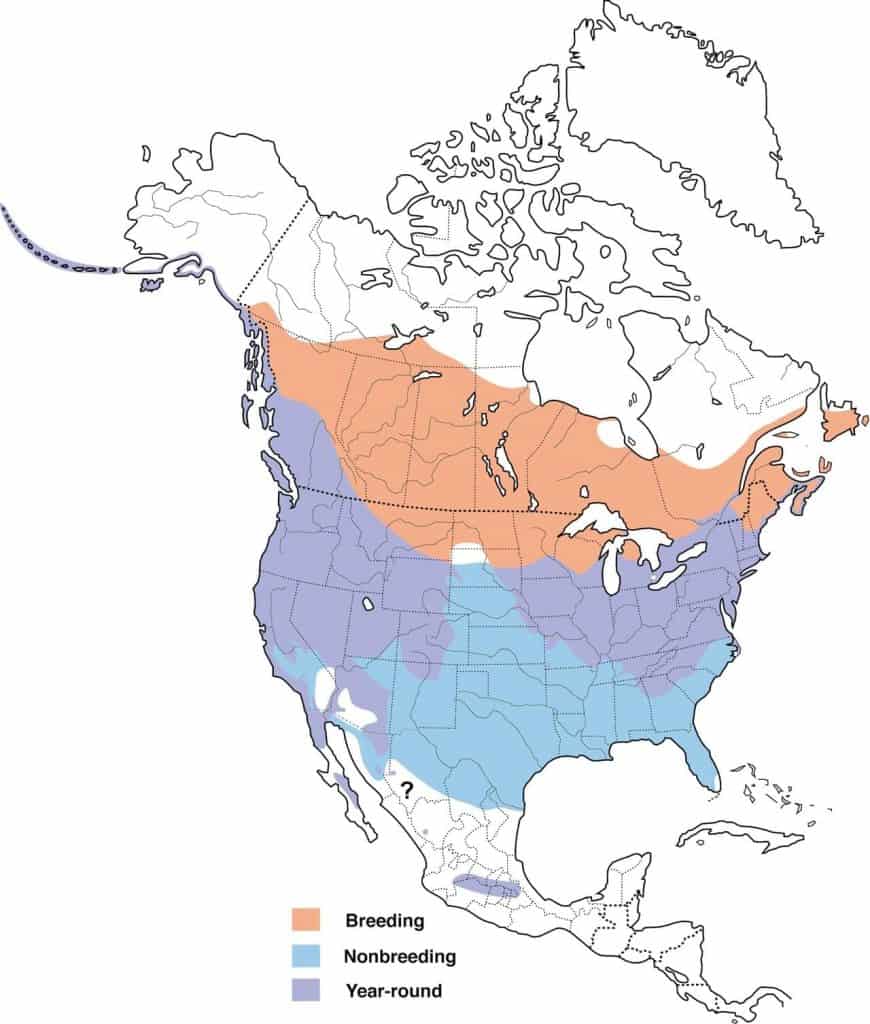
Spotted Towhee
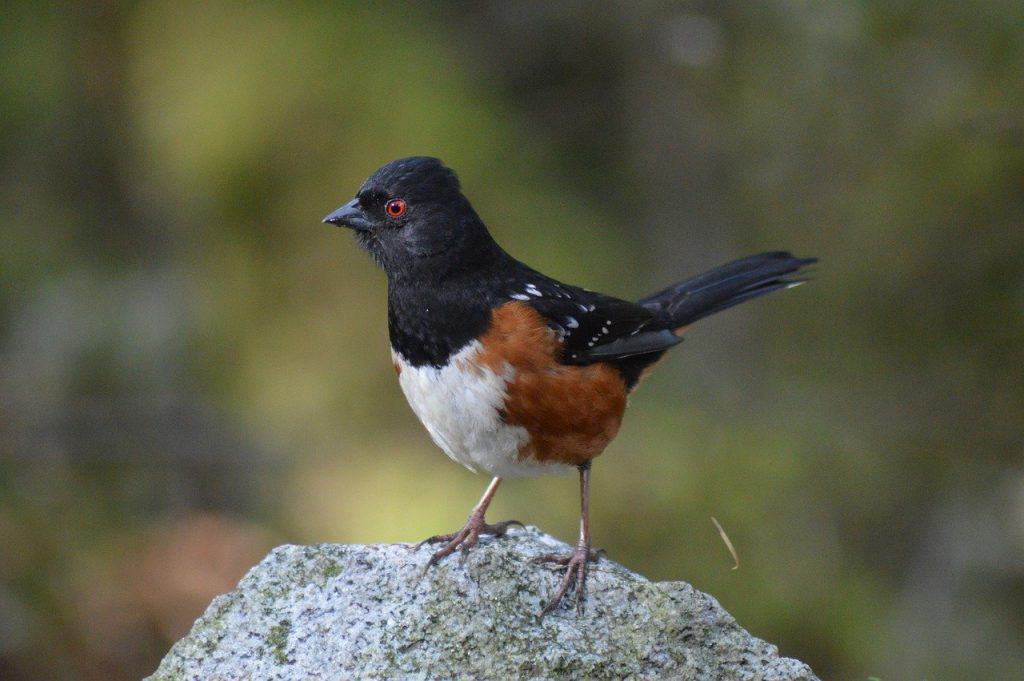
Spotted towhees are common backyard bird species within their range.
| Appearance | The spotted towhee is a medium-sized bird about 7-8″ long. They are black with a white belly and orange rust on the sides of their belly. The wings are black with white spots. The female is similar except she’s a deep brown rather than black. |
| Diet | Insects, nuts, berries, and seeds. |
| Feeder Food | Small sunflower seeds on the ground. |
| Habitat | Open areas, that are shrubby and thick with vegetation, as well as wooded edges. |
| Nesting | The nest is placed on the ground or within a low-growing shrub, generally concealed with grass or other natural vegetation. They have 1-3 broods/season and 2-6 eggs/brood that is white, gray, green, or pink with speckles. Incubation is for 12-13 days. Juveniles fledge at about 10-12 days. |
Range Map
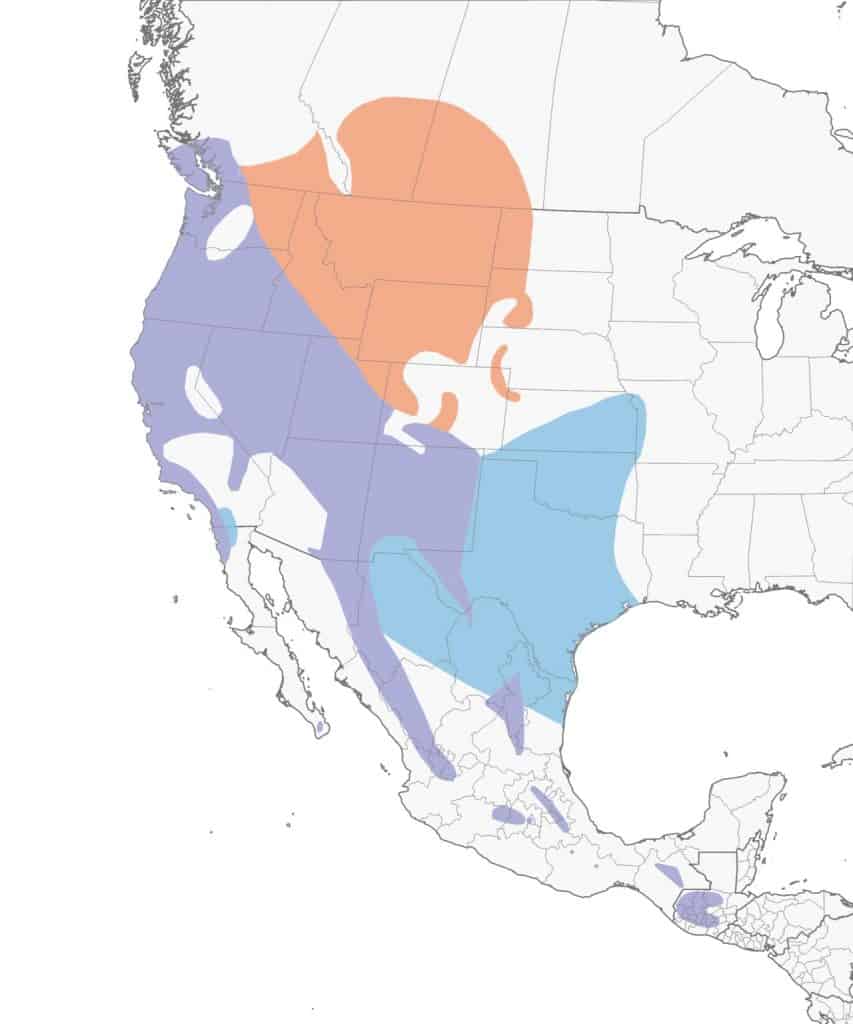
Steller’s Jay
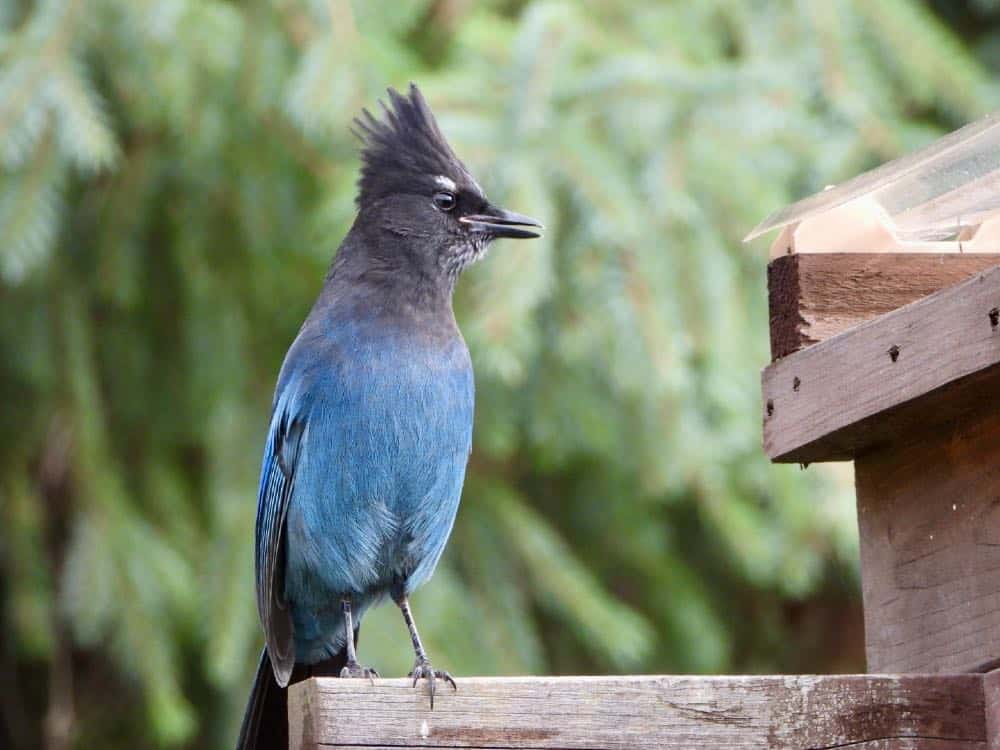
Stellar’s jays are common backyard bird species.
| Appearance | Large bird 11.5″ long, dark blue body and crest, black head and crest with spots of blue. Females are similar. |
| Diet | Nuts, seeds, fruits, insects, other birds’ eggs and nestlings, and small animals. |
| Feeder Food | Whole peanuts, sunflower seeds, and suet. |
| Habitat | Typically found in forested areas of mixed tree types – coniferous and deciduous. |
| Nesting | Large open-cup nest of twigs, bark, and mud located high in a conifer tree. 1 brood/season, 4-5 eggs/brood, eggs are blue/green with dark brown/purple/olive spots, 16-18 days incubation, and the young fledge at about 16-18 days. |
Range Map
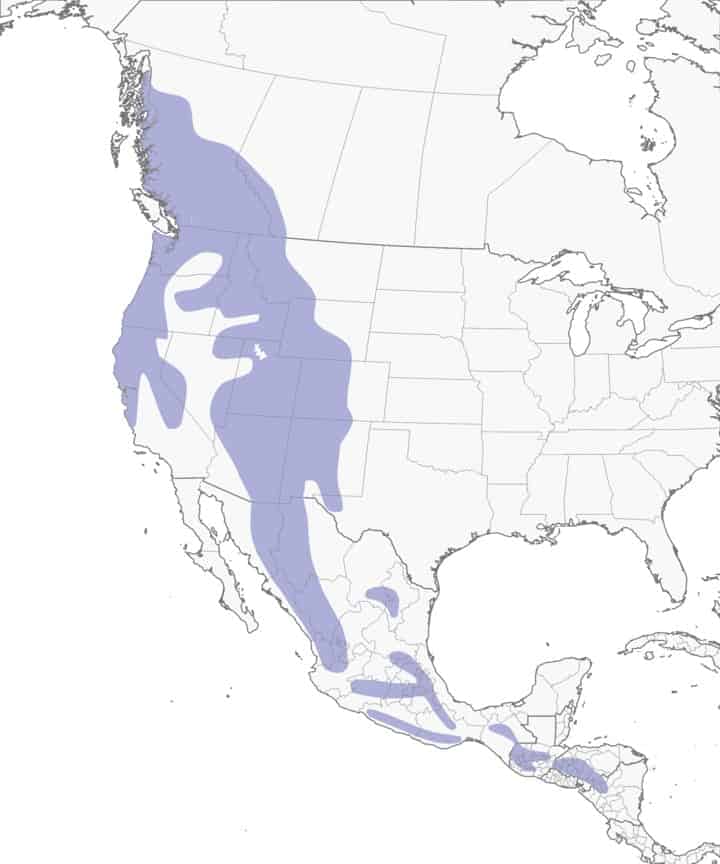
Tufted Titmouse
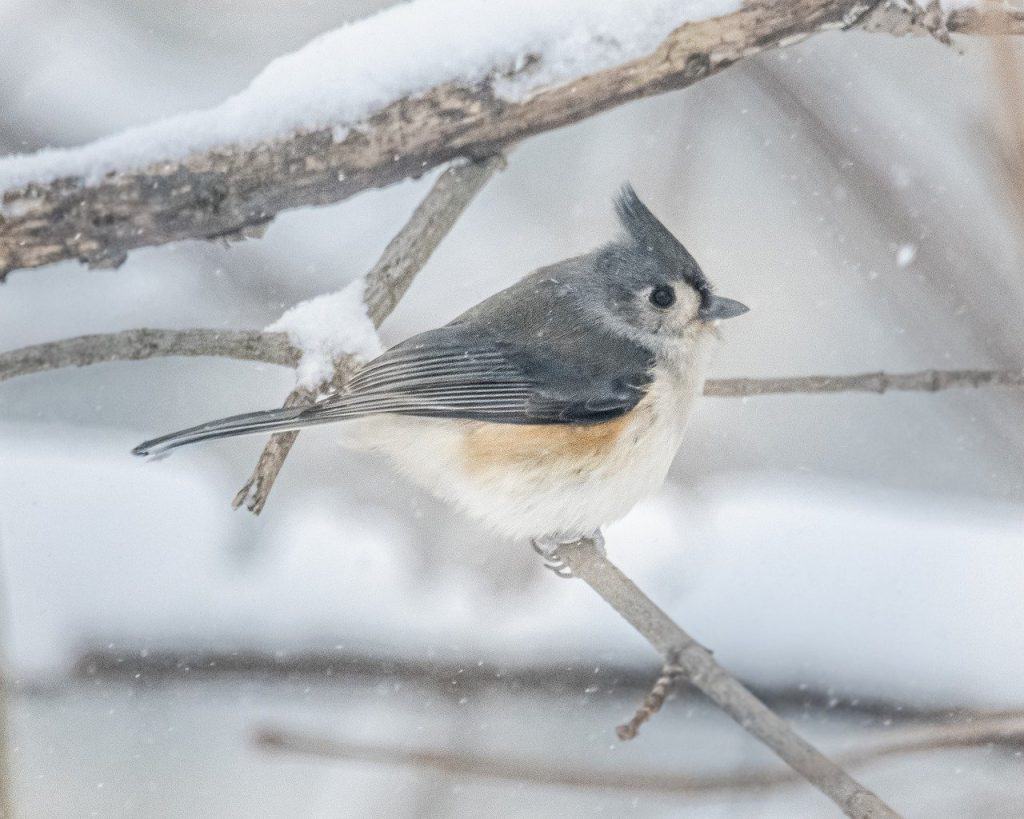
Tufted titmice are common backyard bird species in the eastern half of the U.S.
| Appearance | Small bird about 6″ long with slate gray above and white chest, belly & around the eyes. Rusty brown is below the wings, legs are gray and eyes are dark. Has a pointed “tuft” crest. |
| Diet | Insects, seeds, fruit. |
| Feeder Food | Suet. |
| Habitat | Orchards are a draw for them as they consume fruit. They also live in deciduous wooded areas or mixed woods. |
| Nesting | They build a nest within a cavity – usually an old woodpecker hole. They have 2 broods/year and 5-7 eggs/brood that are white with brown markings. Incubation lasts 13-14 days. |
Range Map

Varied Thrush
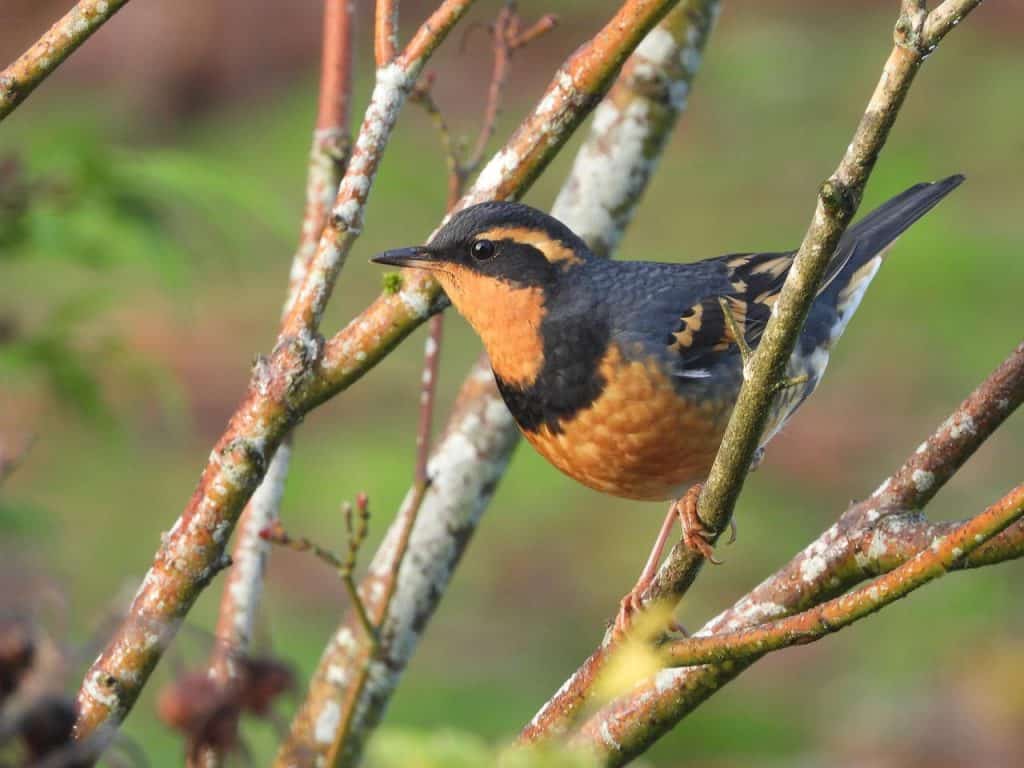
Varied thrush are common backyard bird species in the Pacific northwest.
| Appearance | Varied thrushes are large birds about 9 1/2″ long. They are orange underneath except for the black band across the breast. Orange also stripes each side of the head above the eyes. Black back, head, and weaved with orange on the wings. The female is the same except brown instead of black. |
| Diet | Insects, berries, fruits, and nuts. |
| Feeder Food | May forage for food beneath a feeder. |
| Habitat | This bird prefers moist coniferous and mixed forests with a closed canopy. |
| Nesting | Nest: They nest in a conifer 4-20′ up. Females choose the location and build the nest, including layers of moss, mud, twigs, leaves, and grass. Broods: They have 12-broods/season Clutch: 1-6 eggs/brood Egg color: Pale sky blue with occasional dark-brown speckling. Egg size: 1.1 – 1.4 inches by 0.8 – 0.9 inches Incubation: 12 days. Fledglings leave the nest at about 13-15 days. |
Range Map
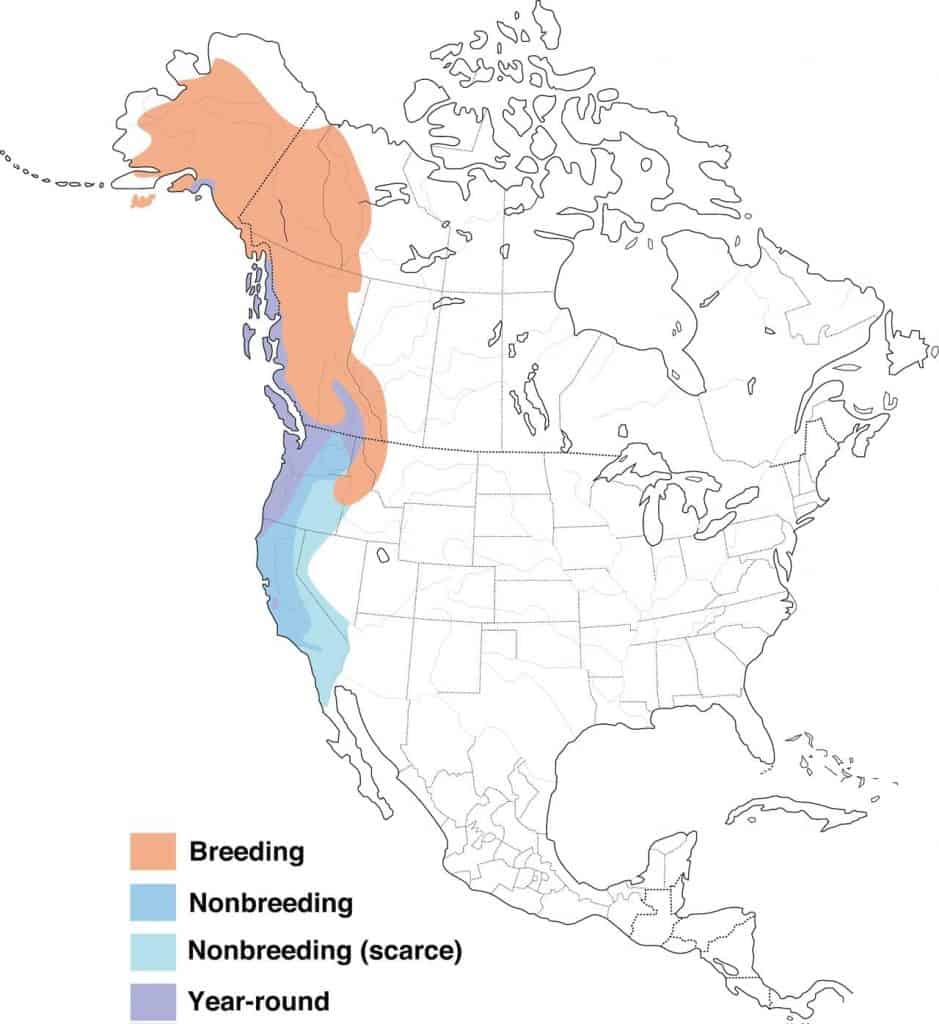
White-breasted Nuthatch
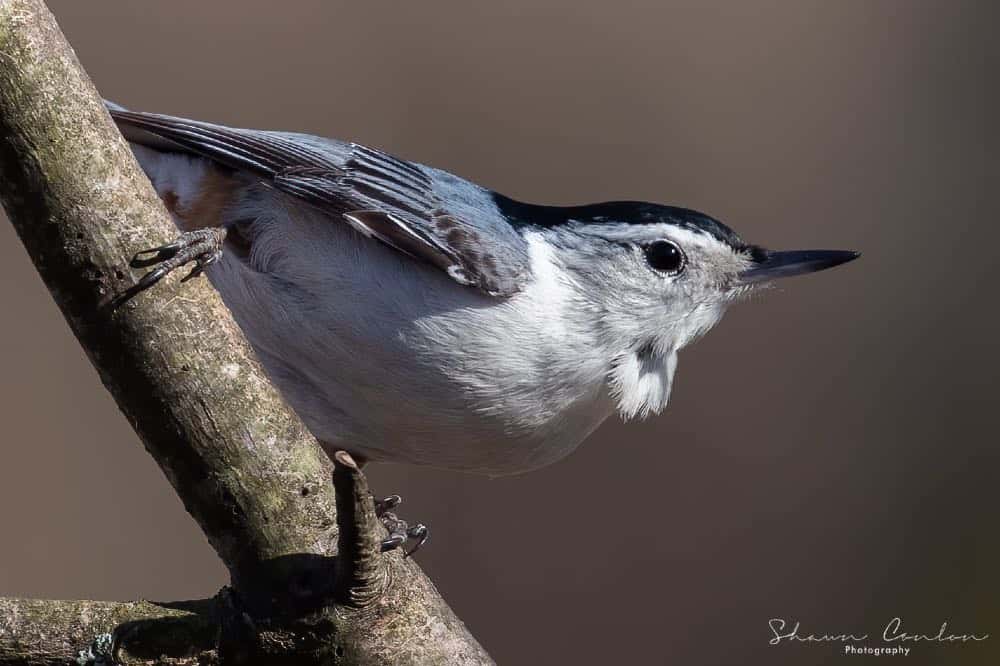
White-breasted nuthatches are common backyard bird species.
Appearance: 5-6″ long, gray/blue back, white head with a black cap, chestnut under the tail, and a long thin pick-like beak. Females look similar except their cap and neck are gray. Usually spotted climbing upside-down on a deciduous tree foraging for insects beneath the bark.
Diet: Insects & seeds.
Feeder food: Suet, sunflower seed, shelled peanuts.
Habitat: Near mature deciduous and mixed forests; wooded suburban areas such as orchards, parks, and backyards.
Nesting: White-breasted nuthatches are cavity nesters. They have 1 brood/season, 5-9 eggs/brood, eggs are white with brown markings, incubation is 11-12 days and young fledge at about 13-14 days.
Migration: White-breasted nuthatches are not migrators. They remain in their year-round range all seasons of the year. That said, a small part of the population may migrate to a strip in the southcentral US for the winter.
Year-round range: Every US state, Canada’s southern provinces, and Mexico.
Range Map
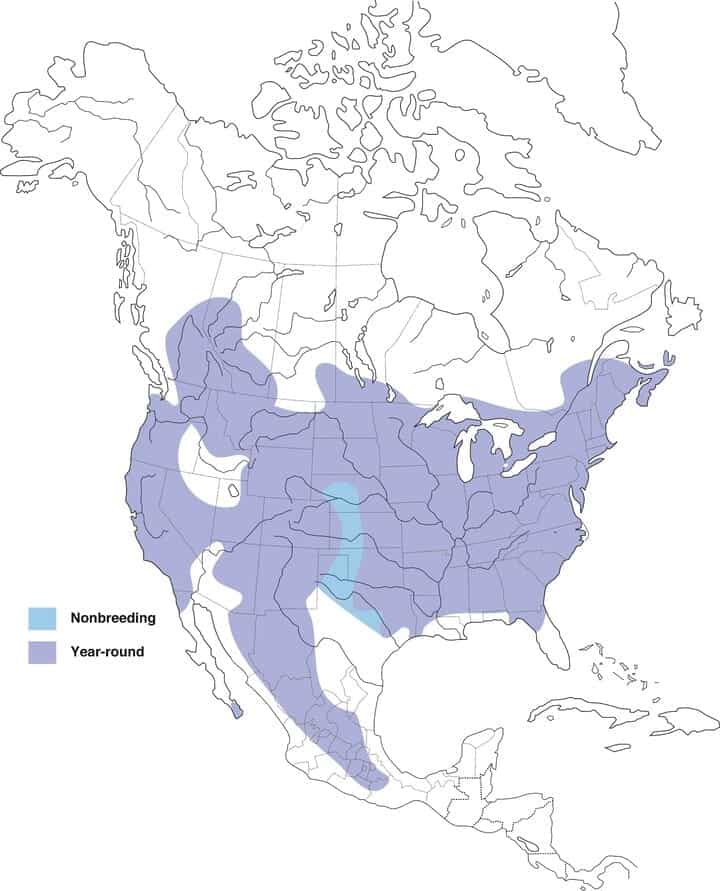
White-crowned Sparrow
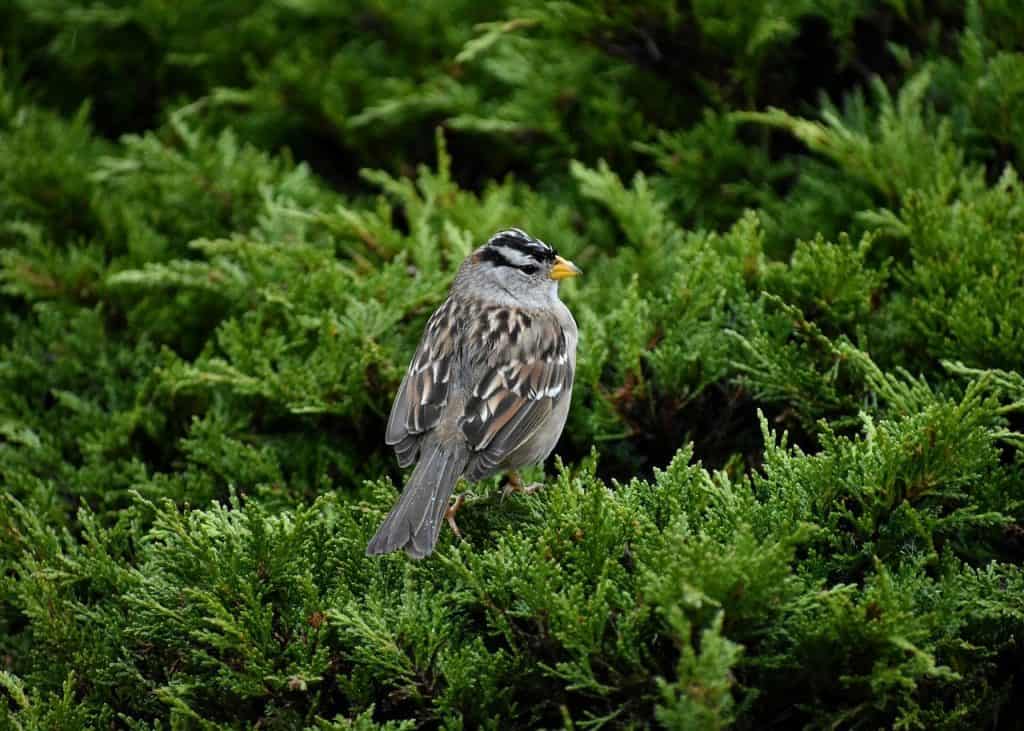
White-crowned sparrows are common backyard bird species.
| Appearance | Small bird about 7″ long. Mostly brown with a gray throat & chest, black & white striped crown, and a small thin pink bill. The female is the same. |
| Diet | Insects, seeds, berries. |
| Feeder Food | Black-oil sunflower seeds, hulled sunflower, cracked corn, millet, and milo. |
| Habitat | Open areas with shrubby thickets, open meadows, and forest edges. |
| Nesting | They have 2 broods/year, 3-7 eggs/brood that are green/blue/white with dark brown markings. Incubation lasts 11-14 days. |
Range Map
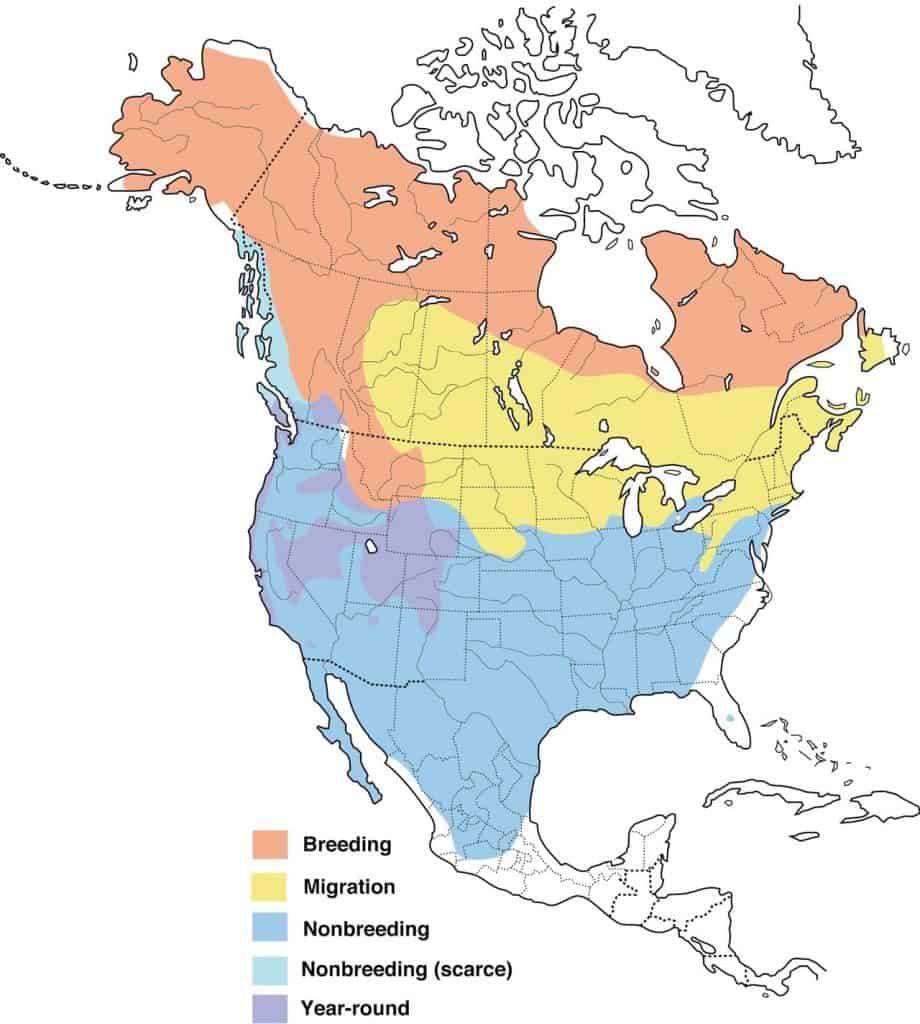
White-throated Sparrow
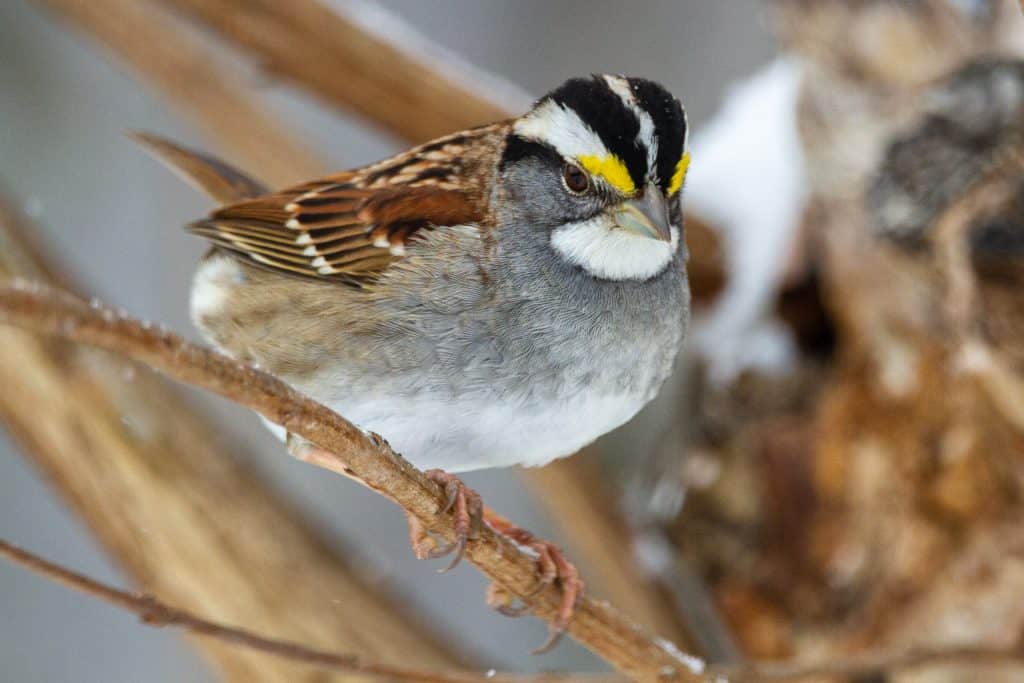
White-throated sparrows are common backyard bird species.
| Appearance | Small bird about 6-7″ long. Brown with gray chest and belly. Has a small yellow spot between its eyes (lore). A white patch on its throat and crown. They have white or tan stripes alternating with black stripes. Females and males are the same. |
| Diet | Insects, fruit, seeds. |
| Feeder Food | Millet and sunflower seeds. |
| Habitat | Forested areas of coniferous and deciduous trees. |
| Nesting | They have 1 brood/year and 4-6 eggs/brood in a cup-shaped nest. Incubation lasts 11-14 days. |
Range Map
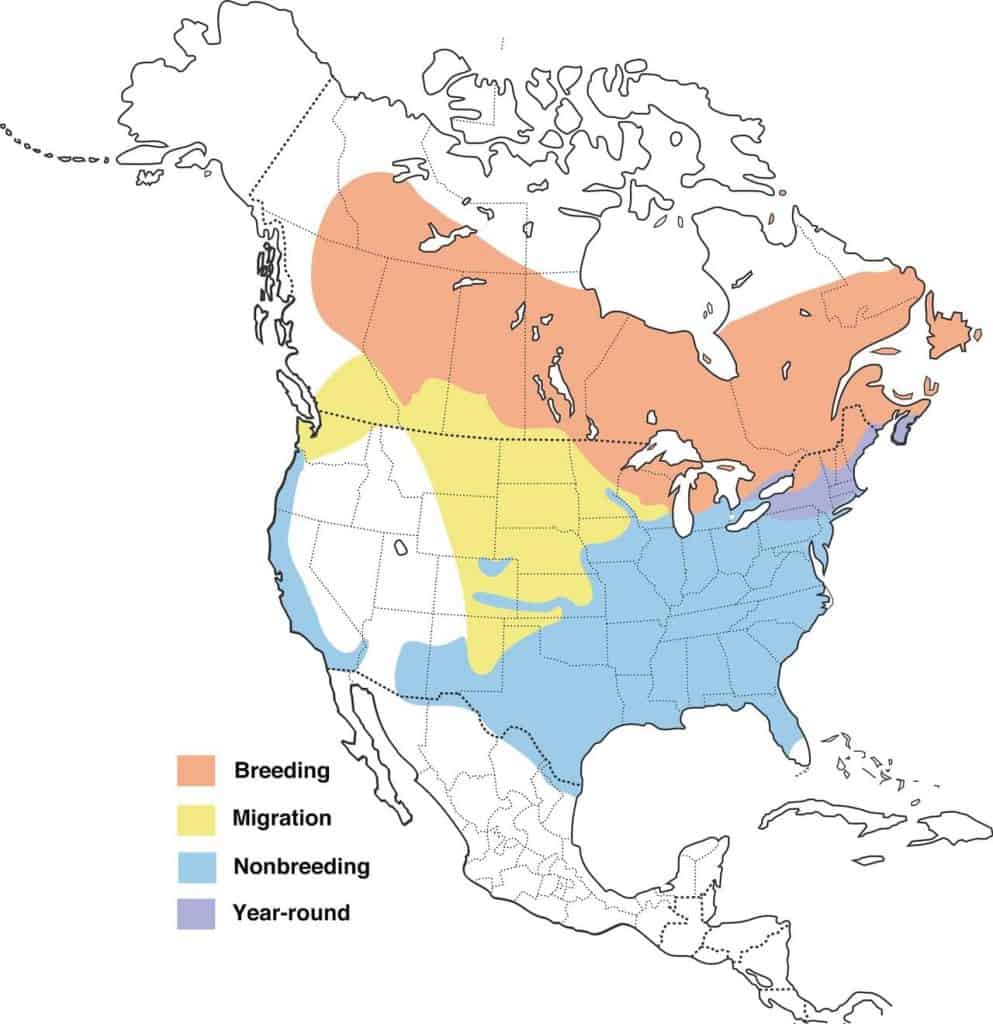
Yellow-rumped Warbler
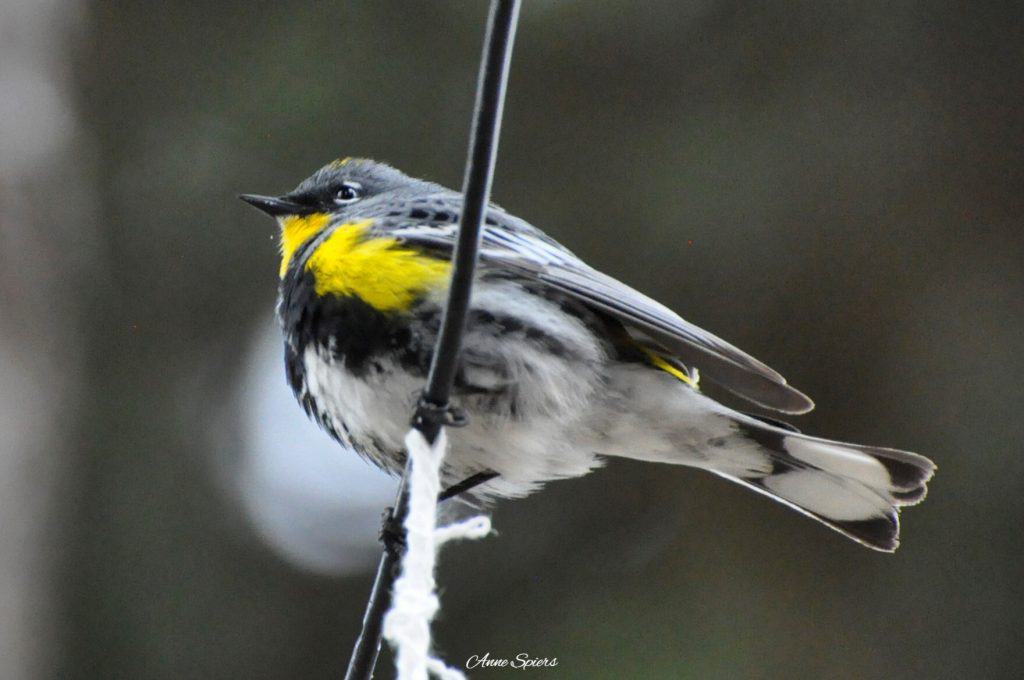
Yellow-rumped warblers are common backyard bird species.
Appearance: The male yellow-rumped warbler is slate gray with a black mask and beak. Yellow patches on the sides of its lower belly, head, and rump. White and gray striped throughout chest and belly. The female is similar but duller in color and browner than she is slate gray.
Diet: Insects, berries.
Feeder food: Peanuts, mealworms, nectar, fruit, suet with peanut butter.
Habitat: Just about anywhere as they are very adaptable. Found in woods, bogs, forest and wooded edges, coniferous and deciduous trees, and wide-open areas.
Nesting: The female builds a cup-shaped nest in a tree, has 2 broods per year, 4-5 eggs per brood, and eggs are white with brown spots and incubated between 12-13 days.
Migration: Yellow-rumped warblers are migrators. In the spring, they migrate north and west to breed and raise their young. Then in the fall, they migrate south and east for the winter. A small population of yellow-rumped warblers remains in their tiny year-round range every season of the year.
Breeding range:
Winter range: Southeast corner of Washington & Oregon, southern California, western Arizona, eastern New Mexico, Texas, Oklahoma, Missouri, Illinois, and the remaining southeast US states. Also, Mexico and Central America.
Year-round range: Western Washington, eastern Oregon, western California, southeast Nevada, southeast Arizona, and southern New Mexico.
Range Map
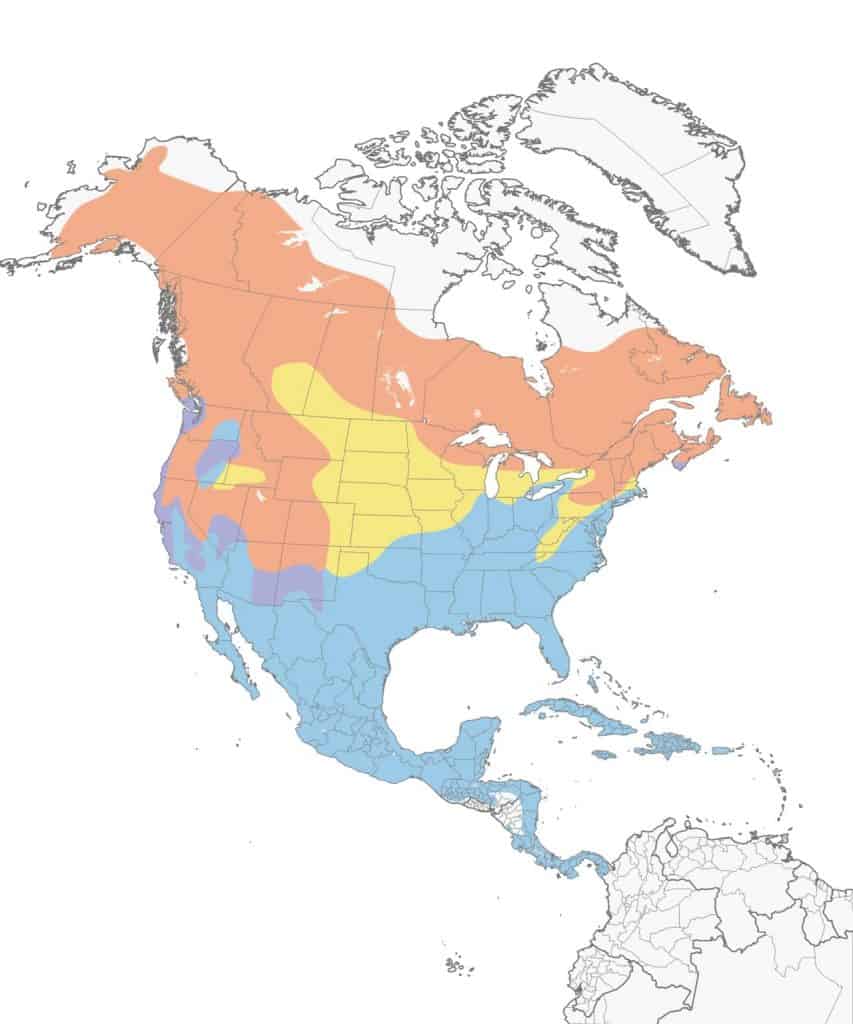
Conclusion
There are hundreds of species of wild birds throughout North American. This article reveals the 61 most common bird species found in backyards across the U.S. and Canada.
This complete guide includes photos of each species so you can easily identify the birds. There are also range maps so you know whether the species is found in your area. Each species’ favorite feeder food is included to help you entice them closer.
The information in this guide provides you with the foundation needed to become a better backyard birder. Bookmark this article for future reference.
Happy Birding!
